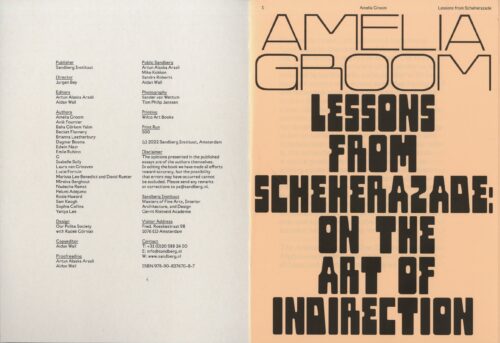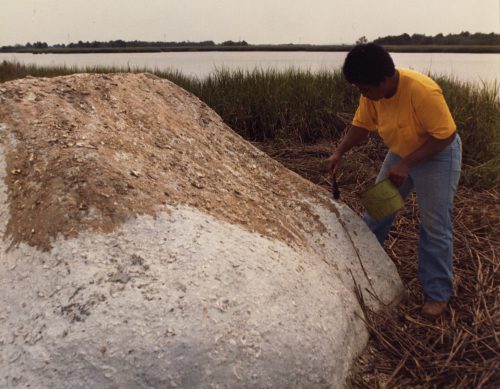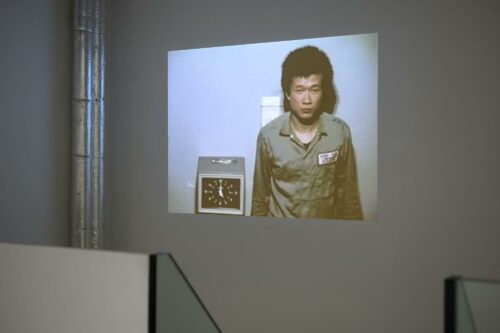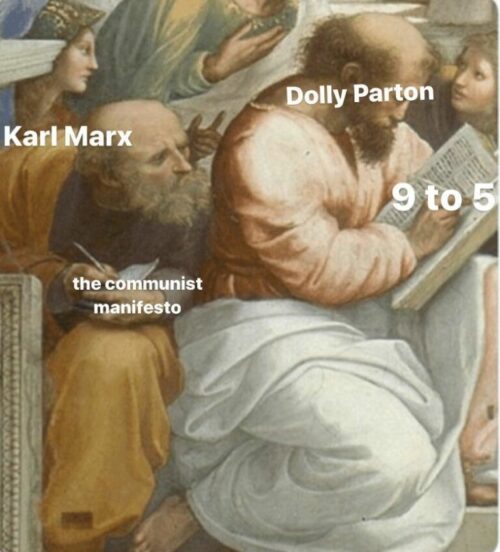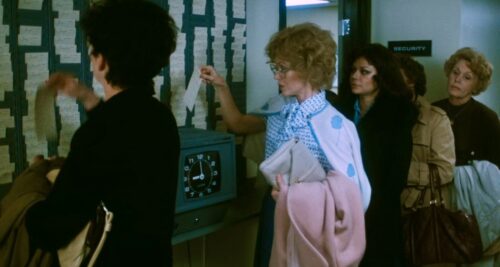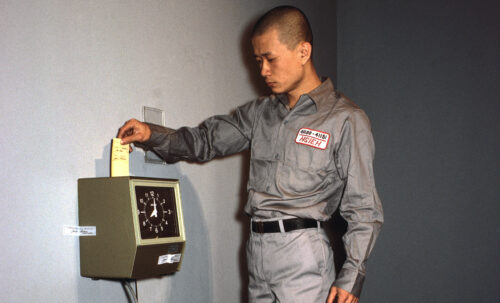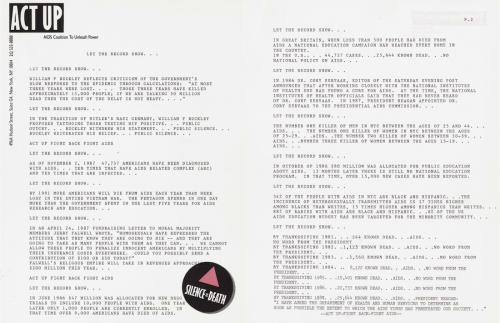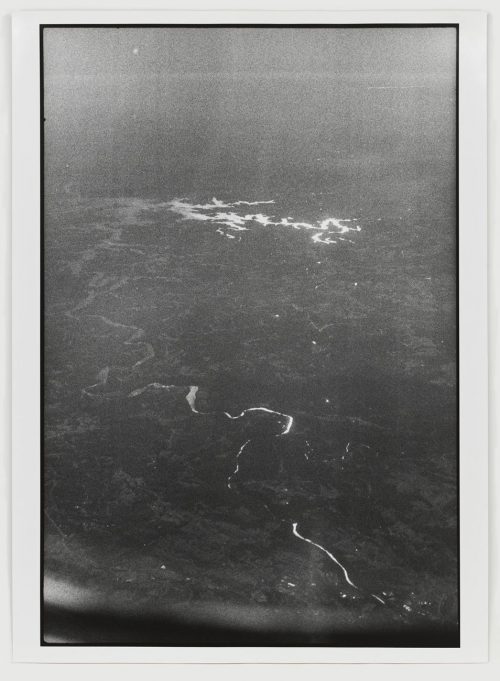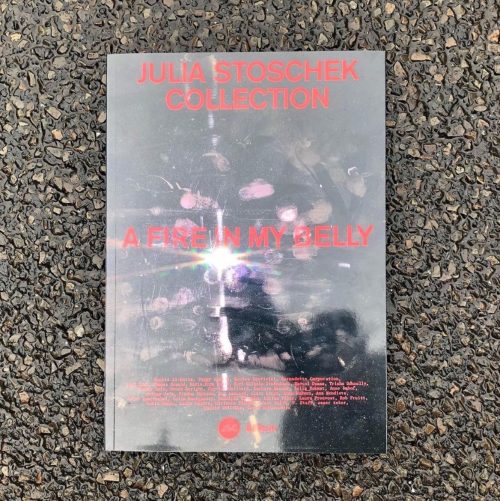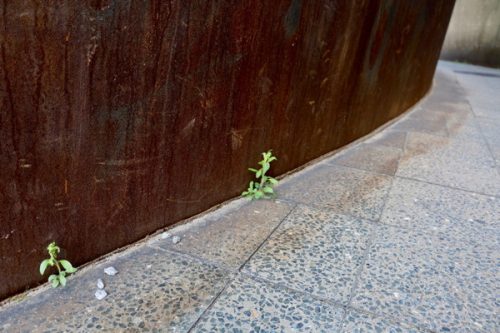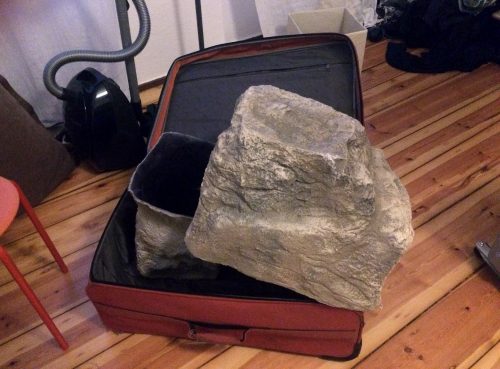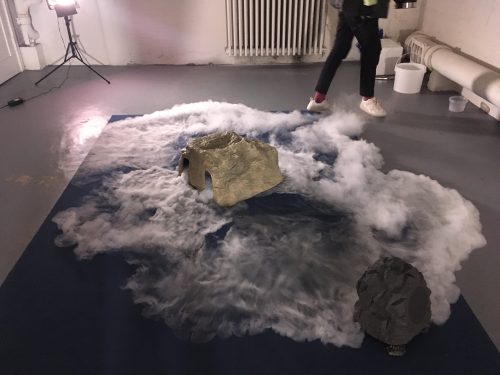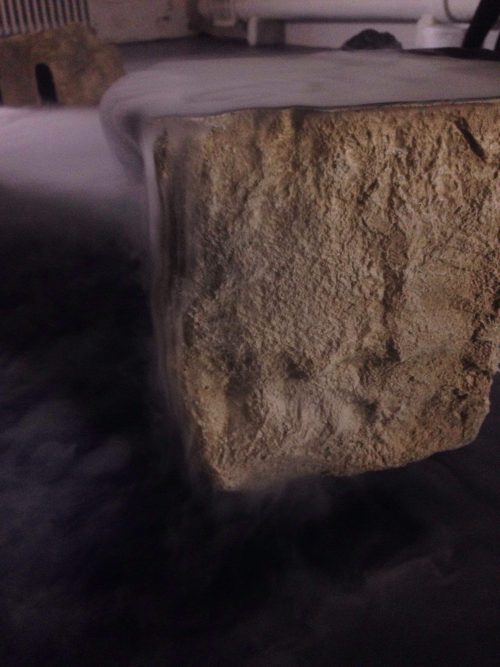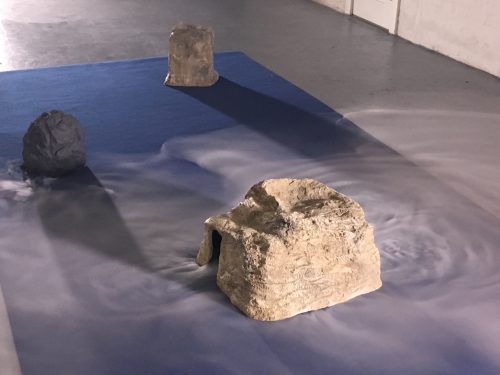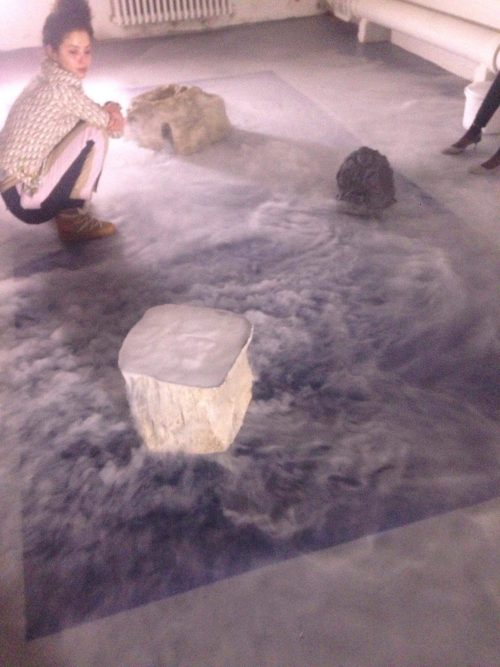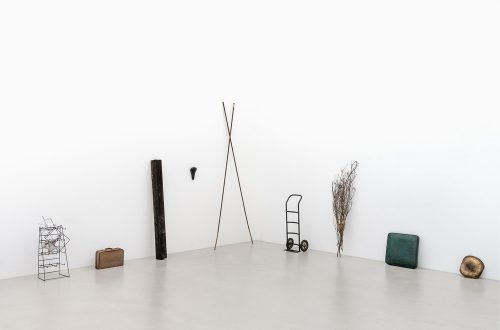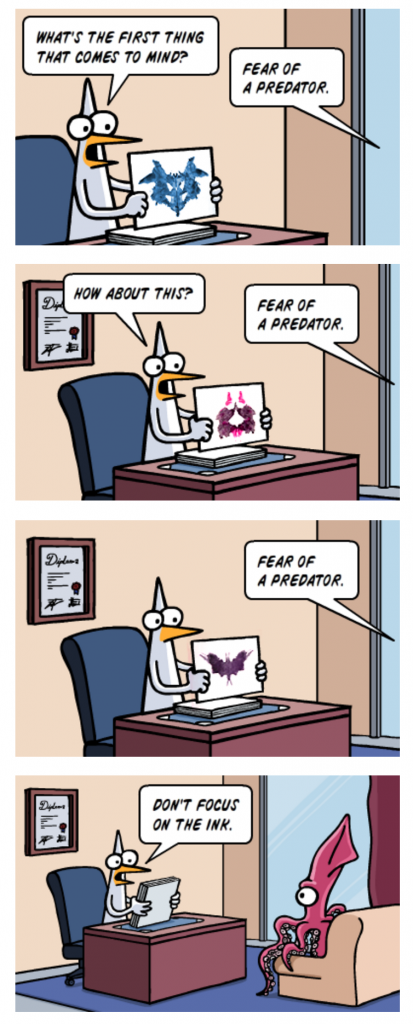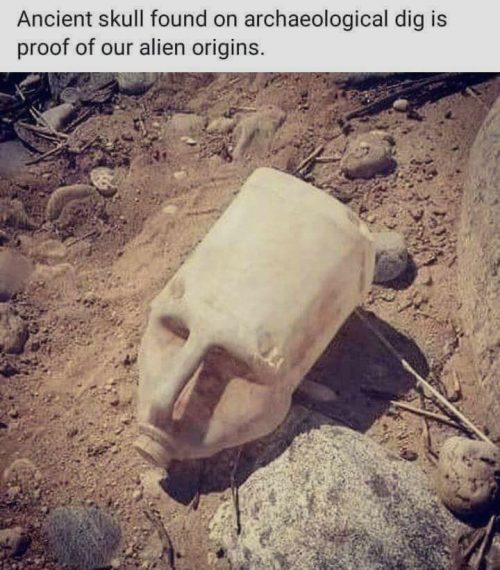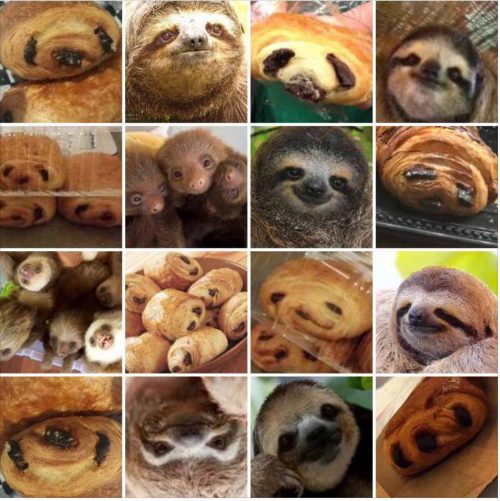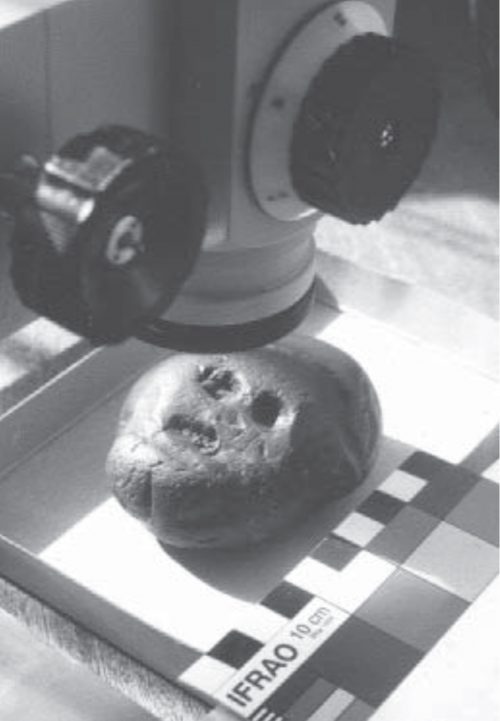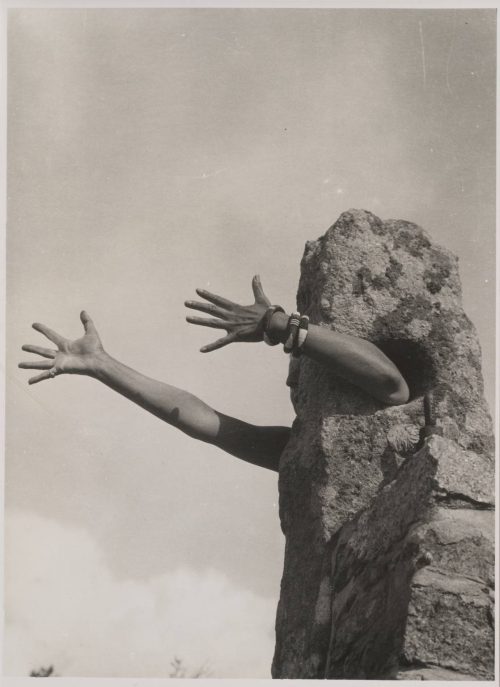‘Uncategorized’
“Raised on Foundations of Slime”
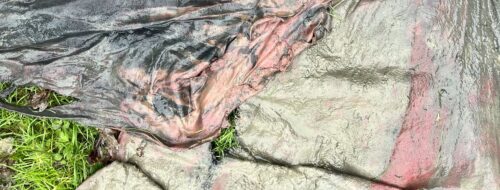 Jota Mombaça, Ghost 7(1-7): French Historical Maladie, Frac des Pays de la Loire, Nantes. Documentation of work in progress, courtesy of the artist, 2024. [ID: Colour photograph showing a close-up of some fabric that is wet with slime and mud, laid out on the grass after spending 4-5 weeks submerged in the River Loire. The grass is green and the colours of the fabric are red-pink, brown-grey, and black-charcoal, swirling together.]
Jota Mombaça, Ghost 7(1-7): French Historical Maladie, Frac des Pays de la Loire, Nantes. Documentation of work in progress, courtesy of the artist, 2024. [ID: Colour photograph showing a close-up of some fabric that is wet with slime and mud, laid out on the grass after spending 4-5 weeks submerged in the River Loire. The grass is green and the colours of the fabric are red-pink, brown-grey, and black-charcoal, swirling together.]
🎶 An audio version of this text can be found > here <
DRY LANDS
On a recent flight to Amsterdam, I read a chapter about the seventeenth-century Dutch landscape painter Jan van Goyen in Lytle Shaw’s book New Grounds for Dutch Landscape (2021). Shaw presents van Goyen as a guy obsessed with mud, during an age of intensifying “land reclamation” efforts in the soggy, swampy place now known as the Netherlands. It took enormous effort to pull these lowlands out of the wetness: dam and dyke building; peat dredging; draining the lakes and ponds; and erecting thousands of windmills for pumping water from the ground and sending it towards the redirected rivers and constructed canal systems . . . The process, of course, is never finished. It takes ongoing management to push the swamp away. The grand old Amsterdam canal houses lean into each other as the underground poles that stabilise them rot in the moist depths. Land reclamation fights with swamp reclamation, because the swamp always remembers where it was.
Bearing witness to the national project of separating land from water in the Dutch Golden Age, van Goyen often painted muddiness as his subject matter. He also, according to Shaw, painted as if he were re-enacting the land reclamation process. He was known for painting wet on wet—slathering his panels with puddles of gloopy oil paint before gradually differentiating legible forms and drawing them out from the primordial ooze. In Shaw’s words, he pulled his pictures “out of murky expanses of oil paint in much the way Dutch land itself was produced through pumping and draining.”1 At the same time, van Goyen’s paintings also maintained a quality of non-differentiation—signalling that the mud is still there, and that the process of separating the dry from the wet was always incomplete, always reversible. As Shaw writes:
In a culture obsessed with, organized around, and literally built on the most advanced processes of differentiating matter—especially water from dirt—van Goyen’s entire project is one of suspending this differentiation . . . Continually returning matter to its undifferentiated state, the poorly sorted substance of van Goyen’s paintings analogizes the pre-processed swamps that previously constituted Dutch land and might, in the event of flooding, envelop it again.2
I finished reading the chapter shortly before landing at Schiphol Airport. While we were waiting on the tarmac, I took out my phone and searched for van Goyen’s painting View of Haarlem and the Haarlemmer Meer (1646). I wanted to take a look at what Shaw describes as “the intermingling of land and water” in this landscape, which is more like a mudscape.3 I zoomed in on the pair of poorly defined figures in the mid-ground—figures who are, in Shaw’s words, “barely differentiated from the oozing ground plane.”4 Where is the Haarlemmer Meer? I wondered. When I looked it up, I discovered it was right underneath me. Strange feeling. All of us on the tarmac were on top of a disappeared lake; the whole wetland area was drained in the nineteenth century, and Schiphol was built on the dried-out ground. I looked out the window of the plane and tried hard to imagine the swirling, marshy terrain of van Goyen’s picture, where the ground is soft and sticky, and everything sinks into it and gets muddied by it.
“VANQUISHED BY WETNESS”
Looking at the poorly differentiated figures in van Goyen’s painting, I’m reminded of a muddy rugby match that I learned about from the artist Joseph Noonan-Ganley.5 Basically, the stadium at Cardiff Arms Park in Wales was built on land “reclaimed” from the River Taff, and it tended to get very muddy—especially during wet weather.6 On one particularly wet day in January 1970, things got so muddy that the rugby players began to lose their distinction from the ground, from the environment, and from each other. As Noonan-Ganley writes, “The boundaries of the teams’ sense of self were compromised by the mud: the application of the mud messes up the division between players. Their squad numbers taken away, their teams’ fidelity is occluded.”7 Chaos ensued. The players couldn’t control their movements; they slid around, got stuck together, struggled to remain vertical—struggled to even lift the ball up out of the mud—and ended up in a pile, all covered in muck.
Mud messes with boundaries and categorization and progress. It likes commingling and it likes horizontality. It makes heavy things sink. It makes the upright slip over. It’s very difficult to erect vertical structures on muddy grounds; they won’t stay up. Mud can introduce slowness, too. “Suddenly my feet are feet of mud; it all goes slow-mo,” sings Kate Bush in her—best, in my humble opinion—song “Suspended in Gaffa.” When someone is “swamped” with deadlines, they’re overwhelmed and struggling to move forward efficiently. When a situation becomes a “quagmire,” everything is muddled and extrication is difficult. When things get “bogged down” in bureaucracy, progress is obstructed. When playing “stuck in the mud,” getting stuck in the mud means you can’t move forward. But mud isn’t only about getting stuck. As the rugby players in Wales learned, it’s also about lubrication, slippage, and quick, unpredictable movement. Mud is a slimy substance, and, in the words of V Barratt from VNS Matrix (an Australian cyberfeminist collective self-described as “merchants of slime” who “crawled out of the cyberswamp” back in 1991), “slime is interstitial.”8 It moves through narrow openings and occupies the gaps between things.
Male Fantasies (1977–1989), Klaus Theweleit’s two-volume study of the German fascist imagination, opens with an image of a vintage postcard showing a train crossing the Hindenburg Dam. It’s surrounded by tumultuous waters—with waves breaking right onto the tracks—but, in heroic defiance of the elements, the train moves full steam ahead. The Hindenburg Dam, which opened in 1927, is an 11-km-long causeway forming part of The Marsh Railway, a trainline that runs through marshlands in the north of Germany. As the point of departure for Theweleit’s study, the triumphalist image sets up one of his central themes: the fascist fear of mud. He goes on to trace a deep-seated anxiety about wetness and swampiness running through the writings of the men who formed the Freikorps military volunteer units in the aftermath of WWI. (Refusing to disarm after the war, these men banded together to suppress the revolutionary German working class and fight Soviet communism. They were crucial to the rise of National Socialism, and some of them later became high-ranking Nazis.)
Examining the Freikorpsmen’s diaries and letters, Theweleit looks at how their fear of revolution involved fears of wetness and seepage. Again and again throughout the literature, Theweleit encounters imagery of waves, tides, streams, torrents, floods, and oceanic surges that threaten to inundate society, engulf bodies, and transgress boundaries. The Freikorpsmen imagined themselves rescuing Germany “from the Bolshevistic flood.”9 Striving to become a “rock amidst the raging sea,”10 they set out to form a hard barrier against “the stream of insurgents” that “pours like the Great Deluge.”11 They struggle to dam up “the raging Polish torrent” and ensure that “the Red flood” is “finally flushed away.”12 Swampy metaphors of mire, mud, and morass also abound. The Freikorpsmen imagined themselves staving off “the muddy tide of revolution” just as “the wave of Marxist mire was cresting,”13 so that Germany would not sink “into the Red morass.”14
Similar metaphors of watery inundation have, in more recent decades, been a staple of anti-immigration racism. In 1978, Margaret Thatcher declared that “people are really rather afraid that this country might be rather swamped by people with a different culture.” In 1996, Senator Pauline Hanson announced, in her first speech to the Australian Parliament, that the nation was in danger of being “swamped by Asians.”15 The mainstream media of the Global North frequently reports on “the streams of migrants” and “waves of refugees” that are “pouring in,” “flowing in,” and “flooding in.” “Migrants Flood Greek Island of Lesbos,” reads a New York Times headline. “This tidal wave of migrants could be the biggest threat to Europe since the war,” declares the Daily Mail. The anxiety that is evoked through these dehumanizing ecological metaphors is always related to an imagined loss of control. It’s a dread of slipping; of contamination; of dissolution; and of losing white homogeneity and dominance.
Theweleit suggests that the Freikorpsmen of the early twentieth century feared the swamp because they feared drowning and engulfment. They had to stand as hard pillars of dryness and security so that the murky depths of revolution would not swallow them up. Part of the terror of the swamp was that it could “absorb objects without changing in the process.”16 It was thus dreaded as an entity that held “hidden things, things from secret realms and from the domain of the dead.”17 The “soldier males,” as Theweleit calls them, strived to erect themselves as heroic, towering bodies with fixed boundaries. They stood upright, “not just clearly, but also honestly.”18 The swamp was not honest; it was a deceptive realm of hybridity, ambiguity, “Jewish” impurity, and “feminine” wetness and softness. It was where substances mixed, edges broke down, and movements were multidirectional. The movement of the train in the Hindenburg Dam postcard is clearly directed; the train is elevated above the water, and literally on track with a pre-determined destination. The water down below, by contrast, is nonlinear; it moves in multiple directions at once, with fleeting eruptions of force that slosh around unpredictably.
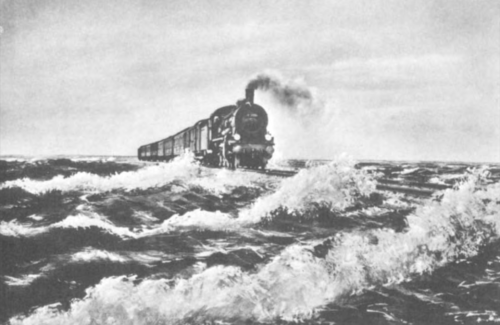 Image from the preface of Male Fantasies Volume 1: Floods, Bodied, History (1977) by Klaus Theweleit. [ID: A black-and-white image of a vintage postcard showing a train moving full steam ahead even though it is surrounded by tumultuous waters and breaking waves.]
Image from the preface of Male Fantasies Volume 1: Floods, Bodied, History (1977) by Klaus Theweleit. [ID: A black-and-white image of a vintage postcard showing a train moving full steam ahead even though it is surrounded by tumultuous waters and breaking waves.]
If the fascist dread of the swamp relates to fears of wetness, disorder, dissolution, horizontality, softness, spillage, and uncontainability—as well as fears around losing the hard sovereignty of the autonomous self—what does the inverse of this dread look like? What would it mean to embrace mud and its capacity for defilement? To get into the wetness of the ground, and to let it get into you? To want to be where things are messy and in unpredictable motion? To want to move like slime, oozing through interstitial spaces and lubricating the slippage of things? To relate to the world through its squishy permeability? To appreciate the ground as a responsive and relational place—a place that receives and remembers things, without striving for vertically erected permanence? To, in the words of C. Riley Snorton, “play in the mud, which is to say, to refuse formal techniques of classification”?19
Ursula K. Le Guin wrote a tiny text called “Being Taken For Granite,” in which she declared, “I wish that those who take me for granite would once in a while treat me like mud.”20 Granite, Le Guin notes, appears upright, immovable, and unchangeable—it “makes pinnacles” and “does not accept footprints.”21 Mud, on the other hand, “lies around being wet and heavy and oozy and generative.”22 Le Guin acknowledges that such squishy, unstable footing can leave some feeling insecure and resentful. “Maybe they fear they might be sucked in and swallowed,” she muses.23 But she wants to embrace her muddiness—her capacity to remain low down in the mess of relational entanglements and their movements, which leave her “all full of footprints and deep, deep holes and tracks and traces and changes.”24
The subversive potential of mud can also come into play in a more literal sense. See, for instance, “Mud and ACAB,” a short section of the pamphlet We Are ‘Nature’ Defending Itself by Isa Fremeaux and Jay Jordan of the Laboratory of Insurrectionary Imagination. In this publication, Fremaux and Jordan offer an account of their involvement with the ZAD (“Zone to Defend”) in France, a rural protest camp and experiment in commoning, with dozens of collective living spaces occupying over four thousand acres of wetlands, fields, and forests. For decades, the farmer and squatter communities of the ZAD have fought to defend the territory and prevent an unnecessary airport from being built there—while the French state has repeatedly tried and failed to evict them.
Recalling a particularly brutal eviction attempt in 2012, Fremeaux and Jordan write about how the mud became an accomplice for the residents. Battalions of riot police were sent in from across France, but as they tried to navigate the soggy terrain that they had no understanding of, the weight of their armament caused them to sink and succumb “to the earth’s wet grip.”25 As the residents began throwing handfuls of mud at them, the cops became increasingly disoriented and immobilized. The sludge showered onto their visors, blocking their vision. Some of the residents found that if the mud was aimed just right, it would slide down and fill the cops’ body armour so that they could no longer bend at the knees, and they would start toppling down into the gloop.26
The 2012 eviction attempt was a spectacular failure, and the ZAD has since succeeded in stopping the new airport project. For Fremeaux and Jordan, the wetness of the ground offered more than just a useful material in this fight; it also became a part of their political imagination. As they wrote at the time:
The word humble (like the word human) has its roots in humus, it means to literally return to earth. Perhaps the future will be built by heroic acts of humility rather than arrogant temples to growth. Perhaps civilization’s dream to suck this zone dry with its concrete and tarmac, steel and plastic will be vanquished by wetness.27
RUINS IN THE MARSHES
My interest in wet grounds began with my research on the artist Beverly Buchanan and her Marsh Ruins, an environmental sculpture erected in the intertidal coastal wetlands of Brunswick, on the southeast coast of Georgia, in 1981. The work is still there: three solid, ruinous boulders, built from concrete and tabby, which have been slowly crumbling and descending into the mud for more than four decades.
When she was in the early stages of planning the Marsh Ruins, Buchanan wrote, in a letter to her friend Lucy Lippard, that she was trying to imagine a site near water. “Near the ocean would be ideal,” she said, “so that eventually the piece would be ‘taken in.’”28 During this era, Buchanan often worked with bodies of water as sites of ecological entanglement, and as agents of sculptural formation and deformation. She lived in Macon, a small town in central Georgia, and she made several artworks with the Ocmulgee River, sending floating objects off to be pulled away by its currents, and leaving one of her sculptures submerged in its waters. When she travelled to Denmark in the summer of 1980, she made an ephemeral stone work, called 6-Piece Abandoned Sculpture, at the water’s edge on a beach at Kronborg Castle. As the tides came in and started rearranging the abandoned fragments, she took a series of photographs to document the work’s undoing. The Marsh Ruins, similarly, were constructed in the liminal zone where the water meets the land, and when the tides are high, they become partially submerged.
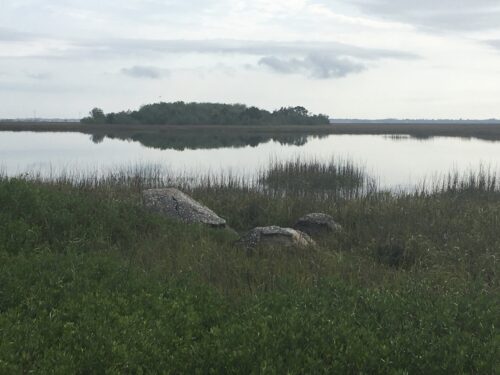 Beverly Buchanan, Marsh Ruins (1981). Photographed by Amelia Groom, April 2019. [ID: Colour photograph showing a marsh landscape with three stone boulders nestled among tall grasses. The still water behind them reflects the sky above.]
Beverly Buchanan, Marsh Ruins (1981). Photographed by Amelia Groom, April 2019. [ID: Colour photograph showing a marsh landscape with three stone boulders nestled among tall grasses. The still water behind them reflects the sky above.]
After travelling to Brunswick to see the Marsh Ruins back in 2019, I wrote a short book on the work. I spent some time thinking about Buchanan’s approach to ruination and what it means for an artist to make sculptures that are, at their very outset, conceived as “ruins.” With hindsight, I can say that I spent far less time in the book grappling with the other word in the work’s title: “marsh.” The marshland is, in many ways, a deeply significant site to choose for a major environmental sculpture in the deep south of the US. Things that are erected on muddy grounds are destined to sink and fall, messing with figure/ground and nature/culture bifurcations on their way down. Wetlands are zones of instability and ambiguity; they’re difficult to traverse, difficult to understand, and difficult to instrumentalise in accordance with colonial logics. In her work on “ecologies of resistance” in the plantation zone, Monique Allewaert describes how the swamp “stymied colonial armies and cartographers” and “compromised the order and productivity of imperial ventures, from explorations to plantations.”29 Throughout the southern landscapes that Buchanan grew up in—and later made work in dialogue with—swamps are also highly significant in histories of Black fugitive freedom, as sites that harboured maroon communities and their alternative life-worlds.
I have recently been trying to think and read about the aesthetics of mud and the significance of swamps in histories of counter-colonial resistance. This essay is an attempt to bring together some of the myriad strands of thought and research that I am moving through, and some of the artists, activists and scholars whose work has been guiding me. The text can be read as an oblique postscript to the Beverly Buchanan: Marsh Ruins (2021) book.30 There is always more to say about Buchanan’s inexhaustible work; like a marshland ecology, the Marsh Ruins are a site of uncontainable, leaky abundance. While this essay is not directly “about” Buchanan, she is very much a part of its ecology—and its lines of inquiry have seeped out from my encounter with her swampy environmental sculpture.
SUCKED IN
I opened this essay with van Goyen’s mudscapes. His paintings bear witness to early seventeenth-century Dutch land reclamation practices on a local scale, but these practices were also globally entangled. He was born in 1596—the very year that marks the start of the Dutch involvement in the transatlantic slave trade. He was six years old when the Dutch East India Company (VOC) was founded in 1602. By the time he painted View of Haarlem and the Haarlemmer Meer in 1646, the “humanist prince” and human enslaver John Maurice had already returned to Europe after his years as the governor of “Dutch Brazil,” the first Dutch Atlantic slave society and plantation colony, which was built on the stolen Indigenous lands of the north-east coast of Brazil. Elizabeth A. Sutton describes how Mauritsstad—which Prince Maurice founded as the capital city of Dutch Brazil—was, like so much of Holland, constructed on low-lying marshy lands that were drained and “reclaimed” through a canal system.31
The Dutch endeavoured to remake the local environment in their own image wherever they went in the so-called New World, including “New Amsterdam,” the settlement founded in 1625 on the swampy grounds of the stolen Lenape territory that is now known as Lower Manhattan. Memories of the suppressed watery past are still held in the financial district’s heavily paved streets, which now support the extreme vertical reach of towering skyscrapers. The curve of Pearl Street is the curve of the original shoreline; the name was “Parelstraat” in Dutch—a reference to the prominent Lenape shell midden that the settlers destroyed, using its white oyster shell fragments to pave the road. When the settlers used landfill to extend the shoreline into the East River, they built a street that runs in a straight line in front of Pearl Street. This street was often washed over with the salty waters of the river during high tide, which is why it has the name Water Street.
Dutch mud management techniques were also imported to (the region now known as) Indonesia and to the Dutch colonies in South America. Shortly before he was assassinated, the Guyanese Marxist historian Walter Rodney described how Dutch enslavers established their plantations along Guyana’s coast by overseeing the transformation of the region’s swampy ecology through techniques of “sea defense” and land reclamation. “The people of the Low Countries gave to the world the concept of a polder, referring to a piece of usable land created by digging and then draining a water-covered area,” Rodney writes, noting that the arduous work of making the land “usable”—by draining the mud and constructing elaborate systems of canals, dams and dykes—was entirely dependent on the labour of generations of Black and Indigenous enslaved and indentured workers.32
In her study of the intertwined histories of cartography and capitalism in the Dutch Golden Age, Sutton looks at the significance of the Beemster polder project that was founded just north of Amsterdam in 1608. The Beemster was a huge marshy lake area that was drained over several years and made into a dry grid of parcelled-out property. As the largest polder in the Netherlands and the first corporate land reclamation investment scheme, the Beemster was hailed as “a triumph over water” and “a statement of Dutch power over nature.”33
When the English embarked on major land reclamation projects in the first half of the seventeenth century, they turned to Dutch drainage engineers and their “literally world-changing technology.”34 The General Drainage Act was passed in 1600 for “making dry and profitable” many hundred thousand acres of marshes in the English Fenlands.35 Vittoria Di Palma has shown that while the region was dismissed as a “wasteland” and “mere quagmire,” the Fens had, in fact, long been a bountiful commons for local peasant foragers. She notes that the Dutch “produced the maps, the engineers, the venture capitalists, and, in many cases, the workers who remade the Fen landscape to fit a different model of productivity.”36 The result was a land “no longer held in common, but now divided into plots, traced out, numbered, and ready to enter the realm of private rather than communal property.”37
THE SWAMP: AN INSURGENT ECOLOGY
It should be noted that the draining of swamps for purposes of crop cultivation is not necessarily tied to colonial systems. In her book Black Rice: The African Origins of Rice Cultivation in the Americas, Judith A. Carney shows how the plantation economy along the South Carolina and Georgia coast—the area where Buchanan built her Marsh Ruins—was completely dependent on the knowledges and skills that were brought by enslaved people from regions of West Africa where coastal wetland reclamation had long been practised.38
But racial capitalism changes everything. In Sylvia Wynter’s formulation, “Western Man” initiates an entirely new relation with the natural environment—one in which, as Descartes proposed in 1637, “we . . . render ourselves the lords and possessors of Nature.”39 According to Wynter, this new relation only comes to realize itself “with the discovery of the New World and its vast exploitable lands.”40 Previously, she suggests, all societies existed in what the Négritude poet and critic Léopold Sédar Senghor describes as the “dual oscillatory process in which Man adapts to Nature, and adapts Nature to his own needs.”41 But under what Wynter refers to as the “impulsion of the market economy,” this kind of reciprocity between humans and nature was lost.42 Nature was converted into land, “conceivable only in terms of property, laid bare of myth, custom, tradition,” she writes.43 The catastrophic brutality of the Middle Passage is an inextricable part of this shift, since land, “if it were to function as land, needed not men, not communities, but so many units of labor-power.”44
When environments and racialized bodies are supposed to be reduced to property that is rationally utilized in service to capital, the swamp presents a problem. Christian morality already had a long history of “satanizing the swamp” and condemning wetlands as sites of evil and hellishness—as Rod Giblett has shown through readings of Beowulf, Dante, Milton, Tolkien, and other canonical texts that are infused with Christian traditions of theologizing the landscape.45 When it comes to the reduction of nature to land as privatised, profit-making property, wetlands are frequently denigrated as uninhabitable, impenetrable and unnavigable zones that needed to be “improved” and “civilized” through dredging, draining, and drying out.46 Through the eyes of the colonizer, the swamp was associated with rot and stench and death and disease and pollution and mess and monstrosity and femininity and waste and danger and loss.
In her cultural history of the Okefenokee Swamp in southeast Georgia (situated just inland from where Buchanan built her Marsh Ruins), Megan Kate Nelson describes how the muck and mire of the swamp stymied the military actions of US soldiers in their war against the Seminole people. Uncontainable and untameable, squishy and trembling, the swamp came to embody their failure to achieve “control over nature and power over other people.”47 Swamps also frustrated colonial efforts in cartography and stable categorization; to be rendered legible, mappable, divisible, and predictably productive, the wetlands needed to be turned into dry lands.
Ecologically, the effects of this western aversion to the swamp have been disastrous. Ecologists estimate that as much as 87 percent of the planet’s wetlands have been made to disappear in the last three centuries.48 With that disappearance comes extreme loss of life—and of complex life-systems. Wetlands host remarkable biodiversity; one statistic says that wetland areas currently make up about five percent of the surface of the planet, but more than forty percent of all species live or breed in them. They support diverse food systems and provide crucial stopover points for migratory birds. They can absorb and store vast amounts of carbon, which means substantial greenhouse gas emissions result from their drainage and destruction. Wetlands filter the groundwater by trapping sediments and pollutants. Since they can sponge up and slowly re-release water, they also act as buffer systems protecting from storms, floods, droughts, rising sea levels, and shoreline erosion. When wetlands are destroyed, so too is this protection.
Colonial aspirations for absolutely totalizing environmental control and rationalization were, however, never fully achieved. There were always swamp areas that remained beyond the reach of white instrumentalization and surveillance in the New World—and, as a result, these areas became a primary locus of marronage and Black fugitive freedom. Resisting recapture by using intimate understanding of the wetland ecology, self-liberated Black maroons were sheltered in the depths of the swamp, often living alongside dispossessed Native people, white felons and vagabonds, and other rebels and outcasts. This was certainly the case in the landscapes of the southern US where Buchanan lived and worked—with places like the Great Dismal Swamp of Virginia and North Carolina, where thousands of the formerly enslaved and their descendants found refuge and formed alternative worlds throughout the eighteenth and nineteenth centuries.
The lush ecology of the swamp provided sustenance and myriad protections to those who fled from bondage and racial violence. The density of growth could be a shield that muffled sound and occluded visibility—and the muddy wetness could help to mask the body’s smell, so that the vicious bloodhounds trained by plantation owners and patrollers would lose their scent trail. At the same time, the conditions were often extremely harsh. Harriet Jacobs writes, in Incidents in the Life of a Slave Girl (1861), about hiding out as a runaway in Snaky Swamp, an area of the Dismal Swamp in Chowan County, North Carolina. She was ill and feverish and terrified of the snakes that crawled all over her, but she recalls that “those large, venomous snakes were less dreadful to my imagination than the white men in that community called civilized.”49
 Jota Mombaça, Ghost 7(1-7): French Historical Maladie, Frac des Pays de la Loire, Nantes. Documentation of work in progress, courtesy of the artist, 2024. [ID: Jota stands at the top of a spiral staircase on the outside of a building. There’s grass and a grey sky in the background. Jota is opening one of her sunken textile Ghosts, and it looks like a huge dirty tongue, all pink and muddy and in motion.]
Jota Mombaça, Ghost 7(1-7): French Historical Maladie, Frac des Pays de la Loire, Nantes. Documentation of work in progress, courtesy of the artist, 2024. [ID: Jota stands at the top of a spiral staircase on the outside of a building. There’s grass and a grey sky in the background. Jota is opening one of her sunken textile Ghosts, and it looks like a huge dirty tongue, all pink and muddy and in motion.]
It was precisely because these zones were so difficult, and so reviled, that the swamp offered refuge from white society. Willie Jamaal Wright has written about the extent to which the practice of marronage was incumbent on the existence of “unruly environments”—swamps but also high mountains, dense forests, and other spaces that were consigned as inaccessible, inhospitable, not yet profitable, and that were therefore “illegible within the spatial imaginary of the participants of the plantocracy.”50 In Wright’s words:
Landscapes of marronage are those difficult terrains that marginalized, hunted, and exploited people have made habitable—areas where communities have taken a desire for liberation and merged it with an ignored and undervalued environment to gain liberties in opposition to repressive administrations.51
In this sense, the enslavers were right to fear the swamp. As a site of resistance and Black and Indigenous fugitivity, the swamp was a threat to the racial hierarchies of the settler colonial order. Kathryn Benjamin Golden has argued that the Great Dismal Swamp did more than harbour fugitives and maroon communities; its presence in the landscape also emanated the possibility of freedom and insurrection. This is what Golden terms the “insurgent ecology” of the Dismal Swamp: throughout the surrounding areas, the swamp’s looming presence “beckoned defiance of oppressive law and order” and “offered physical encouragement to enslaved insurgency and rebellion.”52
“SINKING COULD BE AN ELEVATION”
This essay is accompanied by a series of images from Jota Mombaça, an artist whose work over the last several years has been engaged with watery submersions, mud inscriptions, and what she refers to as “the radicality of sinking.”53 Mombaça was born in Natal, a port city that was the target of the Dutch invasion of Brazil in 1633 (for a brief time, the city was, just like Manhattan, known as “New Amsterdam”). While she was an artist-in-residence at Rijksakademie, Amsterdam, Mombaça became attuned to the murky depths of the city’s canals. She began making contact with these opaque repositories through a sculptural practice that involves rituals of submersion, immersion, and re-emergence. Bundles of fabric are chained up and lowered into the waters, where they are left for weeks on end, to become what Mombaça refers to as “Ghosts.” When they are eventually pulled back up, the fabrics are marked by the undoings of grime and time. They may have accrued frayed corners, clinging sediments, rust stains, traces of interaction from fish and other forms of underwater life, scratches and snags from encounters with rocks or other submerged entities, and all kinds of warpings and impressions from the algae, the salts, and the muddy depths.
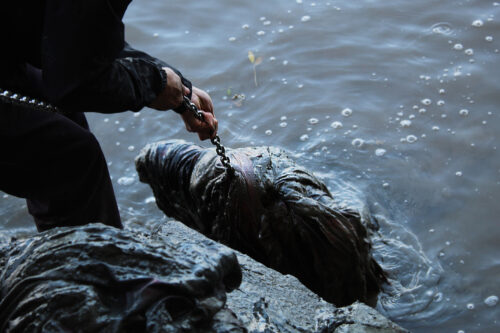 Jota Mombaça, Ghost 7(1-7): French Historical Maladie, Frac des Pays de la Loire, Nantes. Documentation of work in progress, 2024. Photography by Sarah Bogard. [ID: Colour photograph of an anonymous figure in black pulling one of Mombaça’s sunken textile bundles up out of the water (or lowering it down?) with a metal chain. The water is murky and bubbling.]
Jota Mombaça, Ghost 7(1-7): French Historical Maladie, Frac des Pays de la Loire, Nantes. Documentation of work in progress, 2024. Photography by Sarah Bogard. [ID: Colour photograph of an anonymous figure in black pulling one of Mombaça’s sunken textile bundles up out of the water (or lowering it down?) with a metal chain. The water is murky and bubbling.]
“In order to be converted into a Ghost,” Mombaça says, “the linen and the metal just have to wait while the underwater forms and deforms them.”54 It’s impossible to predict what kinds of formations and deformations will arise. Since a large part of the process is literally out of the artist’s hands, there is a necessary acceptance of the fact that she is not in a position of total control. But it goes beyond acceptance; there is also enjoyment and relief found in the loss of containment and control. As the artist suggests in her video waterwill (2022), the blessing of decomposition is that it offers an “abolition of progress and order.”
“I like to relate to my practice not as its master but rather as its channel,” Mombaça says.55 With her notion of “the radicality of sinking,” she refers to “the process of abandoning oneself into the water’s embrace, giving up the fantasy of control, and allowing water to take hold.”56 There is deep resonance here with the practice of Buchanan, another artist who worked with water as a historical repository, as a hiding place, and as a force of transience and transformation. Like Mombaça, Buchanan refused to occupy the position of the all-controlling master. She was very patient and precise in her intentions for her sculptures, but she was also always concerned with listening to her materials and letting them exist in evolving relation to their settings. She enjoyed stepping back and watching her creations move away from her authorial intentions, and she celebrated the pleasure she found in relinquishing control—as can be seen, for instance, in the playful calendar that she made for friends with the title Out of Control (2000).
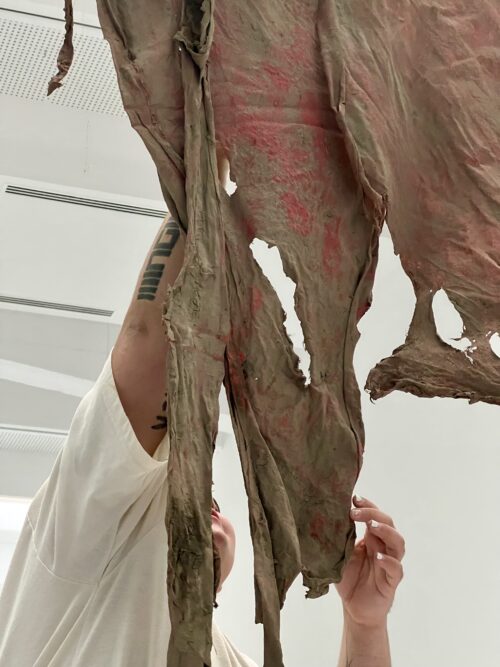 Jota Mombaça, Ghost 7(1-7): French Historical Maladie, Frac des Pays de la Loire, Nantes. Documentation of work in progress, courtesy of the artist, 2024. [ID: Jota is inspecting or arranging one of the sunken textile pieces, which has been hung up to dry. The fabric is frayed and torn, and the mud has left intricate patterns.]
Jota Mombaça, Ghost 7(1-7): French Historical Maladie, Frac des Pays de la Loire, Nantes. Documentation of work in progress, courtesy of the artist, 2024. [ID: Jota is inspecting or arranging one of the sunken textile pieces, which has been hung up to dry. The fabric is frayed and torn, and the mud has left intricate patterns.]
Throughout Mombaça’s sunken works, there is a commitment to being, as she puts it in her 2022 poem Visa Denied, “in touch with the mud, as in, engulfed by its embrace.”57 My own thinking on mud and swamps is very much indebted to Mombaça’s practice and the conversations we have had around it, which I hope will continue. In the years since her first experiments with the Amsterdam canals, the artist has gone on to work with other bodies of water: the Venetian Lagoon, the San Francisco Bay, the Waldsee Lake in Berlin, and—in the recent body of work that is depicted in these photographs—the Loire River in France. There is always site-specific research and response, but, at the same time, Mombaça wants to relate to the waters as figures of interconnectedness and global historical entanglements. In her words, the bodies of water “speak of place, but they also defy locality, as what is constitutive in every relationship they form with the sunken textiles is one of currents and motion.”58
Rather than representing a site through the depiction of discreet objects, the Ghosts are images that are gradually imbued with their settings, including the movements and layers of time that are held within them. For Ghost 7(1-7): French Historical Maladie, a recent body of work produced at Frac des Pays de la Loire in Nantes on the west coast of France, Mombaça worked with the heavily polluted and profoundly haunted waters of the Loire River where it meets the tidal surges of the Atlantic Ocean. This is a site where the Atlantic seeps into the ostensibly solid and delineated land of the European continent. “Deeply marked by the development of global logistics and colonial expansion, the Loire-Atlantique axis is one of revolted waters, unpredictable tides and decomposed bodies,” Mombaça remarked at the time of production. She continued:
The mud is abundant, their smells are pungent . . . So much hurt that is impossible to translate, and yet, in the offerings of the river, I found this beauty to which I am grateful. A terrible beauty that unites all of us, the colonized, through the common acknowledgment of the seeds of disintegration rooted in colonial modernity . . . With the Loire, I extend the rotten tongue of our anti-colonial dissatisfactions. I rant, I curse and I vomit: these hauntingly beautiful ghosts which are fractures of a common language.59
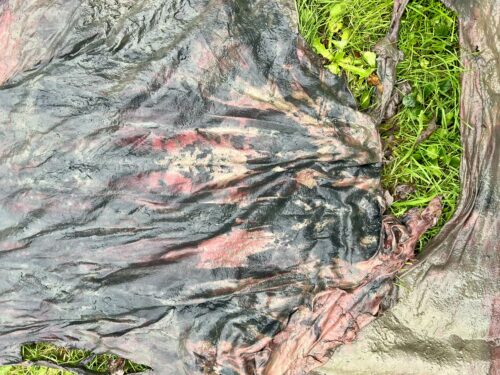 Jota Mombaça, Ghost 7(1-7): French Historical Maladie, Frac des Pays de la Loire, Nantes. Documentation of work in progress, courtesy of the artist, 2024. [ID: The image is similar to the one that appears at the very top of this essay, with the wet, muddy textiles laid out on the grass. Here, there’s some more detail of the patterns left in the fabrics, with slimey-black, pinky-reds, and greeny-greys.]
Jota Mombaça, Ghost 7(1-7): French Historical Maladie, Frac des Pays de la Loire, Nantes. Documentation of work in progress, courtesy of the artist, 2024. [ID: The image is similar to the one that appears at the very top of this essay, with the wet, muddy textiles laid out on the grass. Here, there’s some more detail of the patterns left in the fabrics, with slimey-black, pinky-reds, and greeny-greys.]
PLOT(TING)
This essay was commissioned for a (Dutch) online platform that is dedicated to “the plot” as conceptualized by Sylvia Wynter in the 1970s. The garden plots or “provision grounds” were small areas of land that were cultivated by the enslaved in the shadow of the plantation, as a means of sustenance and survival. In texts including her unpublished manuscript Black Metamorphosis: New Natives in a New World and her article “Novel and History, Plot and Plantation,” Wynter compares the ideology and spatial logic of the plantation to that of the plot. …
The plantation spread itself over the most fertile and desirable land, while the plot was consigned to small, marginal, difficult terrains at the plantation’s edges. The plantation grounds existed under regimes of intense scrutiny and surveillance, while the plot was often clandestine, and tended “after hours.” While the plantation flattened out and instrumentalised the ground for maximally efficient monocultural production—with the resulting product sent far away (for “a world of abstract exchange value”)—the plot was for growing food in response to local needs, as part of the immediate social context, through “concrete use value.”60 On the plantation, the slave “would represent the extreme case of alienation . . . dominating nature to create a product which was alien to his own needs, and which alienated him from them.”61 On the plot, however, “his position was a dual and dynamic relationship in which he adapted himself to nature and also transformed nature.”62
Wynter does not simply romanticize the plot as wholly exterior to the plantation system. She observes that the plot and the plantation originate together “in a single historical process,” and that the plantation masters “gave the slaves plots of land on which to grow food themselves in order to maximise profits.”63 Crucially, however, this is not the whole story. It is in the undervalued and, therefore, relatively under-surveilled zones of the provision grounds that Wynter locates the possibility for the flourishing of African diasporic folk cultures and “cultural guerilla resistance.”64 The plot was “an area of experience which reinvented and therefore perpetuated an alternative world view, an alternative consciousness to that of the plantation,” writes Wynter. “This world view was marginalized by the plantation but never destroyed.”65
The alternative consciousness that was possible in the interstitial space of the plot was antagonistic to the ecocidal rationale of the plantation. “While the ideology of the masters stressed the rights of property, the world-view of the African slaves remained based on a man’s relation to the earth and, concomitantly, to the community,” writes Wynter.66 The enslaved “transplanted to the plot all the structure of values that had been created by traditional societies of Africa.”67 In these societies, the earth was the basis of the community’s existence, and “could not be alienated as private property.”68 On the plantation, the earth was turned into land where the labour-power of the enslaved contributed to “the technical conquest of nature.”69 On the plot, however, “the land remained the Earth—and the Earth was a goddess: man used the land to feed himself; and to offer first fruits to the Earth; his funeral was the mystical reunion with the earth.”70
Édouard Glissant also identified the plot as a possible site of counter-colonial environmental praxis. Speaking with filmmaker Manthia Diawara while sitting outside in the sun in his native Martinique, the poet and philosopher of opacity and relationality emphasised the fact that cultivating plants in such small, cast-off spaces meant cultivating intimate knowledge about how different species could grow alongside each other while protecting and nurturing one another through subterranean relations. The plantation had orderly rows of a single crop laid out across a cleared field. In contrast to this coercive monoculturalism and hyper-legibility, Glissant describes how the provision grounds—which he refers to as “jardin créole”—were secretive sites of diverse multiplicities and cross-species interdependencies. “In a very narrow space,” he says, “they were able to grow dozens of different types of trees, different scents. Coconuts, yams, oranges, pines, dachines, choutchines, sweet potatoes, cassava. They did it in such a way that the plants mutually protected each other. It was the essence of the creole garden.”71
To consider the plot in this way is to consider the edges of the physical space of the plantation, as well as the limits of its (genocidal, ecocidal, and epistemicidal) violence. The worldviews that were sustained in the provision grounds were, in Wynter’s words, marginalized “but never destroyed.”72 So what happens if the swamp is brought in to triangulate the plot/plantation dialectic? These two zones, the plot and the plantation, do not account for the entirety of the eco-historical setting. While many wetlands were drained and cleared to facilitate settler productions of space, there were always those recalcitrant terrains that remained—however temporarily—beyond the reach of total surveillance, legibility, and extractive productivity. Existing as it did in a marginalized relation to the plantation, the plot could be a place for plotting escape; a place where the enslaved could gather, organise, and imagine otherwise. Existing as it did even further away from the land that was valued as rationally productive, the swamp could sometimes be the setting into which the self-emancipated would flee, either as a stopover point or as a more permanent refuge.
The swamp is not born from the same historical process as the plantation and the plot. It predates the racialising “impulsion of the market economy,” and it continues even after the imposition of that impulsion onto ecologies, bodies, and worldviews.73 And, unlike the expansive fields of the plantation and the narrow plots of the provision grounds, the ecology of the swamp defies clear delineation. It’s a planetary figure of seepage and interconnectedness—spatially as well as temporally. It can be difficult to say where the swamp begins and ends.74 The swamp exists in the shifting and unknowable depths; even when it has been drained, you can never be sure when or where its suppressed wetness might reappear.
“The pestilent marsh is drained with great labour, and the sea is fenced off with mighty barriers,” wrote Scottish Enlightenment philosopher Adam Ferguson. “Elegant and magnificent edifices are raised on foundations of slime.”75 Ferguson was describing the linear march of progress from “rude nations” to property-based civilization. But, as I’ve attempted to show, foundations of slime open up nonlinear and non-triumphalist ecologies of impermanence. The swampy muds bubble up into the foundations of Amsterdam’s grand canal houses, which were built with wealth accrued from the transatlantic slave trade. The muds seep into the reclaimed land of the rugby stadium, making a mess of differentiation. They’re gradually swallowing up the Marsh Ruins, as Buchanan always imagined they would. They make contact with Mombaça’s sunken textiles, enacting decomposition as a means of inscription, and becoming Ghosts who announce that the past is still very much present. In the words of Toni Morrison:
You know, they straightened out the Mississippi River in places, to make room for houses and livable acreage. Occasionally the river floods these places. ‘Floods’ is the word they use, but in fact it is not flooding; it is remembering. Remembering where it used to be. All water has a perfect memory and is forever trying to get back to where it was.76
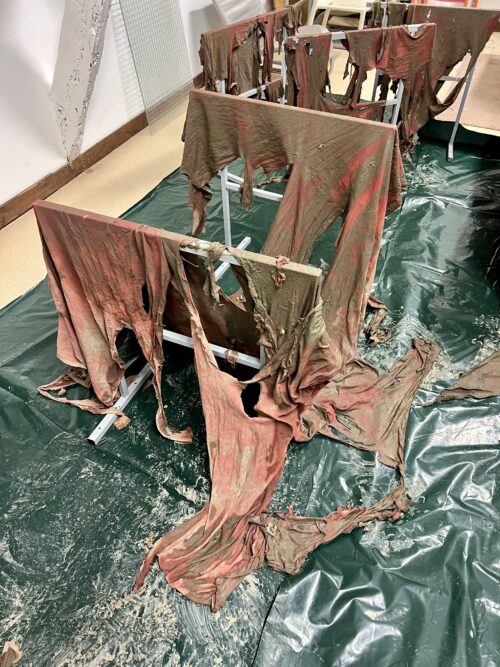 Jota Mombaça, Ghost 7(1-7): French Historical Maladie, Frac des Pays de la Loire, Nantes. Documentation of work in progress, courtesy of the artist, 2024. [ID: Colour photograph taken from an elevated perspective in a room where a series of the muddy Ghosts are being aired on stands. The fabrics are pink and brown and partially decomposed after their time underwater. There is some kind of protective floor cover on the ground; it’s dark green and defiled by mud.]
Jota Mombaça, Ghost 7(1-7): French Historical Maladie, Frac des Pays de la Loire, Nantes. Documentation of work in progress, courtesy of the artist, 2024. [ID: Colour photograph taken from an elevated perspective in a room where a series of the muddy Ghosts are being aired on stands. The fabrics are pink and brown and partially decomposed after their time underwater. There is some kind of protective floor cover on the ground; it’s dark green and defiled by mud.]
////
Parts of this essay were previously developed for the public lectures “‘I’m the one with a sculpture at the bottom of the Ocmulgee River’: Amelia Groom on Beverly Buchanan,” at The New School, New York, in 2022, and “Wetlands (Notes on Beverly Buchanan’s submerged sculptures),” at Studium Generale, Gerrit Rietveld Academy, Amsterdam, in 2022. Sincere gratitude goes to Amalle Dublon, Alhena Katsof, Jort van der Laan, and Jorinde Seijdel for organising and hosting those events. Thank you also to M. Ty, Aidan Wall, Lytle Shaw, and Patricia de Vries for reading draft versions of the essay and offering thoughtful feedback, and to Jota Mombaça for the images.
////
This text was commissioned and published by Plot(ting), Gerrit Rietveld Academie Research Group Art & Spatial Praxis (LASP): plotting.rietveldsandberg.nl
1. Lytle Shaw, New Grounds for Dutch Landscape (Stockholm: OEI editör, 2021), 95.
2. Ibid., 77.
3. Ibid., 67.
4. Ibid., 68.
5. Joseph Noonan-Ganley, “Our Prop Mud,” Nero (21 April, 2021).
6. Huw Richards, “Elements leave their mark in Cardiff,” ESPN (13 February 2009).
7. Noonan-Ganley, “Our Prop Mud.”
8. Cited from public conversation with the author at “On Cyberfeminism in Australia” during The 24th Biennale of Sydney (panel, Ten Thousand Suns, Sydney, 28 February 2024).
9. Klaus Theweleit, Male Fantasies Volume 1: Women Floods Bodies History, trans. Stephen Conway in collaboration with Erica Carter and Chris Turner (Minneapolis, MN: University of Minnesota Press, 1987), 229.
10. Ibid., 245.
11. Ibid., 229.
12. Ibid., 229–230.
13. Ibid., 387.
14. Ibid., 389.
15. For more on metaphors of deluge and anti-Asian racism in Australia, see Jessica Zhan Mei Yu’s moving essay “All The Stain Is Tender: The Asian Deluge and White Australia,” The White Review (March 2021), https://www.thewhitereview.org/feature/all-the-stain-is-tender-the-asian-deluge-and-white-australia/
16. Theweleit, Male Fantasies Volume 1, 409.
17. Ibid.
18. Ibid., 387.
19. UChicago Division of the Humanities, “C. Riley Snorton, The Wild Man in the Green Swamp and Other Stories about Race in America,” YouTube, recorded 16 October 2021, published 6 November 2021, http://youtu.be/csOk-3KGVXk. Snorton’s forthcoming monograph, tentatively titled Mud: Ecologies of Racial Meaning, examines racial practices in relation to swamps.
20. Ursula K. Le Guin, “Being Taken For Granite” in Ursula K. Le Guin, The Wave in the Mind: Talks and Essays on The Writer, The Reader, And The Imagination (Boston, MA: Shambhala Publications, 2004), 8.
21. Ibid., 9.
22. Ibid., 8.
23. Ibid., 9.
24. Ibid.
25. Isabelle Fremeaux and Jay Jordan, We Are ‘Nature’ Defending Itself: Entangling Art, Activism and Autonomous Zones (London: Pluto Press, 2021), 48.
26. Ibid.
27. Ibid., 49.
28. Letter dated 11 July 1979, in Lucy Lippard’s personal archives.
29. Monique Allewaert, “Swamp Sublime: Ecologies of Resistance in the American Plantation Zone” in PMLA (March, 2008, Vol. 123, No. 2), 343. This article opens with Georgia’s sea islands, which Buchanan’s Marsh Ruins sit next to. The history and culture of these islands were important in Buchanan’s conception of the work.
30. Amelia Groom, Beverly Buchanan: Marsh Ruins (London: Afterall Books, 2021).
31. Elizabeth A. Sutton, Capitalism and Cartography in the Dutch Golden Age (Chicago, IL: University of Chicago Press, 2015), 86.
Sutton points out that while Portuguese colonists in the New World tended to build settlements on land that was high and dry, the Dutch colonists chose to settle on low-lying marshy and coastal areas.
32. Walter Rodney, A History of the Guyanese Working People, 1881–1905 (Baltimore, MD: John Hopkins University Press, 1981), 2.
33. Alette Fleischer, “The Beemster Polder: Conservative Invention and Holland’s Great Pleasure Garden,” in The Mindful Hand: Inquiry and Invention from the Late Renaissance to Early Industrialization, Lisa Roberts, Simon Schaffer, and Peter Dear, eds. (Amsterdam: Koninklijke Nederlandse Akademie van Wetenschappen, 2007), 145.
34. Peter Linebaugh and Marcus Rediker, The Many-Headed Hydra: Sailors, Slaves, Commoners, and the Hidden History of the Revolutionary Atlantic (Boston, MA: Beacon Press, Massachusetts, 2000), 44.
35. Vittoria Di Palma, Wasteland: A History (New Haven and London: Yale University Press, 2014), 99.
36. Ibid., 110.
37. Ibid., 111.
38. Judith A. Carney, Black Rice: The African Origins of Rice Cultivation in the Americas (Cambridge, MA: Harvard University Press, 2001).
39. Sylvia Wynter, Black Metamorphosis: New Natives in a New World, unpublished manuscript, no date, housed in The Schomburg Center for Research in Black Culture, New York, 20.
40. Ibid., 19.
41. Sylvia Wynter, “Novel and History, Plot and Plantation,” in Savacou: A Journal of the Caribbean Artists Movement 5 (June 1971), 99.
42. Wynter, Black Metamorphosis, 19.
43. Ibid.
44. Ibid., 19–20.
45. See Rod Giblett, “Theology of Wet Lands: Tolkien and Beowulf on Marshes and Their Monsters,” in Green Letters: Studies in Ecocriticism 19, no. 2 (2015); and Rod Giblett, Postmodern Wetlands: Culture, History, Ecology (Edinburgh: Edinburgh University Press, 1996).
46. See Lindsey Dillon, “Civilizing swamps in California: Formations of race, nature, and property in the nineteenth century U.S. West,” in EPF: Society and Space 40, no. 2 (2022), 258–275. Dillon looks as “the transformation of swamps into private property, solid ground, and homogeneous space” as an example of “settler ecologies” that “spatialized individualist and instrumental ways of relating to land, with significant ecological effects.” Ibid., 260.
47. Megan Kate Nelson, Trembling Earth: A Cultural History of the Okefenokee Swamp (Athens, GA: The University of Georgia Press, 2005), 4.
48. Emily O’Gorman, Wetlands in a Dry Land: More-Than-Human Histories of Australia’s Murray-Darling Basin (Seattle, WA: University of Washington Press, 2021), 11.
49. Harriet Jacobs, Incidents in the Life of a Slave Girl (1861; repr., ed. Nell Irvin Painter, London: Penguin Books, 2000), 126.
50. Willie Jamaal Wright, “The Morphology of Marronage,” Annals of the American Association of Geographers 110, no. 4 (2020), 7.
51. Ibid., 2.
52. Kathryn Benjamin Golden, “‘Armed in the Great Swamp’: Fear, Maroon Insurrection, and the Insurgent Ecology of the Great Dismal Swamp,” The Journal of African American History 106, no. 1 (Winter 2021), 10.
53. Jota Mombaça, “SIX QUESTIONS posed by Lauren Sorresso to Jota Mombaça on THE SINKING SHIP/PROSPERITY, a solo exhibition at KADIST San Francisco,” Kadist (2022).
54. Ibid.
55. Ibid.
56. Ibid.
57. The subtitle of this section of my essay, “sinking could be an elevation,” also comes from one of Mombaça’s poems, which the artist read on the occasion of THE SINKING SHIP/PROSPERITY Current 1: Conversation with Jota Mombaça and Darla Migan (lecture, Kadist, San Francisco, 14 November, 2022).
58. Mombaça, “SIX QUESTIONS.”
59. Instagram post caption from Jota Mombaça, @jotamombaca (27 November, 2023).
60. Wynter, Black Metamorphosis, 51.
61. Ibid., 52.
62. Ibid., 52–53.
63. Wynter, “Novel and History, Plot and Plantation,” 99.
64. Ibid., 100.
65. Wynter, Black Metamorphosis, 53.
66. Ibid., 48.
67. Wynter, “Novel and History, Plot and Plantation,” 99.
68. Wynter, Black Metamorphosis, 28.
69. Ibid., 51.
70. Wynter, “Novel and History, Plot and Plantation,” 99.
71. Édouard Glissant: One World in Relation, directed by Manthia Diawara (K’a Yéléma Productions, 2010).
72. Wynter, Black Metamorphosis, 53.
73. Ibid., 19.
74. O’Gorman, Wetlands in a Dry Land, 46–58.
75. Cited in Linebaugh and Rediker, The Many-Headed Hydra, 46. Emphasis added.
76. Toni Morrison, “The Site of Memory,” in Inventing the Truth: The Art and Craft of Memoir, ed. William Zinsser (second edition; Boston and New York: Houghton Mifflin, 1995), 98–99.
There’s No Beginning and There Is No End
“I refuse to acknowledge time.” With these outlandish words, Mariah Carey begins her memoir, The Meaning of Mariah Carey, published in 2020. “It is a waste of time to be fixated on time,” declares the elusive chanteuse. “Life has made me find my own way to be in this world. Why ruin the journey by watching the clock and the ticking away of years?” Instead of counting the minutes and years, Mariah wants to live life “moment to moment.” Indeed, moments are one of her favorite things. See “Mariah Carey Needs a Moment” on YouTube; it’s a much-loved ninety-second supercut from her 2010–11 infomercials on the Home Shopping Network, in which she sells fashion, perfume, and jewelry items while enthusing about having a “diamond moment,” a “retro moment,” a “bandana moment,” a “genius moment,” a “dual moment,” a “fragrant moment,” a “skin-tight moment,” a “transitional summer moment,” a “full-on evening moment,” a “fun cute remix moment,” and so on.
Mariah’s espousal of moments has inspired many, including Adam Farah-Saad (aka free.yard), a London-born and -based artist and dedicated Lamb whose work is often infused with MC’s language, lyrics, and iconography. (“Lambs” are what Mariah’s most devoted fans call themselves; collectively we are the “Lambily.”) Working across video, installation, and performance formats, Farah-Saad makes art with various things including poppers, friends, obsolete technologies like iPods and CDs, microdosing, wind chimes, personal memories and heartbreaks, fisheye lenses, cruising, lipsynching, and gourmet condiments. They have said that Mariah inspires them as an artist, “in terms of wanting to be really sincere and poetic in what I do and kind of not being afraid to even go a bit overboard with that.”3 Their solo exhibition at Camden Art Centre in 2021 was framed as a presentation of “peak momentations” from their life. The term “momentation,” they explain, refers to “a pronounced dwelling on the ephemeral—influenced by Mariah Carey’s queer disidentificatory theorisations of THE MOMENT.”
The word “moment” comes from the Latin “momentum,” meaning “movement, motion, alteration, change.” It’s a shifty word: “in a moment” means very soon, to be “of the moment” is to be very current, to “live for the moment” is to act without concern for the future or the past. Moments are often temporal intensities that stand apart from the time that surrounds them; when we say “I need a moment” or “I’m having a moment,” it’s about puncturing the flow of things by carving out a pocket of time outside of regulated time. Moments are very different from minutes; they are decidedly transient, unquantifiable, indivisible, and non-accumulative. They’re brief but capacious; you can’t section them out or add them up in any normative way. For Mariah, living a life of moments means living “Christmas to Christmas, celebration to celebration, festive moment to festive moment,” while simply ignoring the rest, and always refusing to acknowledge the banality and brutality of standardized, accumulative, linear time. As she writes, “Often time can be bleak, dahling, so why choose to live in it?”
LINK: READ THE FULL ESSAY AT E-FLUX
Update 27 March 2024 (Mimi’s anniversary): A French translation of the essay by Emmanuel Pierre published at The Master’s Clock.
Lessons from Scheherazade
The tale has been told and retold many times: Scheherazade, the daughter of the sultan’s advisor, has volunteered to marry the sultan. The sultan is in the midst of a hysterical killing spree; he felt betrayed by his first wife, so he decided to kill her, and then marry a new woman every day, having each one beheaded after consummating the marriage on their first night together. Scheherazade has a plan. She marries the fearful and vengeful ruler, and then once she is in his chambers, she invites her sister Dunyazad in, ostensibly to say goodbye to her on her last night alive. Dunyazad then asks Scheherazade to tell her a story, and as she tells it, the sultan begins to listen in. Scheherazade is such a good storyteller that they all end up staying awake through the night. As day breaks, Scheherazade cuts the story short, so that the sultan will have to keep her alive in order to hear the end of the story later that night. She dutifully finishes the story when night falls, but then she immediately begins another story, an even better one, and again she stops the story at dawn, and survives for one more day, and so on . . .
The Arabian Nights or One Thousand and One Nights—as it is known in English—is a collection of Near and Middle Eastern stories that was compiled in Arabic over many centuries by many different writers, translators, scholars, and transmitters of oral histories, who drew from many different folkloric practices, including ancient and medieval Arabic, Greek, Indian, Jewish, Persian, Egyptian, Mesopotamian, and Turkish traditions. With multiple origins and many splintering versions, the Nights is a thoroughly decentralized and impure text which is made up of multiple texts and texts within texts—with layers of narration that move through and break open a plurality of genres, including romance, erotica, historical tales, tragedies, comedies, poems, riddles, jokes, proverbs, burlesques, murder mysteries, suspense thrillers, political satires, philosophical explanations, anatomical descriptions, and stories that could be described as early science fiction.
The commonality throughout the many versions is the framing narrative of Scheherazade, the woman who is telling these stories from within her own story. As a figure who is simultaneously a character in and the storyteller of the Nights, she manages to maintain a façade of deferential obedience to the sultan while also subverting the logic of hegemonic time from within—rerouting its linearity and interrupting the sense of inevitability that has been set by cruel precedent. As a masterful storyteller, Scheherazade knows how to fit stories onto and into other stories, and she knows how to break them off at just the right moment. By always terminating her stories before they’re finished, she can keep bringing in more stories, which means more nights—since the time of storytelling is exclusively nocturnal. And it is through this restructuring of continuity and discontinuity that she eventually manages to save her own life, as well as the lives of all the women who were to be raped and murdered after her, because her storytelling makes the sultan want to change his ways.
Through the art of fabulation, Scheherazade interrupts the temporality of the status quo, replacing the ruler’s repetitive and open-ended killing spree with her storytelling, which is also strategically repetitive and open-ended. Her situation is one of utter desperation: she has no time left, this is her last night alive, there is no futurity. But then, within the radical present tense of storytelling, she weaves continual interruption, extension, and deferral. Once she has suspended the sultan’s sequence of murders and elicited his curiosity, she’s able to perform a kind of temporal dilation, wherein the linearity of hegemonic time is pierced and stretched out, because she tells stories in which people tell stories in which people tell stories . . . The listening sultan is plunged into the time of the narration, which keeps opening up into more time, and each internal proliferation of time in the embedded stories gives the storyteller more time in the broader framing narrative that is her life.
أَلْفُ لَيْلَةٍ وَلَيْلَةٌ (One Thousand and One Nights) was first translated and repackaged for European audiences in the eighteenth and nineteenth centuries, and ever since then the figure of Scheherazade has been burdened with the tedious and damaging projections of orientalism. In the introduction to her edited anthology Scheherazade’s Legacy: Arab and Arab American Women on Writing (2004), the Palestinian American scholar Susan Muaddi Darraj observes that the figure of Scheherazade was always revered in the East, but she “suffered terribly at the hands of translators […] An intelligent woman, schooled in literature, philosophy, and history, reduced to an erotic, shallow, sex-crazed body behind a veil—it happened many times, with many Arab and/or Eastern women, including Cleopatra, Khadijah, and Aisha.”[1] In spite of the west’s creepy and reductive warpings, though, Darraj writes that many contemporary Arab women writers have reclaimed the image of Scheherazade as someone who “wove a marvelous tapestry of tales” and “who saved a nation and healed its king.”[2]
In her book Stranger Magic: Charmed States & the Arabian Nights (2013), the feminist mythographer Marina Warner observes that throughout the Nights, Scheherazade’s tales gradually move “towards a politics of love and justice that opens the cruel Sultan’s eyes to another vision of humanity.”[3] Within her complex tapestry of composite and multiply enveloped stories, Scheherazade begins to weave threads of critique: with stories about subjugated women who are clever and courageous, she chips away at the sultan’s rationale for his hatred; and with stories about murderous tyrannical men who learn to pull themselves together and mend their ways, she establishes an alternative lineage of precedent. Storytelling is deployed as an ancient technique of consciousness raising, and by the end of the Nights, Scheherazade has succeeded in getting the sultan to stop killing, not only because he wants to keep hearing more stories, but also because he doesn’t want to kill any more.
In some ways, Scheherazade’s approach aligns closely with the definition of parrhesia, or “speaking truth to power,” that was outlined by the philosopher Michel Foucault in a series of lectures given at the University of California, Berkeley in 1983.[4] Looking primarily at the context of ancient Greece, Foucault observed that the parrhesiastes, the one who speaks truth to power, “is always less powerful than the one with whom he speaks.”[5] Leaving aside for now Foucault’s exclusive use of male pronouns, the idea here is that parrhesia is critical speech which happens within an uneven power relation, and it is thus a dangerous activity which requires courage. The parrhesiastes is someone who speaks from a position of risk; in its most extreme form, Foucault says, “telling the truth takes place in the game of life or death.”[6]
This is certainly the case for Scheherazade; her situation is literally a matter of life or death. Closely related to the dimension of risk, in Foucault’s outline of parrhesia, is the dimension of duty. The parrhesiastes is someone who prioritizes their commitment to others above their own self-interest. In Scheherazade’s case, when she volunteers to marry the sultan, she forfeits her own security—and when her highly risky gamble pays off, she doesn’t just save her own life, she has acted from a sense of duty to others in order to end this man’s murderous rampage.
But Scheherazade’s practice of critique also diverges from Foucault’s outline of parrhesia in several ways—and these divergences can help us get to an expanded understanding of what political protest, critique, and activism can look like. While Foucault’s parrhesiastes is someone who chooses “criticism instead of flattery” when they speak truth to power, Scheherazade must deliver her criticism cloaked in flattery and subservience.[7] She does exactly what the sultan tells her to do, finishing the story from the previous night—just as he demands—when the next night comes around. She understands that it is only by playing with the sultan’s vanity, and maintaining his fantasy of control, that she is able to position him as a listener. While he thinks that she is obediently following his commands, her storytelling is actually making him embody the kind of listening that will lead him to challenge his own assumptions.
Foucault emphasizes “frankness” as part of his basic criteria for the Greek idea of parrhesia. His parrhesiastes is someone—someone male—who “makes it manifestly clear and obvious that what he says is his own opinion,” always “avoiding any kind of rhetorical form which would veil what he thinks.”[8] Scheherazade, meanwhile, is an artist of veils and indirection. As a woman who is married to a sultan who hates women, who kills with impunity, and who is planning to cut off her head in the morning, she becomes an oblique parrhesiastes, transmitting oral histories and gathering fabulatory tales while spinning them into a material means of survival, and of critique.
Some of the critique happens through the content of her stories—as when she introduces details that bear resemblance to the sultan and the situation that she is in with him—but her primary strategy is not about delivering a clear and direct political message that is designed to convince at the level of content. Rather, her polyphonic storytelling builds a space in which she can gradually shift the sultan’s perspective, and interrupt his myopic rage, by expanding his perceptual capacities. Through the masterful deployment of deferrals, detours, ellipses, cliffhangers, and embedded narratives, she clears more and more time for more and more voices, creating a situation of expansive compassion and mutual enjoyment.
“One can never go to the ruler in a direct way; in order to voice one’s opinion, one has to take an indirect way.”[9] This is the postcolonial feminist scholar and filmmaker Trinh T. Minh-ha, in conversation at a screening of her work in London in 1992. She is referring broadly to the situation of marginalized peoples caught in uneven power relations—but one could imagine that she is speaking specifically about Scheherazade, who understands the necessity and the potential power of indirect modes of address. In valorizing indirection from a feminist perspective, Trinh acknowledges:
there is always a danger, in assuming a tone and a position of indirection, that one may simply fall back into the habit of understating and of muting one’s voice as expected from women: We are, after all, supposed to abide by the rules of proper feminine speech and manner, never going at something too aggressively and too directly, often taking the back door, the discreet path to arrive at certain locations or to make certain points.[10]
However, while there is this danger, Trinh also insists here that attitudes of indirection “can be assumed submissively, strategically or creatively.”[11]
Indirection, then, can be understood as more than just a survivalist necessity for the subjugated; it’s also an approach that can bring its own poetic and epistemological possibilities. While the effect might frustrate audiences who are looking for a clear, convincing, and direct political message, strategies of indirection and opacity can ultimately work against processes of reductive appropriation, instrumentalization, commodification, and assimilation. In the context of late capitalism, Trinh argues, “it is important to work with indirection and understatement, if meaning is to grow with each viewer, and if the interstices of active re-inscription are to be kept alive.”[12]
At the start of her book Woman, Native, Other: Writing Postcoloniality and Feminism (1989), Trinh describes a nocturnal scene in an unnamed “remote village,” where people have gathered for a collective discussion. Rather than getting straight to the point, the participants in this discussion proceed through oblique and digressive paths, enacting a multiplicity of possible ways into and out of the discussion. “Never does one open the discussion by coming right to the heart of the matter,” Trinh writes. “For the heart of the matter is always somewhere else than where it is supposed to be. […] There is no catching, no pushing, no directing, no breaking through, no need for a linear progression which gives the comforting illusion that one knows where one goes.”[13] The nonlinearity of the indirect approach means that there is no preconceived beginning or ending; each speaker remains responsive to the situated context and allows things to emerge from it relationally.
As Trinh comments elsewhere, approaching the subject of one’s focus indirectly “allows oneself to get acquainted with the envelope, that is, all the elements that surround, situate or simply relate to it.”[14] An approach of direct opposition can treat the object of critique as something that is stable, neatly delineated, and external to oneself, whereas indirect approaches can allow for more nuanced understandings of the shifting relations and conditions surrounding the object—relations and conditions which include the position of the speaker. “It is in indirection and indirectness,” Trinh observes, “that I constantly find myself reflecting back on my own positions.”[15]
Foucault’s work on parrhesia has often fed into the familiar image of the activist as a heroic individual addressing a crowd with a bullhorn. When Semiotext(e) posthumously published his Berkeley lectures on parrhesia as a book called Fearless Speech (2001), for instance, they chose for the cover a black-and-white photograph of Foucault speaking through a megaphone at a protest on the streets of Paris in 1969—and similar images of the charismatic philosopher wielding a bullhorn tend to reappear whenever his work on parrhesia is revisited.[16] This is what “speaking truth to power” tends to look like in the popular imagination: there is an isolated individual, in public space, whose amplified voice delivers an uncompromising and direct message.
When the figure of the courageous parrhesiastes becomes one of fetishised heroism—and when incitements to ‘speak up’ in the face of power are universally applied—the uneven distribution of risk and access are overlooked. For the undocumented, risking arrest at a protest can mean risking deportation. For many others—including detained and imprisoned people, and many sick and disabled folk and their carers—physical presence at the site of the public protest might be impossible. In looking to the figure of Scheherazade as an oblique parrhesiastes, we can start to move beyond figurations of individualized heroism, and begin to think about other forms of “fearless speech” that do not lend themselves so easily to clearly delineated representational imagery.
Rather than speaking on the street, in broad daylight, as an individual with a mic, Scheherazade is a storyteller who works quietly and nocturnally, within a sphere of domesticity, while hanging out with her sister. Excluded from the realms of public discourse, she does not oppose the sultan as an individual facing an individual. In fact, she doesn’t directly address him at all; she and Dunyazad have triangulated things so that the sultan—the embodiment of absolute power—is no longer the primary audience. As he listens in on these two sisters, their transgressive solidarity must not be recognized as such by him. Their courageousness necessarily goes under the radar. Critique, in this setting, is not performed as the transferal of predetermined content from point A to point B. Rather, it’s something that is practised through the creation of a multisensory environment for opening up new times within time. It is enacted through the pleasures of telling and retelling; through practices of digression and deferral—practices which stay in the process, in the midst of things, and which are always to be continued.
“Lessons from Scheherazade: On the Art of Indirection” was published in the Sandberg Instituut’s 2022 graduation publication, which aims at thinking about works “in progress” and over time, to get away from the high-pressure ideas of finality and culmination at the art school graduation show. More from Our Polite Society and Sandberg.
[1] Susan Muaddi Darraj (ed), Scheherazade’s Legacy: Arab and Arab American Women on Writing, Praeger: Westport, Connecticut and London, 2004, p. 1-2.
[2] Darraj, Scheherazade’s Legacy, p. 3.
[3] Marina Warner, Stranger Magic: Charmed States & the Arabian Nights (Cambridge, MA: Harvard University Press, 2013) p. 10.
[4] Michel Foucault, “Discourse and Truth: the Problematization of Parrhesia” (lecture series, University of California, Berkeley, October–November 1983) https://foucault.info/parrhesia
[5] Foucault, “Discourse and Truth,” p. 18.
[6] Foucault, “Discourse and Truth,” p. 16.
[7] Foucault, “Discourse and Truth,” p. 20.
[8] Foucault, “Discourse and Truth,” p. 12. Foucault argues in his lectures that parrhesia depends not only on courageousness and duty but also on a degree of privilege: the parrhesiastes in Greek society must be able to speak freely as a citizen, so foreigners, children, the enslaved, and women, are generally excluded from the activity.
[9] Trinh T. Minh-ha, Cinema-Interval (Routledge: New York and London, 1999) p. 25.
[10] Trinh, Cinema-Interval p. 25.
[11] Trinh, Cinema-Interval p. 25.
[12] Trinh, Cinema-Interval p. 25.
[13] Trinh T. Minh-ha, Woman, Native, Other: Writing Postcoloniality and Feminism (Indiana University Press: Bloomington and Indianapolis, 1989), p. 1.
[14] Trinh, Cinema-Interval p. 34.
[15] Trinh, Cinema-Interval p. 34.
[16] See, for example, the promotional image for the 2016–2018 event series Fearless Speech at Hebbel am Ufer, Berlin: https://www.hebbel-am-ufer.de/en/archive/fearless-speech/
Beverly Buchanan: Marsh Ruins
Beverly Buchanan’s Marsh Ruins (1981) are large, solid mounds of cement and shell-based tabby concrete, yet their presence has always been elusive. Hiding in the tall grasses and brackish waters of the Marshes of Glynn, on the southeast coast of Georgia, the Marsh Ruins merge with their surroundings as they enact a curious and delicate tension between destruction and endurance. This volume offers an illustrated examination of Buchanan’s environmental sculpture, which exists in an ongoing state of ruination.
Amelia Groom illuminates Buchanan’s vision of sculptural ruination, and probes her remarkable work in terms of ideas of witnessing, documentation, landscape, and cultural memory. Existing in dialogue with land art and postminimalist sculpture, the Marsh Ruins are nevertheless unique refusals of art world classifications and systems of value. Making abstract use of concrete forms, Buchanan’s works embody their own stakes, from colonialism’s legacies of fracture and dislocation, to the workings of weather and time. In the words of her own mother, Buchanan had always “seen things” in rocks that others didn’t see.
Published by Afterall Books and MIT Press.
Support your local bookstore if you can! There is for instance bookshop.org for online shopping in US/UK. If in EU, I believe my favourite bookstore San Serriffe has copies of the book and is doing EU shipping.
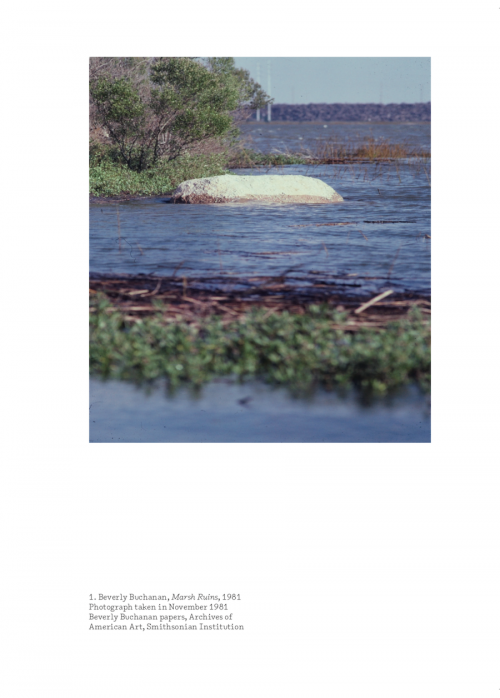
Related talks / events / teaching:
29 January 2021 – Online lecture for Word & Image research group, University of Amsterdam.
23 March 2021 – Online lecture for ho.ldin.gs at the Royal College of Art, London.
17 May 2021 – Online lecture for the Royal Academy’s RA Schools, London.
21/22 October 2021 – 2-day workshop at Royal Danish Academy of Fine Arts, Copenhagen.
25 October 2021 – Online lecture for Sexual/Racial Ecologies in Art at The New School, New York.
3 November 2021 – Book launch at San Serriffe, Amsterdam – registration here.
4 November 2021 – Book launch at Kunstinstituut Melly, Rotterdam – registration here.
16 March 2022 – Lecture as part of the Studium Generale “Oceanic Imaginaries” program at the Rietveld Academy in Amsterdam – details here.
4 April 2022 – Online lecture for the series “Practicing the Environment” at The New School, New York – details and registration here.
23 May 2022 – Library talk on Beverly Buchanan: Marsh Ruins at Laboratory for Art Research, Royal Danish Academy of Fine Arts, Copenhagen.
30 May 2022 – Taken in by the Sea: I have organised a symposium on Beverly Buchanan at the Laboratory for Art Research, Royal Danish Academy of Fine Arts, Copenhagen. Contributions from Phoebe Collings-James, Bhanu Kapil, M. Ty, Kiyan Williams, and The Many Headed Hydra. In-person event; all welcome.
17 August 2022 – Berlin book launch at Hopscotch Reading Room (there will be a raffle!).
6 February 2023 – Online lecture and discussion for the Art in Public Space program at Funen Art Academy in Odense, Denmark.
//////
Some media coverage:
Book review in the swiss journal figurationen. gender literatur kultur No. 01 (2022) (in German).
Marsh Ruins in Metropolis M magazine No. 5 (June 2021) (in Dutch).
Marsh Ruins in the New York Times (July 2023).
Gossip (recipes)
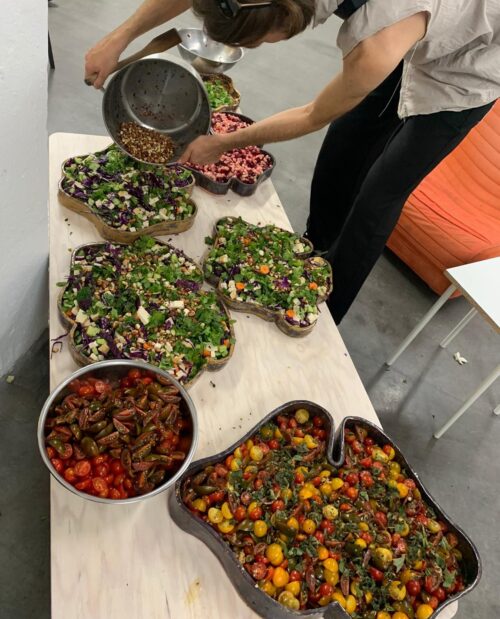
Opening remarks: [Pass around fresh basil leaves.] Everyone is invited to put one of these basil leaves under their tongues, if they want to. This is a cue taken from the medieval mystic Hildegard of Bingen, who wrote a lot about herbs, and who suggested basil for loosening the tongue (“place basil under the tongue, and speech will return”). Let the basil leaf feel like a second tongue. This is an invitation to start thinking about becoming many-tongued together, through herbal prosthesis and botanical extension …
The salads on tonight’s menu all contain herbal encouragements for rumourous and gossipy exchange. While working on the recipes I asked some friends for advice. The apple salad has cinnamon, which my friend Deborah suggested as a social inducer which is both warming and outward-moving in its atmospheric effects. The mezcal cocktails have ginger, lemon, agave, fennel, and a very special ingredient: acmella oleracea (also known as buzz buttons, ting flowers, and electric daisies). My friend Annick suggested these yellow flowers; they produce an intense sensation in the mouth, a kind of numbing and fizzing effect, which then leaves the tongue open to sensation and flavour. They also have the effect of producing a lot of saliva, which lubricates the flow of gossip… Annick and I also talked about sage, which is generally good for the respiratory system, the lungs, the throat chakra, the mouth and the tongue, it’s good for breath and speech and song … The tomato salad has a lot of fresh sage in it. There’s also a Thai herb salad, which is full of basil, painted full of tongues, like all of us. Enter Rumor, painted full of tongues: This is a stage direction from Shakespeare’s Henry IV, and it’s the title of the talk I’ll be giving later this evening. But first, let’s eat …


Enter RUMOUR, painted full of tongues was a dinner I hosted as part of K2020 at Lothringer 13 Halle, Munich. Some documentation from the makeshift kitchen ^^^ Ceramics and tables by artist Achinoam Alon – ceramics modelled after cross-sections from neurological representations of nervous pathways in the body.
This event was to Grapevine Epistemologies, a project which looks at gossip, rumor, and hearsay as queer-feminist epistemologies. To hear something through the grapevine is to receive it through dispersed social channels that are akin to the sprawled tangles of tendrils and vines. This expression, which has its origins in the talk that travelled informally among laborers of plantation economies, stands in contrast to the idea of communication as a clean, linear transmission with traceable origins. I am working on a book that asks what happens when indirection, speculation, fantasy, incompleteness, and doubt register in the historical record, and within the mechanics of its constitution. The project considers the possibilities and thresholds of gossip as a social practice, an artistic medium, a political tool, a historical force, and a research methodology.
Genius Vs. Lesbian
An essay I wrote on Emma Wolf-Haugh’s Domestic Optimism, Act One: Modernism—A Lesbian Love Story is now online at X-TRA: https://www.x-traonline.org/online/genius-vs-lesbian
What a way to make a living
For his One Year Performance 1980–1981: Time Clock Piece (1980–1981), the artist Tehching Hsieh set out to register his arrival at a worker’s time clock in his Manhattan studio, every hour, on the hour, day and night, for an entire year, beginning on 11 April 1980. He photographed himself each time he “clocked in,” and the 8627 resulting images were then made into a time-lapse film, condensing 365 days into 6 minutes.
At the foreground of the work’s multiple temporal registers are two standard units of time: the hour and the year. But while the imposed mechanical structure of clock-time is perversely obeyed across an entire annual cycle, other temporal measures are completely disregarded. Units that are longer than an hour but shorter than a year—weeks, months, seasons—are bypassed, and diurnal rhythms of light and dark—perhaps our most primal marker of time’s passage—as well as the body’s circadian rhythms and sleep patterns, are overridden. As a result, Hsieh’s performance is one of always being right on time while also becoming totally out of sync with the rest of the world.
The time-lapse film shows the hands of the clock device whirling menacingly through the abstract temporal units of hours and minutes, while the body that tries to obey the clock becomes a site that registers other kinds of times. We see the artist’s hair grow out, and we see the enfleshed temporalities of endurance and exhaustion, as he becomes more and more pallid and bleary-eyed over the 365 days. The 133 punches that Hsieh failed to make, out of the 8760 hours that are in a year, are also a crucial component of the work, because they are the corporeal slippages where the full internalisation of clock-time is shown to be unachievable.
A coincidence: during the months when Hsieh was in his studio punching away at the time clock, Dolly Parton’s hit single 9 to 5 (1980) was saturating the airwaves. The song appeared on 9 to 5 and Odd Jobs (1980), a concept album about work which also featured covers of working class folk and country classics like Merle Travis’s “Dark as a Dungeon” (1947), a rallying song among unionized coal miners, and Woodie Guthrie’s “Deportee (Plane Wreck at Los Gatos)” (1948), a lament for 28 migrant farm workers who died in a plane crash while being sent from California back to Mexico (“You won’t have your names when you ride the big airplane / All they will call you will be ‘deportees’”).
The song “9 to 5” was written for the film of the same name—a feminist revenge comedy which was released in 1980, with Parton, Jane Fonda, and Lily Tomlin playing three overworked and underestimated company employees who manage to kidnap their “sexist, egotistical, lying, hypocritical bigot” boss and run the office on their own. The film came out of Fonda’s production company IPC Films, which was named after her antiwar organization Indochina Peace Campaign. The title 9 to 5 came from an association for women office workers founded in Boston in 1972, which eventually formed the national union SEIU 925. Fonda had known some of the women involved in the organization through her involvement with the antiwar movement, and their stories inspired her to make the film.[1]
The song plays through the film’s opening sequence, and right away, time is depicted as a problem. Parton apparently wrote the song while she was between takes on the set, tapping her long, acrylic nails together for the percussive clicking that runs throughout (her nails are credited as a musical instrument on the album’s liner notes). The fast clicking resembles the sound of typewriters, as well as the sound of ticking clocks—and throughout the film’s opening credits, clocks are everywhere. A montage sequence with different alarm clocks going off in the morning is followed by a series of shots of women in skirt suits and high heels, rushing through the city to make it in time to the office, while anxiously looking at their wristwatches or at the public clocks that loom over them.
Metronomes are shown ticking in unison in a shop window as commuters in the race to get to work are brought into mechanically regulated sync with each other. But time is moving too fast, and the body can’t quite keep up with it. “Pour myself a cup of ambition,” Parton sings in the opening lines; only with the buzz of caffeine will she be sped up into the time of optimized productivity. One of the women in the rush hour sequence from the film’s opening credits is shown sipping a take-away cup of ambition, but she spills it as she looks at her watch, because she’s in such a hurry.
In the office where Parton, Tomlin, and Fonda’s characters work, the struggle over time continues. One of the first things the women do once they have gotten rid of their boss and taken over the running of the workplace, is to remove the disciplinary time clock—which happens to look almost identical to the one in Hsieh’s contemporaneous One Year Performance—so that workers are no longer forced to clock in and clock out. They also install childcare facilities at the office, and introduce part-time options and greater flexibility with work hours—and all of these changes are shown to enhance workplace productivity.
Besides the “9 to 5” song and the 9 to 5 film, another thing that happened in the United States during the year when Hsieh was checking-in every hour, on the hour, 24 hours a day, was that Ronald Reagan was elected as president and sworn into office, ushering in an era of neoliberal reform and aggressive union busting. His concerted attacks on workers’ rights would destroy much of what the US labor movement had fought for, and his time in office came with a sharp acceleration in income inequality.
In the years since, the rise of post-Fordist precarity has vastly changed the time of work. While many waged workers in the US are still brutally exploited by the mechanized clock—think of Amazon workers having to urinate in bottles while on the job, to avoid getting fired for clocking too many minutes of break time—there is also, for many, an increasing problem in the blurring of the distinction between work time and nonwork time: work becomes an all-the-time condition, for which Hsieh’s 24/7 performance of constant arrival in 1980–1981 comes to seem incredibly prescient.
To linger on this historical shift in work-time politics, I turn now, with deep sadness, to “5 to 9,” the new version of the “9 to 5” song, which Parton recorded for a Squarespace commercial that aired during the 2021 Super Bowl. Have you seen it? It’s heart wrenchingly grim. The original was crystal clear on the conditions of worker exploitation: “9 to 5, yeah, they got you where they want you . . . It’s a rich man’s game, no matter what they call it, and you spend your life puttin’ money in his wallet.” In the new version of the song, all proletarian discontent is evacuated as Parton sings a creepy ode to the contemporary gig economy, where workers clock-off from their dreary day jobs at 5 p.m., and then they work, joyously, on their entrepreneurial dreams—with their own Squarespace websites—from 5 p.m. until 9 a.m.
The original “9 to 5” lyrics were furious in their insistence that “You’re just a step on the boss-man’s ladder.” In “5 to 9,” the fury has been replaced with a cheery invitation to “be your own boss, climb your own ladder!” It’s disguised as a promise of self-empowerment, but this image of being your own ladder points to the extent to which workers have been atomized as part of an historical project that has sought to destroy all solidarity. 40 years ago, Parton’s song acknowledged that collective discontent can lead to collectivized dreams for something else: “You’re in the same boat / With a lotta your friends / Waitin’ for the day / Your ship’ll come in / And the tide’s gonna turn / An’ it’s all gonna roll your way.” Today, her song tells workers that they should be excited to let work completely saturate the hours that used to constitute nonwork time: “5 to 9, you keep working, working, working / ‘Cause it’s hustlin’ time, a whole new way to make a livin’!”
There is a cautionary tale here about what can happen when struggles to improve certain aspects of working conditions ultimately leave pro-work ideology unchallenged. Back in 1980, the flexibilization of work hours at the end of the 9 to 5 film was depicted as a win for workers, but Parton’s new “5 to 9” song tells us that discontent with the drudgery of the “nine to five” workday can be easily absorbed into the system of exploitation, so that new forms of atomized and flexibilized precarity—with the constant encroachment of work into nonwork time—can be sold back in colorful, celebratory packaging, as an image of “freedom.”
Looking back on the eight-hour movement (which the “nine to five” work day is a product of), the antiwork feminist theorist Kathi Weeks has argued that historical struggles for reduced work time have too often been divorced from a broader critique of the wage-labour system.[2] In contrast with these previous struggles, Weeks outlines the possibilities of a contemporary demand for shorter working hours, without a decrease in pay, that would be rooted in antiwork politics and postwork imaginaries. Such a demand would seek not only to achieve less work time, but also to confront the racial and gendered divisions of labor, and the social organization of domestic and unwaged reproductive work, which the wage labor system has both depended on and invisibilized.
Weeks shows that previous struggles to reduce work hours have often presented the rationale that such a reduction would allow for more time to be spent with family. Wanting to distance the demand for less work from a further perpetuation of the ideology of the family, she returns to a popular slogan from the eight-hour movement which said, “Eight hours labor, eight hours rest, and eight hours for what we will.” The “what we will” displaces family duty as a core rationale for shorter work hours, allowing instead for the demand to be animated by the prospect of pleasure. Weeks also points to an interesting ambiguity in the phrase “time for what we will,” which might refer to “time for what we want” but also to “time for what we will into existence.” She writes, “is it more about getting what we wish for or about getting to exercise our will? Is it a mater of being able to chose among available pleasures and practices, or being able to constitute new ones?”[3] In the new time movement that she’s proposing, the demand would be
“for more time not only to inhabit the spaces where we now find a life outside of waged work, but also to create spaces in which to constitute new subjectivities, new work and nonwork ethics, and new practices of care and sociality.”[4]
Having grown up in Taiwan, Hseih arrived in the US in 1974, when he was 24 years old. He had been working at sea on an oil tanker, and when it docked near Philadelphia, he jumped ship and took a taxi to New York. He lived for the first 14 years without legal status; as part of the undocumented immigrant labour force that the US economy has long been dependent on, he made a living by cleaning floors and washing dishes for cash in downtown restaurants—usually during “after-work” hours, while others slept.
If a pro-work ethic ends up getting snuck into the 9 to 5 film as an unquestionable given—with the workplace reforms at the end ultimately re-affirming productivist values—Hsing’s contemporaneous performance piece was far less redemptive, and far more invested in noninstrumentaliszed time. It was an enactment of punctual arrival as an emptied-out gesture, wherein the artist is always arriving on time without doing anything else in time. “It’s not the question about ‘how’ to pass the time. Just passing time. This is my philosophy,” Hsieh said in a 2017 interview. “You see, tons of talented artists out there, and I thought of myself as a talentless idiot.. but then I thought, my talent is wasting time.”[5]
The Time Clock Piece was one of five year-long performance works that Hsieh completed while his existence in the US was illegalized. The final one, which he did from 1 July 1985 until 1 July 1986, involved not doing any art (“I do not do ART, not talk ART, not see ART, not read ART, not go to ART gallery and ART museum for one year. I just go on in life”).[6] After the no art piece, he embarked on a 13-year work, in which he would make art but “not show it PUBLICLY.”[7] That work ended on 31 December 1999, and since then he has stopped making art. “I don’t do art any more,” he said in a 2009 interview, “I don’t have other things to say.” Instead, he remarked, “I’m just doing life.”[8]
[1] See 9to5: The Story of A Movement, directed by Steven Bognar and Julia Reichert (PBS, 2019); and Karen Nussbaum, “Why 9 to 5 Still Resonates Today,” Jacobin Magazine, March 2022, https://jacobinmag.com/2022/03/9-to-5-film-documentary-jane-fonda-dolly-parton.
[2] Kathi Weeks, The Problem With Work: Feminism, Marxism, Antiwork Politics and Postwork Imaginaries (Durham, NC: Duke University Press, 2011), pp. 151–174.
[3] Weeks, The Problem With Work, p. 169.
[4] Weeks, The Problem With Work, p. 174.
[5] KaiChieh Tu, “Doing time, passing time, wasting time: An interview with Taiwanese-American artist Tehching Hsieh,” The Theatre Times, August 2017, https://thetheatretimes.com/time-passing-time-wasting-time-interview-taiwanese-american-artist-tehching-hsieh/.
[6] See Tehching Hsieh, One Year Performance, 1985–1986: https://www.tehchinghsieh.net/oneyearperformance1985-1986.
[7] See Tehching Hseih, 1986–1999 (Thirteen Year Plan), 1986–1999: https://www.tehchinghsieh.net/thirteenyearplan1986-1999.
[8] Barry Schwabsky, “Live Work,” Frieze 126 (October 2009).
This text reworks ideas and material from presentations previously given at public events with Tehching Hsieh at the TATE Modern in 2017 and at BAK, basis voor actuele kunst in 2022. The author wishes to thank the artist, as well as the organizers and attendees of those events.
‘What a way to make a living‘ was published by BAK, basis voor actuele kunst, Utrecht, in 2022 as part of ‘No Linear Fucking Time,’ a special focus of the online journal Prospections, edited by Rachael Rakes and Amelia Groom.
Eruptions of Silence
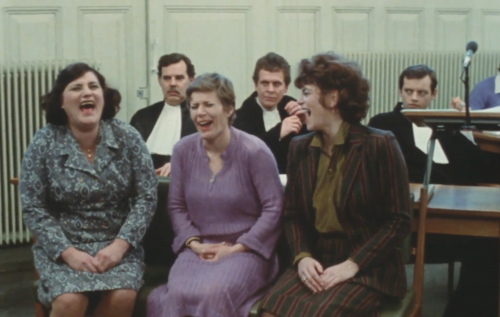
PART ONE: ‘SHE IS CAPABLE OF COMMUNICATION, BUT NO LONGER SEES THE SENSE OF IT’
There are many different threads of silence woven through Marleen Gorris’s De Stilte rond Christine M. (1982), a “feminist thriller” which was the Dutch writer-director’s first film.[1] There’s silent obedience, but there’s also silence as a technique of interruption, and silence as a wilful refusal. There’s the silence of complicity within an unjust system, but there’s also the silence that is the condition of listening. There are oppressive and exclusionary silences that are imposed from above, and there are silences of attention, protection, intimacy and solidarity.
Released in English as A Question of Silence, the film tells the story of three middle-aged white women, strangers to each other, who brutally murder a male shopkeeper. They’re all browsing in a clothing boutique in central Amsterdam, when one of them is caught shoplifting. As she is confronted by the shopkeeper, the others silently join her and assemble around him, with a solemn sense of ritual purpose. Without exchanging any words, the three women begin their assault, beating the man to death with whatever is at hand: mannequin, shopping trolley, coat hanger, shards of a broken glass display unit, stiletto heels. The attack is hyperbolic in its brutality, but the film keeps all the gore out-of-shot: while the man is on the floor, the camera remains at the height of the women who tower over him. The live soundtrack is also muted under a cheesy ‘thriller music’ score, adding to the deliberate indirectness of the depiction, so the event is planted in a separated, almost allegorical realm.
The murder has already happened when the film begins, and the women are all taken into custody in the opening scenes. They make no attempt to resist the arrest or deny their involvement, but during the trial and in the lead-up to it, they refuse to speak to anyone about the circumstances of the crime. With much of the film being built out of flashbacks, we gradually learn about the lives of these women. The shoplifter Christine Molenaar – the ‘Christine M.’ of the film’s Dutch title – was a housewife with three noisy children. Sometime before the killing, she had given up speaking. Her husband comments that she “never had much to say”, but also that he thought she should have kept the children more quiet, so that he could relax when he got home from work, especially considering that she “didn’t have anything to do all day” anyway.
Then there’s Annie Jongman, a divorcee who lived with her cat and served tables in a café in the Jordaan, which was then a working-class suburb of Amsterdam. In contrast with Christine’s silence, Annie is disarmingly boisterous, with laughter never far from the surface. But while Christine’s homelife is depicted as relentlessly loud, Annie’s is uncomfortably quiet, with haunting memories of her former marriage flooding in once she finds herself alone in silence. The third woman involved is Andrea Brouwer, who worked as an executive secretary in an all-male firm, where her high level of competency only exacerbated the patronising contempt that she was up against. In an office meeting, we witness how her voice immediately produces impatience. Her boss interjects with, “Could you be brief?” as soon as she speaks, but then, predictably enough, when one of the men repeats what she just said, as if it was his own contribution, there are suddenly receptive ears for the idea.[2]
In the beginning, the women are all isolated in their varying conditions of silence – but the silence gradually becomes more collective, and more like an active practice. It spreads from Christine out to Annie and Andrea, who join in a silent recognition, which is also a recognition of silence. Through the fragmentary flashbacks to the scene of the crime, we eventually learn that the silence also reached four other women who happened to be in the shop at the time. These unnamed strangers did not participate in the attack, but they witnessed it, in attentive silence, and none of them reported what they saw. No words were exchanged between any of the women, but somehow a silent pact was formed, where silence would also become a means of protection; the ones who committed the crime will say nothing about the ones who saw them do it, and the ones who saw them do it will keep quiet about what they saw.
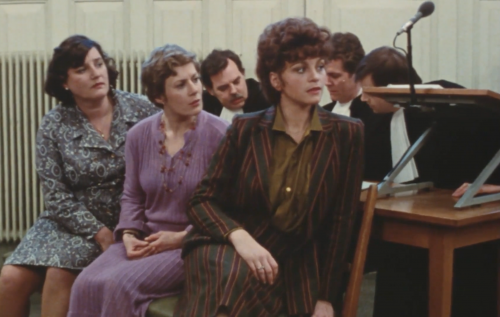
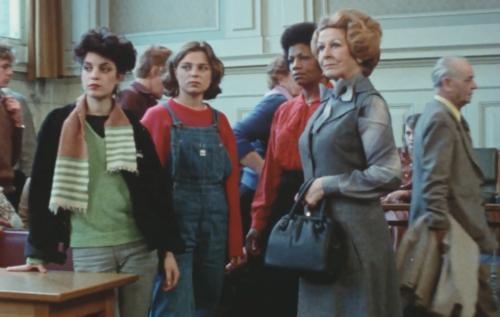
While the three killers are awaiting their trial, a court-appointed psychiatrist named Dr. Janine van den Bos is tasked with producing psychological reports on them. She tries to conduct interviews, but struggles to make progress. Annie is overly loquacious, going constantly off-topic, while Christine remains inscrutably withdrawn. Andrea, meanwhile, treats language as a site of play, where her words can flow as easily as Annie’s, but be as opaque and disorienting as Christine’s silence. Dr. van den Bos keeps showing up with her tape recorder, but she’s met only with silence, distraction, contradiction and obfuscation. Language isn’t working the way she wants it to; it’s either missing, or it’s misleading.
The film initially presents Dr. van den Bos as a comfortably middle-class woman who has ‘made it’ in a man’s world. She’s called upon to give her expert opinion within the judicial system; she speaks and is heard, or so it seems. But through her encounters with these women, she comes to realise that even she only ‘has a voice’ when she says what the men around her want to hear. By the end of the film, when her psychological assessments deviate from the court’s expectations, it becomes very clear that as soon as Dr. van den Bos goes off-script, all the old techniques of patriarchal silencing immediately come back into effect: she’s ignored, dismissed as incapable of objectivity, ridiculed for being concerned with trivialities, spoken over, and shouted down – or she has words put in her mouth, which is another way of ensuring that what she is actually saying goes unheard.
The force of collective silence gradually reaches the psychiatrist, as she comes to appreciate just how dysfunctional verbal language can be – and how much can be communicated without it. At one point in the film, she’s up in the middle of the night, remembering her unproductive interviews with the women. A rapid montage builds up, with repeated shots of Dr. van den Bos turning her head away from the camera, interspersed with flashbacks of the other women also turning away, so we see the backs of their heads, one after another. The hallucinatory editing brings their bodies into alignment, via this simple gesture of withdrawal. Far from being a withdrawal into apathy or pure negation, though, turning away will turn out to give rise to a whole new set of relations. The film’s final shot is Dr. van den Bos turning away from her lawyer husband, in order to face the group of women who were the silent bystanders at the scene of the murder. The shot freezes, and the credits roll over her face, which shows a sort of mesmerised silent acknowledgement, where her reorientation has opened up another world of possibility.
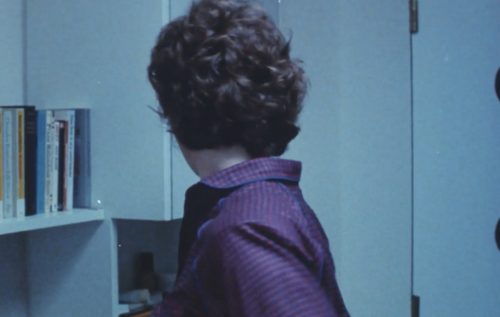
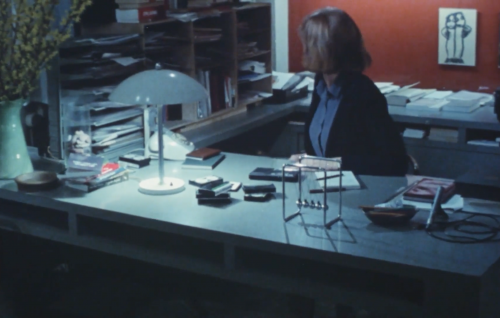
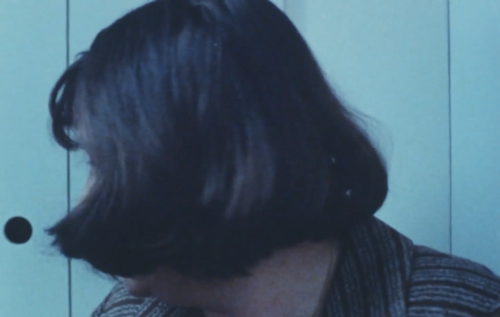
*
A Question of Silence has always been a divisive film. A report on its reception in the UK – by Jane Root from the feminist distributor Cinema of Women – relates how a Pizza Hut restaurant next to a cinema where the film was showing ended up full, night after night, of couples in heated arguments about what they had just seen.[3] As far as the critical reception went, there were some very positive responses, and then there was a lot of male hysteria. Writing for The Observer, Philip French called the film “inherently stupid” and “the unacceptable face of feminism”. Stanley Kauffman for The New Republic: “an atrocity”, “vicious”, “vile” and “entirely loathsome”. Milton Schulman for The Standard: “genocide is a comparatively modest moral device compared to the ultimate logic of this film’s message”. John Coleman for the New Statesman: it “tries to catch my gender in a Catch-22. To hell with it.” [4]
According to Marleen Gorris, the film was most deeply misconstrued within the Dutch context. “I was accused of depicting all this horrific violence,” she remembers. “There were these outraged descriptions of blood being splattered everywhere––when in reality there’s not one drop of blood shown in the film! All of that was put there by the viewer, so it was really a testament to the power of suggestion.”[5]

Meanwhile, user reviews on IMDB show that the film continues to produce confused vitriol. Among many favourable responses, there are some with titles like Insulting and Annoying and Dangerous propaganda from ill minded feminists. “The movie doesn’t even try to justify itself, or to present the subject from a male’s point of view,” one bemoans. “The film still needs work,” declares another. “You don’t excuse a criminal instantly because they were supposedly oppressed.” Again and again, claims that the murderers would be “proven right” or “instantly excused” are flagged as implausible and morally reprehensible.
What these unhappy viewers consistently miss is the fact the women in the film make absolutely no attempt to defend the violent crime. On the contrary, when the trial comes around, Dr. van den Bos actually refuses to diagnose the mental health of the murderers in a way that would imply any diminished responsibility. The male judge and public prosecutor try to convince her to designate legal insanity to the defendants, and thereby minimise the sentencing, but she is adamant that “the three women are completely sound of mind.” When the judge and prosecutor attempt to turn to Christine’s silence as proof of some mental incapacity, the psychiatrist informs them that the silence is in fact a choice she has made, that “she is capable of communication, but no longer sees the sense of it.”
With ‘madness’ being constructed as a non-insurrectionary category, the authorities want to dismiss the crime as a hysterical outbreak – one that was wholly irrational and essentially meaningless. But Dr. van den Bos has moved towards what could be characterised as an anti-psychiatry position, where the pathologised behaviour of the individual is inseparable from the oppressive structures of their society. Christine’s silence begins from her realisation that, as Annie puts it, “nobody is listening.” In refusing to grant the diagnosis that the court is trying to impose, Dr. van den Bos wants to listen more carefully to the silence; and to acknowledge that the women’s experiences of it have been culturally, politically, and historically determined.
The history of silence under patriarchy is of course long and multifaceted. One brilliant partial account of it can be found in Anne Carson’s essay The Gender of Sound, where she reads Ancient Greek sources alongside some more recent anecdotal and literary materials, and traces a continuing attachment in patriarchal cultures to the masculine-designated virtues of self-control and self-containment.[6] Carson argues that women (and whoever else is outside the exclusionary category of ideal masculinity––in the Ancient Greek context, she names “catamites, eunuchs and androgynes”) are associated again and again with disorder and verbal incontinence. Woman is “that creature who puts the inside on the outside,” Carson finds. “By projections and leakages of all kinds––somatic, vocal, emotional, sexual––females expose or expend what should be kept in.” They are like “leaky vessels” who need to be shut up––as per Sophocles’ dictum that “silence is the kosmos [good order] of women.”

The imposition of silence has obviously been indispensable in keeping huge portions of humanity away from public life and out of the history books. At the same time, something else that Gorris’s film understands is that if we only associate silence with powerlessness, isolation, inaction and irrelevance, we disregard the many expressive practices that have long subsisted within the absences that run through the historical record. As Adrienne Rich puts it in her poem ‘Cartographies of Silence’ (1975):
Silence can be a plan
rigorously executed
the blueprint to a life
It is a presence
it has a history a form
Do not confuse it
with any kind of absence
Power doesn’t only impose silence on its subjects; it also imposes discourse – and Gorris’s film shows that within the state’s psychological-judicial discursive regimes, there can be disruptive agency in silence. In a later essay called Variations on the Right to Remain Silent, Anne Carson looks to Joan of Arc, as she is forced to speak, during the inquisitions that led to her death sentence in 1431. Carson finds the voice-hearing, cross-dressing, illiterate peasant girl warrior surrounded by relentlessly prodding and coercive authority figures, all demanding “a conventional narrative that would be susceptible to conventional disproof”. But Joan of Arc responds to their questions with statements like “That does not touch your process”, “I knew that well enough once but I forget”, and “Ask me next Saturday”. Where her words carry silences, they mark a rejection of the demands for total transparency and translatability; and this is what Carson identifies as Joan of Arc’s “rage against cliché” – her refusal to maintain the status quo by regurgitating its inherited grammars.[7]
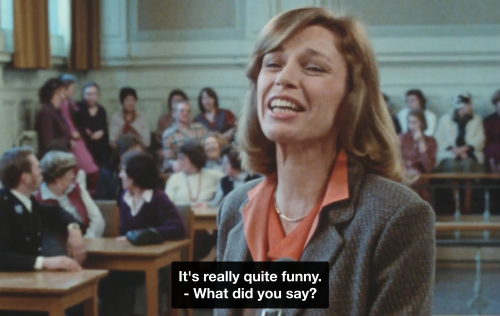
PART TWO: ‘SERVING THE UNCONTROLLED NOISE’
The most memorable scene in A Question of Silence comes near the end of the film, when the women are on trial. They have been watching the court proceedings in silence, seemingly bored and disengaged, occasionally showing signs of mild amusement. During his exchange with Dr. van den Bos, the obnoxious and increasingly incensed prosecutor insists that the genders of the murderers and their victim are irrelevant – that it would make no difference whatsoever if it had been three men who had killed a female shopkeeper. And then it begins: this dubious call to neutral reversibility suddenly sets off an eruption of laughter, starting with one of the women on trial, before spreading to all the other women in the courtroom, eventually reaching Dr. van den Bos herself.
As the laughter takes hold, things start to get out of hand. Dr. van den Bos tries to explain to the baffled and indignant judge that “it’s really quite funny––”, but she can’t get the words out properly, and in any case the room has become so loud that he can’t hear what she’s saying. The women on trial are eventually led out of the court, in joyous collective mirth, as the other women walk out together voluntarily, leaving the unamused men to continue with the proceedings on their own. “The case will continue in the absence of the defendants,” the judge announces, redundantly.
Laughter, here, is not something that exists alongside or in addition to words; it’s something that causes a total breakdown in their fundamental function. And while it begins in this scene in response to what has been said, it soon becomes the sort of laughter that leaves its subject behind, as laughter itself turns out to be the funniest thing. There’s a passage in one of Kafka’s letters that always cracks me up, where he describes a time when he was overcome by laughter while his boss was giving a dreary official speech. At first, Kafka laughs appropriately at the occasional little jokes in the speech, but then he laughs too much at them, and eventually he finds himself laughing “not only at the current jokes, but at those of the past and the future and the whole lot together”. Ha. Laughter arrives as an affront to rationalisation; it disorders chronology, undoes causal relations, and overrides explanation. As Kafka recounts, “I produced innumerable excuses for my behaviour, all of which might have been very convincing had not the renewed outbursts of laughter rendered them completely unintelligible.”[8]
In 2014, the Greek artist-activist collective Mavili deployed laughter as a deliberately counter-linguistic tool, in a political intervention they planned at an EU conference in Athens called Financing Creativity.[9] The conference was supposed to address future models for cultural policy, but the role of culture was understood exclusively through the logics of entrepreneurship and economic growth, and no artists were invited as speakers. In response, the Mavili Collective called for artists from different fields to attend the proceedings and participate in a group action where their discontent would be given the form of collectively embodied and infectiously dispersed laughter.
In grainy documentation from the conference, which Mavili posted on YouTube, the then Minister of Culture is giving his opening speech on the auditorium stage.[10] As he is pompously emphasising the importance of commercial competition between nations, he is interrupted by an outburst of laughter from audience members. He tries to continue, but disorder is unleashed. With more than a tinge of panic, he launches into an aggressive and highly revealing tirade, calling the laughing members of his audience “syndicalists” and “irresponsible cowards”. “Have the bravery of public speech”, he implores, “take the floor if you dare, face me directly and don’t hide behind the crowd.” But the collectivising and decentralising force of laughter continues. “I do a political act, what you do is uproar,” the man shouts, “you are not artists, you serve the uncontrolled noise!”

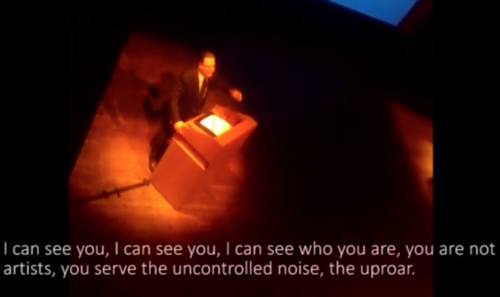
This “uncontrolled noise” is, of course, precisely the point. As with the affectively contagious eruption of laughter at the end of A Question of Silence, the assertion of laughter at the conference affirms that when language operates in a closed system that only reproduces its own terms, the political value of an expression can lie not in its semantic content, but in its capacity to interrupt the system’s conditions of exchange. Judith Butler argued as much in a recent lecture, where they posited that laughter’s critical potential lies precisely in its existence “beyond the spheres of communication and control”. As an involuntary bodily expression whose aim is not to impart a pre-determined idea, laughter, Butler suggested, can function as a mode of “extra-parliamentary political eruption and disruption”, where the loss of control has “expressive value and meaning that is quite separate from what the deliberate ‘I’ has to say.”[11]
Writing about A Question of Silence for Artforum in 1983, the artist Barbara Kruger described the laughter at the end as “a flood of ticklish escapes from the sombre rigor of ‘reason’,” noting that at each screening of the film that she attended in New York, “this infectious rupture spread to the theatre audience, producing a moment of stunning solidarity.”[12] From positions of domination based on operations of containment and control, the arrival of this kind of laughter is obviously deeply worrying. In her essay The Value of Laughter (1905), a 24-year-old Virginia Woolf observed that all the pompous conventions of masculine authority “dread nothing so much as the flash of laughter which, like lightning, shrivels them up and leaves the bones bare.”[13] This dread understands the way that laughter can cut through pretensions, leaving their absurdities and fragilities exposed. It also understands that laughter can be a contaminating force, and that part of its subversive potential lies in its capacity to produce spontaneous collectivities.
It makes sense, then, that the cackle has been such an indispensable characteristic of the witch as she is popularly feared; as a figure of transgression and scary excess, her capacity for flight and her proclivity for laughter are both signs of her non-containment. Another feminist writer of laughter is Hélène Cixous, whose witchy essay The Laugh of Medusa (1975) is bursting with the vocabularies of volcanic eruption. As the long-excised ‘feminine writing’ breaks through, Cixous tells us, “it brings about an upheaval of the old proper crust, carrier of masculine investments.”[14] In her reading, the powers that have driven women out from history, and from writing, have also worked to separate them from each other, and from their own bodies. The entry of l’écriture féminine would thus establish completely new languages, and new embodiments, through collectivising somatic forces like laughter – or what Cixous terms “the rhythm that laughs you.”
When Cixous promises that this explosion onto the scene of language will “blow up the law to break up the ‘truth’ with laughter,” she could be describing the courtroom chaos that ensues with the outbreak of laughter in A Question of Silence. Throughout the essay, though, Cixous opposes the explosive force of laughter to the condition of silence, which she characterises only as “the snare” that women “should break out of”, so that they can finally arrive into a shared language. This is quite different from Gorris’s richly nuanced treatment of silence, where it can signal subjugation, but it can also be a space of rage, refuge, and intimacy. If we imagine her film’s depictions of silence and laughter with a Venn diagram, the area of overlap is the juiciest bit. The silence and the laughter are both gorgeously defiant, and inscrutable. Both interrupt the flow of words, causing the presiding uses of language to break down. Both radiate outwards, as contagious energies that forge communal bonds, and bring about unreasonably collective modes of embodiment.
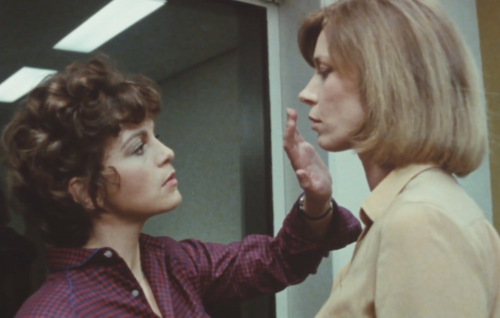
This essay was published by the feminist film journal Another Gaze, to accompany an online screening of ‘A Question of Silence’ at Another Screen. An earlier version of the text was presented at the SOUND :: GENDER :: FEMINISM :: ACTIVISM conference organised by the Graduate School of Global Arts (Tokyo University of the Arts) and Creative Research into Sound Arts Practice (University of the Arts London), at Chinretsukan Gallery, Tokyo, in 2019. A version was also presented as part of the public lecture program for Elena Vogman’s theory seminar at the Weissensee School of Art, Berlin, in 2020.
[1] Gorris had initially approached director Chantal Akerman with the screenplay, but since Ackerman was overcommitted with her own projects she apparently suggested that Gorris do it herself, assuring her that “directing isn’t all that difficult.” Later, Gorris’s 1995 film Antonia’s Line would become the first female-directed feature to win an Academy Award (in the category then still known as Best Foreign Language Film).
[2] “Hepeating” is a word that gained some traction in recent years on social media, to name this still all-to-familiar scenario, which was also parodied in a Punch cartoon where one woman sits in a boardroom meeting with five men, and the caption reads, “That’s an excellent suggestion, Miss Triggs. Perhaps one of the men here would like to make it.” See also: “whitepeating”, when white people take credit for what people of colour said first, or when the words are only heard when repeated by white people.
[3] Jane Root, “Distributing ‘A Question of Silence’: A Cautionary Tale” in Screen (Volume 26, Issue 6, November-December 1985) pp 58–64. The UK distributor Cinema of Women (COW) ran as a feminist collective from 1979 until 1991, releasing a number of feature films and documentaries by filmmakers including Pat Murphy, Heiny Srour, Lizzie Borden, Lynne Tillman and Sheila McLaughlin, Margarethe von Trotta, Leontine Sagan, Audrey Droisen, and Michelle Citron. See Julia Knight, “Cinema of Women: The Work of a Feminist Distributor” in Doing Women’s Film History: Reframing Cinema Past and Future ed. Christine Gledhill and Julia Knight (University of Illinois Press: Urbana, Chicago and Springfield. 2015). Much of COW’s archives, including their files on Gorris’s A Question of Silence, are available via the Film and Video Distribution Database (FVDD) at http://fv-distribution-database.ac.uk.
[4] All quotes taken from Jane Root, “Distributing ‘A Question of Silence’” Op Cit. except for Stanley Kaufman, “Jaundice Posing as Justice” in The New Republic, September 3 1984, pp 24-25.
[5] Conversation with the author, 20 September 2019.
[6] Carson, Anne, “The Gender of Sound” in Glass, Irony, and God (New Directions Publishing, 1995), pp 119-142.
[7] Carson, Anne, “Variations on the Right to Remain Silent” in Float (Jonathan Cape, London, 2016) not paginated.
[8] Kafka, Franz, “Letter From January 8 to 9, 1912 [1913]” in Letters to Felice, eds. Erich Heller and Jürgen Born, trans. James Stern and Elisabeth Duckworth (Knopf Doubleday Publishing Group, 2013) pp.145-148.
[9] Mavili Collective was formed in 2010 with a stated commitment to “produce nomadic, autonomous collective cultural zones that appear and disappear beyond the logics of the market”. See https://mavilicollective.wordpress.com/ (last accessed 1 September 2019).
[10] Accessed https://youtu.be/TYva1Q-u4bk 1 September 2019.
[11] Accessed https://vimeo.com/352083590 10 January 2020.
[12] Kruger, Barbara, “A Question of Silence” in Artforum (Summer 1983, Vol. 21, No. 10).
[13] Woolf, Virginia, “The Value of Laughter” (1905) in The Essays of Virginia Woolf : vol. 1: 1904–1912, McNeillie, Andrew (ed.) pp.58-60.
[14] Cixous, Hélène, “The Laugh of the Medusa” (trans. Keith Cohen and Paula Cohen) in Signs, Vol. 1, No. 4 (Summer, 1976), pp. 875-893.
Hush Now

Terre Thaemlitz, Love for Sale: Taking Stock in Our Pride (Germany: Mille Plateaux, 1999, MP58). CD in jewel case with 1×4 panel booklet insert. Image courtesy of Comatonse Recordings.
Beyond a binary logic where silence is set up in opposition to sound, there is space for amplification and proclamation as well as coded, disguised, whispered and withheld speech. This essay discusses the confrontational and protective silences that have been deployed in the work of Terre Thaemlitz – recalling the audio producer’s proposal, back in 1998, for queer sound as ‘an irresolvable sound which declares its presence at the same time it eviscerates itself’.
‘Hush Now’: Terre Thaemlitz and the Languages of Silence is published as part of Nottingham Contemporary’s ‘Sonic Continuum’ series at The Contemporary Journal.
No Linear Fucking Time
No Linear Fucking Time is a special focus of the online journal ‘Prospections’ at BAK, basis voor actuele kunst, Utrecht, which I co-edited with Rachael Rakes (who has curated the No Linear Fucking Time exhibition and program at BAK with artist-interlocutors Femke Herregraven, Jumana Manna, and Claudia Martínez Garay).
Featuring contributions from (and interviews with): Jason Allen-Paisant, Walidah Imarisha, Elizabeth A. Povinelli, Black Quantum Futurism (Rasheedah Phillips and Camae Ayewa), JJJJJerome Ellis, Elizabeth Freeman, Amiri Baraka, Nina Valerie Kolowratnik, Tiffany Sia, Yuri Pattison, Captain Pro (Promona Sengupta), Adriana Knouf, Marianne Shaneen, and Sam Keogh.
You can read our introduction here and find all the content here.
Image: Graffiti found in Oakland, California in 2020, artist unknown, photograph by Esmat Elhalaby, courtesy Esmat Elhalaby. [Image description: a colour photograph of graffiti on a city wall with the words “no cops no jails no linear fucking time” written in black.]
Silence On The Record
The AIDS crisis: a crisis of homophobia, racism, and poverty; a crisis of social stigmatisation and public indifference; a crisis of religious bigotry, big pharma greed, and government inaction. In November 1987, members of the then eight-month-old grassroots organisation ACT UP (self-described as ‘a nonpartisan group of diverse individuals united in anger and committed to direct action to end the AIDS crisis’) installed Let the Record Show… in a street-level window of the New Museum of Contemporary Art in downtown New York.
Part of the installation included an LED display with text presenting facts about the crisis and the political negligence that was shaping its horrors. The text ends with the chilling silence of President Reagan, who remained unresponsive for years as thousands died from the epidemic. 1981, 1982, 1983, 1984, 1985, 1986, ‘no word from the president.’ In 1987, with 25,644 known dead in the US, the record shows that Reagan announces ‘I have asked the department of health and human services to determine as soon as possible the extent to which the AIDS virus has penetrated our society.’ Let the record show the silence, and all the death that went with it. At the top of ACT UP’s window installation, a neon graphic glowed with the words SILENCE=DEATH.
From ACT UP’s Let the Record Show… installation at the New Museum of Contemporary Art, 1987. Source: The New Museum’s Print & Ephemera collection.
In the first decade of the twenty-first century, the audio art/activist group Ultra-red undertook a series of projects which explored practices of listening, remembrance, and what they called ‘organising the silence,’ in the wake of the most prominent years of the AIDS activist movement.[i] The group was originally formed in 1994 by AIDS activists Dont Rhine and Marco Larsen, and several members were involved with re-launching a Los Angeles chapter of ACT UP in 2004. In order to ‘construct spaces in which our loss and grief can acquire a critical language directed against dehumanisation,’ Ultra-red wrote in a 2005 essay, they sought to produce work that ‘suspends resolution and that employs duration.’[ii]
Ultra-red have recalled that their thinking on silence at this time was informed in part by the different conceptions of silence they encountered in the work of the radical educator and philosopher Paulo Freire. In his early writings on critical pedagogy, Freire described the ‘culture of silence’ that had to be broken, for the liberation of the dispossessed to be realised. Much later in his life, though, Freire also introduced another notion of silence, when he wrote about teachers adopting a ‘discipline of silence’ that would support the conditions of listening.[iii]
For their AIDS Uncanny series in the mid-2000s, Ultra-red made a number of audio works that were concerned with what they termed ‘articulating silence.’[iv] Rather than only being understood in terms of erasure and oppression, silence was approached here as something that could be actively deployed, as an affective space, and as a critical tool. As they wrote at the time, ‘The equation, Silence=Death compels us to fill the silence with voices. However, silence is itself a voice: an object that conditions our interventions whether they be screams of lamentation, rage and its pleasures, or some other action pieced from our current affective state.’[v]
During this time, Ultra-red started to work with John Cage’s ‘silent composition’ 4’33” (1952), re-purposing its durational frame by performing it with a mic in hand at various sites of queer resistance and protest. Recordings from these ‘performances’ feature on the album An Archive of Silence, which was released in 2006 as a free download on Public Record.[vi] Some of the tracks on the album are precisely four minutes and thirty three seconds long; some feature the sounds of protestors chanting ‘silence equals death.’ At the end of the final track, An Epidemic of Silence (4’33”), the voice of John Cage announces, ‘this is the kind of music anyone can make, all you have to do is open your ears and listen.’
The question of how to remember the past while also being able to listen in and to the present was a central concern of Ultra-red’s AIDS Uncanny series – the subtitle for which was time for the dead to have a word with the living. ‘[H]ow grateful would the dead be of our remembrances if we close our ears to the context we occupy at this moment?’ the group asked. ‘Perhaps it is in the nature of remembrance and the affects which demand its labor that our imagination closes itself off from today’s conditions around the crisis.’[vii]
An Archive of Silence is not an archive of empirical content that was fixed into a state of retrievability. In its attunement to present resonance, it’s an archive full of ambience, indeterminacy, and absence. Throughout the tracks on the album, voices are muffled and fragmentary, broken off and looped, sometimes abruptly taken over by white noise. Rather than trying to fill in the gaps of the historical record, this is an approach to archiving that foregrounds its own incompleteness; the result, as the artist Terre Thaemlitz has described it, is ‘an archive of the lack of archive.’[viii]
One of the most moving tracks on An Archive of Silence is A Time to Remember, which is composed entirely of the sounds of different inhalations, arranged into a song. These extra-linguistic resonances––breaths taken before, between or instead of speaking––would usually be counted as silences in the historical record, which is to say they would not be counted at all. But when excerpted and made into a rhythm of their own, they are a reminder of the languages that are developed at the edges, and in the gaps, of the official narrative.
Another release in the AIDS Uncanny series was the compilation album A Silence Broken (2006), which drew on Ultra-red’s recordings from their performance of 4’33” at a queer protest in LA in the year 2000.[ix] A number of queer artists – Soft Pink Truth, Lesbians on Ecstasy, Terre Thaemlitz, Miau Miau TM, Jack Tactic, Death Drive and Pet Shop Beuys – were invited to contribute, with tracks that sampled, remixed or otherwise responded to the field recordings. Across the album, electronic dance music is shot through with the voices of protestors singing ‘silence equals death’ in unison.
‘What do you want people to do with this record?’ an interviewer asked Ultra-Red’s Dont Rhine when A Silence Broken came out. His answer: ‘Radical, ecstatic, critical bodily engagement. Our struggles begin on the surface of the skin.’ According to Rhine, the point was not to communicate a predetermined political message. ‘I am more interested in how music already activates us socially, sexually, intellectually, aesthetically,’ he said. ‘I see all these modes of being – structures of feeling, if you will – as having political currency.’[x]
SILENT|LISTEN graphic courtesy of Ultra-red.
.
SILENT|LISTEN (2005-06) was another Ultra-red work which repurposed Cagean silence as a tool for processing and constituting records of the AIDS crisis. For this project, a series of public meetings were held in art museums and institutions across the US and Canada, bringing together people living with HIV and AIDS, local community organisers, activists, and health-care professionals. Each meeting opened with a ‘performance’ of Cage’s 4’33”, which meant that all present would sit together in silence. Participants would then ‘evaluate the silence’ together, before being invited ‘to enter into the record statements on the AIDS epidemic: where it has been, where it is now, and where it is going.’[xi]
As audio recordings of their statements were made, a fragmentary oral history archive was gradually built up, out of the space of silence. Ultra-red have recalled how the shared listening experience could become ‘a collective object of reflections that binds together those who participate.’[xii] At the same time, they have also described how the range of responses provoked at these meetings would underscore the widely varied and often competing ‘frames of reference, political investments, and strategies of listening’ that were available within the group.[xiii]
Some participants found the silence to be a meditative space; some found it frustratingly awkward and confusing. Some were familiar with the experience of sitting together in silence from religious settings; some knew it from medical contexts, where indefinitely long periods of waiting are involved. Some were aware of 4’33”as a canonical work of avant-garde music; some were not. Some noted how the silence made them more aware of the presence of the other bodies around them; some observed that the silence amplified the sounds of the surrounding art space, and of the city beyond its walls.[xiv]
The title of this project, SILENT|LISTEN, played on the fact that the word ‘silent’ and the word ‘listen’ are anagrammatic rearrangements of each other. In Ultra-red’s graphic, seen above, the word ‘silent’ is spelled out horizontally, and the word ‘listen’ repeatedly intersects it with each of the letters on a vertical axis. The intersections tell us that these two forces run through each other in multiple ways: silence is a precondition for listening, while listening to what is not there, or not meant to be there, can allow for things to be heard in new ways. Silence becomes a shelter in which to meet; not just an emptiness waiting to be filled, but also an invitation to develop new listening practices.
This article was published in the ‘silence’ issue of Simulacrum journal, in the Spring of 2021.
[i] See Ultra-red, ‘Organizing the Silence’ in On Horizons: A Critical Reader in Contemporary Art, ed. Maria Hlavajova, Simon Sheikh, and Jill Winder (Utrecht: BAK, basis voor actuele kunst 2011), 192-209. I also discuss silence in Ultra-red’s work in my essay ‘Organise the Silence’, published in the book Master of Voice, ed. Lisette Smits, (Amsterdam/Berlin: Sandberg Instituut/Sternberg Press, 2020, and some passages from that chapter have been reworked for this text.
[ii] Ultra-red, “Time for the Dead to have a Word with the Living: The AIDS Uncanny,” The Journal for Aesthetics & Protest 4, (February 2005).
[iii] Ultra-red, “Organizing the Silence,” 209.
[iv] Liner notes for Ultra-red’s An Archive of Silence, accessed 10 January 2021. For more downloads in the AIDS Uncanny series see Public Record: Archive.
[v] Ibid.
[vii] Ultra-red, “Time for the Dead to have a Word with the Living”.
[viii] Terre Thaemlitz, “Please tell my landlord not to expect future payments because Attali’s theory of surplus-value-generating information economics only works if my home studio’s rent and other use-values are zero” (2008).
[ix] Ultra-red, A Silence Broken.
[x] Electronic Queer: Broken Silences, XLR8R.
[xi] Ultra-red, SILENT|LISTEN (The Record). The phrase ‘evaluate the silence’ comes from Ultra-red’s reports on the meetings.
[xii] Ultra-red, “Organizing the Silence,” 193.
[xiii] Ibid., 201.
[xiv] Ibid.
Untitled Aerial, 1988/2008
A river, seen from above. Silvery with sunlight, it bends and scatters through a landscape that recedes into a grainy haze. The picture is at once lush and imperfect, contaminated as it is by its own production; as shine bounces unevenly off the water, the light also arrives in reflective streaks on the windowpane that separates the photographer from the scene.
This image is part of Zoe Leonard’s Aerials (1986–89), an early series of black-and-white shots where the artist pointed her camera down from the windows of airplanes toward clouds, natural terrains, cityscapes, farmlands, and bodies of water. As is often the case with Leonard’s photographs, the edges of the negative are left visible in the print, affirming the materiality of analogue photo development and tying the image back to the framing device of the camera. In Untitled Aerial (1988/2008), part of the airplane’s window frame has also made it into the pictorial frame, with the blurred curve at the bottom reminding us of the photographer’s physical presence behind the camera.
The picture doesn’t come from a disembodied nowhere; it’s a view from above which remembers its own situated perspective. Leonard’s work has often returned to the fact that looking at involves looking from; her immersive camera obscura installations from more recent years, for instance, have invited viewers to look while also looking at the conditions of looking.
Untitled Aerial has two dates; the first, 1988, indicates when the photograph was taken, the second, 2008, is when the print was made. Back in ’88, Leonard was increasingly involved in queer activist work, as a member of ACT UP (the AIDS Coalition to Unleash Power) in New York. Her close friend David Wojnarowicz had by this time been diagnosed with AIDS; the illness had already taken his artistic mentor and former lover Peter Hujar, and many in their community were sick, dying, traumatised, mourning.
In her biography of Wojnarowicz, Fire in the Belly, Cynthia Carr recounts Leonard’s memory of inviting Wojnarowicz around to her apartment one day, to show him some work-in-progress from the Aerials series. “I had stacks and stacks of prints all over the floor, and he was so kind,” Leonard remembered. “I confided in him about this conflict I was having as an artist about the intensity of the activist work and the harshness of the reality of the crisis and—I was photographing clouds.” His response, she recalled, was to say, “Zoe, these are so beautiful, and that’s what we’re fighting for. We’re being angry and complaining because we have to, but where we want to go is back to beauty. If you let go of that, we don’t have anywhere to go.”
Writing in the late ’80s about his own work with ACT UP, the critic Douglas Crimp called for an expanded sense of militancy—one that would retain space for mourning and acknowledge a whole range of conflicting emotional states: “frustration, anger, rage, and outrage, anxiety, fear and terror, shame and guilt, sadness and despair” along with “deadening numbness or constant depression”. Rather than dismiss mournful feelings as indulgent or politically meaningless (as in the slogan Don’t mourn, organize!), Crimp insisted that trauma will always move through many different forms, and that the militancy should be able to remember the loss that it arose from.
Across Leonard’s varied practice, rage and mourning register alongside and out of the quietly studious and the visually pleasurable. Her silver river––which Fred Moten sees as “taking topological advantage of the opportunity to get away from itself for a little while”––is displayed in A FIRE IN MY BELLY opposite the exhibition’s eponymous work, an unfinished film from 1986–87 by Leonard’s beloved, lost, and remembered friend David Wojnarowicz.
This text was commissioned for the free magazine accompanying the exhibition A FIRE IN MY BELLY at Julia Stoschek Collection Berlin (on show February 6 – December 12, 2021). Here’s a PDF which includes the German translation.
Fred Moten, “Photopos: film, book, archive, music, sculpture” in Zoe Leonard: Survey (Prestel, 2018)
Douglas Crimp, “Mourning and Militancy” in October (Vol. 51, 1989)
‘A silence other than the one that is imposed’
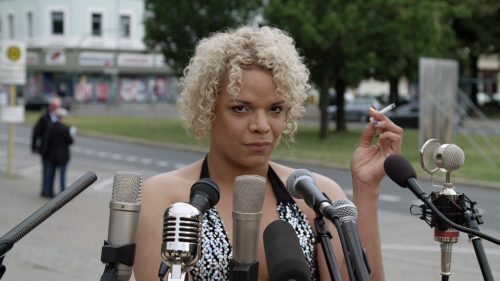 Film still: Pauline Boudry / Renate Lorenz, Silent, 2016, video, 7 min. Performance: Aérea Negrot. Courtesy of the artists and Marcelle Alix, Paris / Ellen de Bruijne Projects, Amsterdam.
Film still: Pauline Boudry / Renate Lorenz, Silent, 2016, video, 7 min. Performance: Aérea Negrot. Courtesy of the artists and Marcelle Alix, Paris / Ellen de Bruijne Projects, Amsterdam.
I’ve written several things around silence over the last year (including texts on Terre Thaemlitz, Ultra-red, and A Question of Silence by Marleen Gorris). This was a talk I gave following a screening of Pauline Boudry & Renate Lorenz’s 2016 video Silent (for clip club at District Berlin), in which the brilliant Aérea Negrot appears surrounded by microphones on a rotating stage at Oranienplatz in Berlin’s Kreuzberg, and remains silent for around four minutes and thirty three seconds …
The silence that Aérea Negrot performs in Pauline Boudry & Renate Lorenz’s video Silent (2016) demands that we see it as more than a homogeneous absence. In a single shot, we watch the vocalist move through a richly textured procession of silences–some of them private and inscrutable; others lush and expressive. We see agency, strength and pleasure, as well as traces of vulnerability and pain. There’s hesitation, preparation, flirtation, awkwardness, and amusement. There’s contemplation, there’s distraction, and there’s disinterest.
At one point, Negrot smokes a cigarette with a sort of cinematically coquettish contempt, blowing smoke into one of the microphones in front of her, instead of giving her voice to it. Later there’s a moment of extreme pathos, as the silent singer wipes tears away from her eyes. What registers at first as something like stage fright, then starts to appear more like an active strategy, with silence emerging as a conscious technique of delay and refusal. Throughout, there’s a fluidity across and between not being able to say, not being ready to say, not being permitted to say, not knowing what to say, not wanting to say, wanting not to say, and wanting to be attuned to the unsayable.
Silence isn’t simply a problem to be overcome – it’s also a solution to the problem that is presented by the array of microphones pointing in the performer’s face. There are no less than ten mics following her on the rotating state, all varied models, presenting a spectrum of technologies, as if to ensure total capture of her voice. There is of course violence in having one’s voice silenced, but there can also be another sort of violence in being forced to speak, and one way to respond to the burden of enforced speech is to hold on to one’s silence, to try to find what the poet M. NourbeSe Philip has called “a silence other than the one that is imposed.”[1]
Negrot interacts with the demanding mics in front of her several times throughout her performance of silence. She taps one of them for a mic test, as if she’s about to begin, but then she decides against it. She grabs a few mic stands, half-heartedly tries to adjust them, but then changes her mind. She leans into one of the mics, poised to speak, but then she moves over to lean into a different one, and then a different one, and then she gives up – there’s too much choice, too many microphones, too much expectation.
After about 4 minutes and 33 seconds of Negrot’s silence, a song starts. At first it’s acousmatic and disembodied, but then we cut to the performer sitting on a bench, in the same public square, now off-stage, away from the microphones, with her private headphones in her ears, singing a song that she composed specifically for this work by Boudry & Lorenz. “Dear president,” she sings “You have no arms no head no legs and no sense” “your enemy is your lover, I need make-up, underwear, and hormones”, “dear visitor, are you optimistic, when our country is at war?” “what is the difference between museum, artwork, and enemy? it sounds all the same to me”.
Silence and sound are not mutually exclusive here, they exist in and through each other. The silence can be full of expression, while the words can carry layers of opacity. One can withheld speech in front of the microphones, but then break into song offstage, with lyrics that include demands for trans rights, and hints at some kind of art institutional critique where museum, artwork and enemy are blurred into each other (keeping in mind that this work is most often seen as part of a video installation in museums and galleries) …
I just mentioned that the duration of the silence before the song starts is around 4 minutes and 33 seconds, and if you do see this work installed in an art institution, when you read the wall text you find an explicit reference to John Cage’s iconic ‘silent piece’ 4’33” (1952). Cage’s composition was originally inspired by his friend Robert Rauschenberg’s White Paintings (1951). Cage saw these blank white canvases as “landing strips” for shadows and dust, whereby the absence of the picture created a situation in which the painting’s unauthored and always-shifting environmental conditions could be perceived in new ways. In a similar spirit, 4’33” was supposed offer an emptied-out sonic field, through which audiences would attune themselves to the incidental sounds of the surrounding environment.
Cage originally conceived the score for classical concert halls, which are spaces where a particular sort of silence is predetermined by the etiquette that requires audiences sit quietly and attentively for the duration of a performance, until it’s time for them to applaud. In contrast, Boudry & Lorenz’s Silent was recorded outside, in public space, where the silence is much less loud, because it’s in the midst of passers-by who may or may not even notice that a performance is happening.
The film was shot at Oranienplatz, the public square in Kreuzberg that has been a crucial gathering point and symbolic centre of the OPlatz refugee protest movement. The movement dates back to 2012, when precarious and undocumented migrants and asylum seekers around Germany travelled to the capital, in defiance of the residence obligation that prohibited those seeking asylum from leaving the districts assigned to them. From 2012 until 2014, thousands of activists and supporters were part of a protest encampment occupying the square.
 Tribute to Napuli Langa at Oranienplatz, Berlin, September 2021. Photo: A. Groom.
Tribute to Napuli Langa at Oranienplatz, Berlin, September 2021. Photo: A. Groom.
The tents were forcibly cleared in 2014 – two years before Lorenz & Boudry filmed Silent – but over the years the square has been intermittently reactivated as a refugee rights information point and centre for community gathering and public actions. Just last month, the activist Napuli Langa climbed one of the large sycamore trees in the square and she sat in its branches, in the rain, for six days, until the Friedrichshain-Kreuzberg district was forced to grant refugees the permanent right to protest at the square. This was a re-enactment of a five-day protest she had done back in 2014, during the evacuation of the camp, when she climbed the same tree and stayed there until the district granted open-ended approval of the right to continue protesting at the site.[2] Seven years later, when they tried to rescind this decision over a bureaucratic formality, Langa went back up into the branches and refused to come down until the district reinstated a legally binding approval of the right to protest at Oranienplatz.
So this is a highly contested public site, far removed from the decontextualized concert hall for Cage’s original 4’33”, a hushed and closed-off space that could be anywhere. Cage had also been interested in taking 4’33” out of its initial context in the concert hall. There are recordings of the empty composition which he made in his Sixth Avenue apartment, with the ambient sound of the city playing out as background turned into foreground. But Cage’s project always tended toward the transcendental.[3] According to the composer, what he liked about listening to the traffic outside was that he could experience it as pure noise, without any contamination from narrative, style, or technique – without, in his words, “the feeling that someone is talking”[4] …
But of course someone is talking! The sound of the city is the sound of an amalgamation of subjects, messages, talents, intentions, feelings and techniques. What a feat it was for him to drain all this out! A feat that depended on an active denial of complexity, and a particular sort of subject position – one that was able to experience the soundscape of Manhattan as completely depersonalised and frictionless, to hear the alarms and sirens as neutral and devoid of narrative, and to imagine that emptiness could be smooth, universal, and uncluttered by specificity.
 Charlotte Moorman’s setup for John Cage’s 26′ 1.1499″ for a String Player at WNET studios, 1974. Courtesy of Charlotte Moorman Archive, Northwestern University Library.
Charlotte Moorman’s setup for John Cage’s 26′ 1.1499″ for a String Player at WNET studios, 1974. Courtesy of Charlotte Moorman Archive, Northwestern University Library.
Speaking of cluttering, I’m going to turn to this image showing the cellist and performance artist Charlotte Moorman’s set up for a performance of Cage’s composition 26’1.1499”, on public television in 1974. 26’1.1499” was a composition for a solo string player, from 1953. Like 4’33” from the previous year, this piece was named after its intended duration, twenty-six minutes and 1.1499 seconds. It was not an empty composition, like 4’33”, but in both pieces the self-referential, numerical title was meant to keep external meaning and narrativization at bay. Also in keeping with the ethos of 4’33”, there were parts of this score which required interpretative collaboration from the performer, who was explicitly called upon to bring extra-instrumental and non-musical noises into the performance.
As she worked on 26’1.1499” throughout the 1960s and 70s, Moorman gradually contaminated its contents with spoken word interventions, where she would recite fragments of text that she collected over the years. As music historian Benjamin Piekut has chronicled, various clippings from newspapers reports, advertisements and other ephemera were stuck into the pages of Moorman’s score––including instructions for how to insert tampons; an advertisement for comfortable women’s underpants; a classified birth control announcement from Planned Parenthood; the title of the 1965 film How to Murder your Wife; as well as newspaper articles about Watergate; cuts to Medicare benefits for the elderly; and an attempted rape on a university campus. There’s also a page in Moorman’s version of the score where she lists ideas for “other sounds”, with a sub-entry on “people sounds” which includes: orgasms, laughs, newborn baby cries, hiccups, and “flatulent lady.”[5]
The photograph of Moorman’s set-up for a performance of the piece on public TV (above) shows colourful trinkets, toy missiles, balloons waiting to be popped, and, at the front of the stage, a carton of eggs which would be fried during the performance–all indicating a scene of exuberant cacophony that would be entirely at odds with Cage’s serene abstractions. And indeed, Moorman’s work was met with strong disapproval from Cage and his inner circle. In 1964 the composer’s friend Jasper Johns wrote to him in a letter that “C. Moorman should be kept off the stage.” In 1967 Cage commented that he thought she was “murdering” his piece, and in an interview in 1991 he recalled “I didn’t like it at all. And my publisher said, the best thing that could happen for you, would be that Charlotte Moorman would die.”[6]
They despised what she was doing, but from her perspective she was being wholly faithful to the composer’s principals. Her copy of the 26’1.1499” score includes a handwritten note reminding her of the Cagean principle, “There is no such thing as silence. Something is always happening that makes a sound.” And this 1974 photograph of her performance set-up shows a prominent framed portrait of the composer, smiling back at the TV audience. Perhaps at this point her relationship with the figure of John Cage had gone beyond earnest tribute and into something more like conscious trolling, but the fact is that her development of the 26’1.1499” piece did not transgress its instructions. The score explicitly calls for sounds other than those produced on the strings of the instrument, and this prompt is explicitly left open to interpretation by the performer.
It’s really Cage who transgresses his own stated principals when he dictates what should or shouldn’t be included in performances of his work. He was interested in chance and open-endedness, but then he was weirdly prescriptive about what that could mean. He was unconventionally generous in the amount of interpretive freedom that he granted to performers of his work, but then, as he once qualified, he also felt that “When this freedom is given to people who … remain people with particular likes and dislikes, then, of course, the giving of freedom is of no interest whatsoever.”[7]
He wanted to open the work up, to break down the boundaries between the art and the life surrounding it, between what counts as music and what doesn’t, between the artist’s intentions and the incidental sounds of the world. But then he insisted that the world which penetrated the frame remained uncluttered, so that when a woman brought in content relating to menstruation, contraception, abortion, rape and femicide, she was “murdering” the work, and the best thing that could happen for the work at that point would be “for her to die”. The work should be open to the world, says Cage, but open only in a specific sort of way––and only to a specific sort of world. Basically: anything can be music and anyone can make music, but please no flatulent ladies!
*
In a 1977 essay for Artforum, the feminist art historian Moira Roth identified Cage and a selection of other influential downtown New York white male artists from the 1950s and ‘60s as proponents of what she termed the “aesthetic of indifference.”[8] Trying to come to grips with their valorisation of negation and passivity during the McCarthy period, she emphasised the pervasive sense of political paralysis that many Americans felt during this era of hysterical patriotism and persecutory right-wing fervour.
Later, in the 1990s, after Cage had died, the queer theorist Jonathan D. Katz drew out Roth’s analysis while considering the sexual politics of Cagean silence.[9] Katz reminds us that the McCarthy era was characterised not only by anti-communism but also by rampant homophobia. The Red Scare overlapped with a Lavender Scare in hateful cultural anxiety about America’s dangerously invisible enemies who could operate in society’s midst. According to this paranoic current, the queers and the commies were enemies who could hide in plain sight, recruiting new members and corrupting family values from within—so fighting their existence meant first detecting and exposing them.[10]
Silence, in this context, was obviously highly complicated. It was a protective shield, but it could also energise the homophobic hatred, because the same silence that was imposed was also perceived as a power and a threat. For Katz, we should understand Cage as part of a pre-Stonewall generation of gay man in America, for whom silence was a strategy of subsistence, a symptom of oppression, and also potentially a space of oppositional existence.
Towards the end of Cage’s life, silence would become amplified as a queer political issue during the AIDS crisis. A brutal unspeakability had long been enforced around “the love that dare not speak its name” —instilling shame and confusion, feeding into fear and censorship, leaving abusers unaccountable, depriving queers of their history. With AIDS the silence became literally lethal, and the rallying call Silence=Death would become synonymous with the AIDS activism movement. Cage, evidently unwavering in his commitment to the “aesthetic of indifference”, wanted nothing to do with this explicit politicization of silence. When he was confronted by a protestor chanting “silence equals death” during a public symposium on his work, not long before he died in 1992, his response was to say, airily, “in Zen, life equals death.”[11]
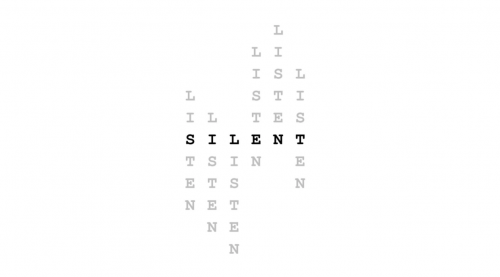 SILENT|LISTEN graphic courtesy of Ultra-red.
SILENT|LISTEN graphic courtesy of Ultra-red.
I have written elsewhere about this graphic by the sound artists and political organisers Ultra-red, which shows us that the word silent and the word listen are made up of the same letters. SILENT|LISTEN was one in a series of works where Ultra-red re-purposed the durational frame of Cage’s 4’33”, taking it up as a critical tool for recording and processing the history and ongoing ramifications of AIDS – performing the composer’s ‘silent piece’ with a mic in hand at various sites of queer resistance and protest in Los Angeles, and building what they called an ‘Archive of Silence’ from a series of public meetings where survivors would gather and listen together to the framed silence of 4’33” before discussing the AIDS crisis, “where it has been, where it is now, and where it is going”.[12]
As with Ultra-red’s use of 4’33”, Boudry & Lorenz’s Silent makes for a drastic departure from Cage’s high modernist end-game gesture. While Cage promoted an aesthetic of transcendent anti-expressionism, Negrot’s performance of silence is unapologetically expressive, and clearly situated in a particular body at a particular site with its particular inscriptions and particular erasures of ongoing political struggles. But neither Ultra-red nor Boudry / Lorenz / Negrot had to subvert the basic proposition of 4’33”; while honouring the principle that silence is a precondition for listening, their works expand the application of the durational frame, to affirm that practices of listening to what is not there – or not meant to be there – can allow for things to be heard in new ways.
 Film still: Pauline Boudry / Renate Lorenz, Silent, 2016, video, 7 min. Performance: Aérea Negrot. Courtesy of the artists and Marcelle Alix, Paris / Ellen de Bruijne Projects, Amsterdam.
Film still: Pauline Boudry / Renate Lorenz, Silent, 2016, video, 7 min. Performance: Aérea Negrot. Courtesy of the artists and Marcelle Alix, Paris / Ellen de Bruijne Projects, Amsterdam.
An earlier version of this text was published as a chapter titled “Organise the Silence” in the book Master of Voice, edited by Lisette Smits and published by Sternberg Press in 2020. The book came out of the Master of Voice MFA program at the Sandberg Institute in Amsterdam (2016-2018), where I worked as Theory Tutor. I also presented a version of the text as a lecture for the program Unseen and Unheard, presented by Cashmere Radio as part of Howling Wolf Festival in Berlin in 2019.
[1] M. NourbeSe Philip, “Dis Place – The Space Between in A Genealogy of Resistance and Other Essays” (1997), republished in Bla_K: Essays & Interviews (Book Thug, Toronto, 2017), 275.
[2] An account by Napuli Langa on the Oranianplatz protests and the 2014 tree occupation can be found here https://movements-journal.org/issues/02.kaempfe/08.langa–refugee-movement-kreuzberg-berlin.html See also “Contested Spaces The Oranianplatz Protests, Berlin, 2012-2014” in Steinhilper, E., Migrant Protest: Interactive Dynamics in Precarious Mobilizations. Amsterdam: Amsterdam University Press, 2021.
[3] A text he wrote for an exhibition of Rauschenberg’s White Paintings reads, “To Whom / No subject / No image / No taste / No object / No beauty / No message / No talent / No technique (no why) / No idea / No intention / No art / No object / No feeling / No black / No white (no and).”
[4] See “John Cage – About Silence and Traffic” accessed www.youtube.com/watch?v=H-Xy-gAaOzw February 2019.
[5] Piekut, Benjamin, Experimentalism Otherwise: The New York Avant-Garde and Its Limits (Berkeley, Los Angeles and London: University of California Press) pp 154-155.
[6] ibid, pp 149-150.
[7] Cited in Kostelanetz,Richard, Conversing with Cage, New York: Limelight Editions, 1988, p. 67.
[8] Roth, Moira, “The Aesthetic of Indifference” in Artforum, November 1977, 46-53
[9] Katz, Jonathan D. “John Cage’s Queer Silence; or, How to Avoid Making Matters Worse” in GLQ 5:2 (1999) pp 231-252.
[10] See Johnson, David K., The Lavender Scare: The Cold War Persecution of Gays and Lesbians in the Federal Government, Chicago and London: University of Chicago Press, 2004.
[11] Jones,Caroline A.,“Finishing School: John Cage and the Abstract Expressionist Ego” in Critical Inquiry, Vol. 19, No. 4 (Summer, 1993), pp. 628-665; 665.
[12] Ultra-red, SILENT|LISTEN (The Record) (2006). I wrote about Ultra-red’s uses of silence and 4’33” here.
Enduring Ornament
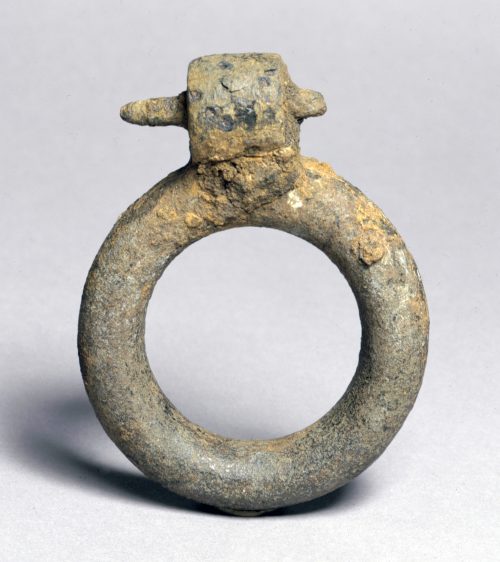 Baroness Elsa von Freytag-Loringhoven, ‘Enduring Ornament’ (1913), found rusted metal ring, approximately 3 1/2 inches in diameter. Mark Kelman Collection, New York.
Baroness Elsa von Freytag-Loringhoven, ‘Enduring Ornament’ (1913), found rusted metal ring, approximately 3 1/2 inches in diameter. Mark Kelman Collection, New York.
‘Enduring Ornament’ is an essay about rust (named after an Elsa von Freytag-Loringhoven artwork from 1913), which I co-authored with M. Ty.
The text is published in the book Weathering: Ecologies of Exposure (ICI Berlin Press, 2020), and can be found in PDF version here and HTML version here.
Abstract: This is an essay about rust. Iron usually plays the part of strength, stubbornness, and impenetrability, but rust registers the dimension of time in the material, reminding us that it always carries the potential for its own decomposition. While great expense is incurred to stave off iron’s oxidization, we read the uselessness that rust precipitates as an interruption of the instrumental logics that sustain racial capitalism. Looking to the rusted ring that became Elsa von Freytag-Loringhoven’s ‘Enduring Ornament’ (1913), we consider how the discarded and defunctionalized lend themselves to ornamental redeployment. The essay then turns to works by the contemporary American artists David Hammons and Andrea Fraser, both of which transform Richard Serra’s rusty steel sculptures into a backdrop for fleeting gestures of impromptu reclamation. Attending to questions of susceptibility and monumental weathering, these reflections look to rusty leakages that play out the impossibility of refusing the environment. Rust, we suggest, is a material archive of exposure that does not keep itself, but flakes apart and seeps away.
Keywords: rust; iron; piss; susceptibility; disuse; red; Minimalism; institutional critique; gentrification; stench
painted full of tongues
On 12 September 2020 I will be hosting a dinner and a talk, on rumour, gossip, hearsay and ‘grapevine epistemologies’, as part of the K 2020 program at Lothringer 13 in Munich. Initiated by the art and research collective K, the exhibition and public program runs from 25 June until 27 September at Lothringer 13 Halle, Lothringer Strasse 13, 81667, Munich.
cave staples
Traveling to Copenhagen for Cave Staples at Peryton. Opening 5pm Feb 22, running until Mar 30 2019. Peryton.dk – Dronningens Tværgade 52, 1302.
DOCUMENTATION >
Laurie Parsons’s “A Body of Work 1987”
I wrote a review of the exhibition Laurie Parsons’s “A Body of Work 1987”, at the Museum Abteiberg in Mönchengladbach, for Art-Agenda – see here.
What might this be?
This is the Makapansgat Pebble. It’s a rock, with a face, and a name. It was found in the Makapan Valley in South Africa in 1925, in a cave that was inhabited by a now-extinct hominid ancestor of the human species, Australopithecus africanus, two and a half million years ago. We know that the pebble’s eyes and mouth were carved out by running water and neighbouring pebbles in a riverbed, rather than by hands. So it’s an image that was forged without any human-like invention or intention. But the cave where it was left is many miles away from any possible natural source, so paleo-anthropologists have speculated that it was picked up and transported, by someone who recognised the chance appearance of a face looking back.
The Natural History Museum in London identifies the Makapansgat Pebble as “perhaps the most ancient art object in the world.” The implication here is that it wasn’t art when it was sitting unnoticed in the river—but when it was pointed to, when it was picked out and displaced, it moved into the realm of artistry. If we accept this, we can say that art doesn’t begin with an act of creating something out of nothing, but with a moment of recognition that is actually a misrecognition: seeing a face where it isn’t, perceiving things as they aren’t. It isn’t inventing something new from scratch; it’s responding to what is already present, and treating it as something else.
I want to read into this capacity (or necessity) we have for reading into things. What does it mean that we can perceive more than what’s there? How much does all language—and all thinking and all meaning-making— depend on our ability to apprehend one thing in another thing? To what extent does perception always bring projective baggage along with it? What are the dangers and predicaments involved with the interpretative projections of our perceptions? And how might they be developed as part of critically engaged practices? Given that every critique of present conditions depends on the basic premise that reality could be otherwise, how can active misrecognition be deployed as a deliberately disobedient mode of looking, where we nurture our capacity to see beyond what it is that we are supposed to see?
In her 1926 essay On Being Ill, a bed-bound Virginia Woolf is looking up at the sky and watching its incessant inventions. “This then has been going on all this time without our knowing it!” she remarks, shocked by the endless array of shapes and scenarios performed by the clouds. “Someone should write to The Times about it,” she decides. “One should not let this gigantic cinema play perpetually to an empty house.”1 There are two factors contributing to her experiencing the sky’s imagery as if for the first time. One is that she has to remain supine, for an extended duration, giving her body a spatial and temporal orientation towards the sky, which is something that isn’t granted to those upright bodies rushing about the city streets. The second contributing factor is the dis-orientation of illness; this is a text about the warped but enhanced sensitivity that can be brought on when we are unwell. Woolf writes of the “mystic quality” that words can come to possess when language is rendered incomprehensible; as when feverish or otherwise delirious states take us to the edges of meaning, where other meanings might emerge.2
Hallucination can be a tricky thing to ascertain the boundaries of, as it will often arise from a combination of external reality with internal processing, and it can overlap with simple misperception. But the perceptual disturbances and persecutory delusions that can be experienced with psychosis or schizophrenia, for example, are largely beyond the bounds of what I want to consider here. There are psychological conditions in which hallucinations are involuntary and harrowing (Woolf wrote in her suicide note of hearing voices)—and then there are much more general experiences of mis-reading or actively over-reading an external stimulus, such as when we ‘see’ faces or animals in the clouds. We might be especially attuned to this sort of over-reading of random details when we are in particular states (when we’re feverish, when we’re on psychedelics, when we’re children, when we’re sleep deprived, when we’re socially anxious)—but we also do it all the time, because perception involves not only the passive reception of external stimulus but also aspects of our own memories and anticipations. To some degree, it is always interpretative and imaginative.
The word ‘pareidolia’ is used for forms that appear to us in places where they were not intentionally inscribed. Some of my personal favourites include: the profile of Mahatma Gandhi that was spotted on the surface of Mars; the partially eaten, decade-old toasted cheese sandwich said to bear an image of the Virgin Mary, which sold on eBay for US $28,000 in 2004; the Mother Theresa cinnamon bun; the chicken nugget that looks like George Washington; the house that looks like Hitler; the videos on YouTube showing Vladimir Putin’s face momentarily appear out of a flock of birds flying over New York City. Whether attributed to human hoax, natural accident, or some divine or paranormal force, all of these allegedly unauthored images can complicate distinctions between design and chance; real and imagined; made and found—reminding us that meaning isn’t something fixed inside the object of observation, but something that emerges from the attentive encounter with it.
‘Pareidolia’ comes from the Greek roots para for ‘beyond’ and eidon for ‘image’—suggesting images beyond images, appearances in excess of themselves. And pareidolic vision is something that can be actively applied, as a way to train the imagination. In his Treatise on Painting, for instance, Leonardo da Vinci told his disciples to look at stains and smudges on dirty walls, or random patterns in rock formations, and to discover in them all sorts of fantastic imagery, such as mountainous landscapes, detailed battle scenes, strange costumes and monstrous faces. Through contemplation of the clouds, or the mud, or the ashes from the fire, he promised, one could “bring out the genius” from “the jumble of things.”
This sort of seeing beyond the image or seeing the image beyond has also been at work in the more wide-spread practices of divination, fortune telling, scrying and the like. One of the most ancient and far-reaching of these practices is tessaeography, the reading of tea leaves or coffee or wine sediments left in cups. But there are countless other techniques, including, for instance, meilomancy (divination by moles), odontomancy (divination by teeth), amathomancy (divination by patterns in dust, dirt, sand or ashes), ornithomancy (divination by birds), capnomancy (divination by smoke), uromancy (divination by urine), urticariaomancy (divination by itches), tyromancy (divination by cheese), macharomancy (divination by swords or knives), driromancy (divination by dripping blood) and styramancy (divination by the reading of patterns left in chewing gum). All of these methods rely on the active and projective nature of perception, and affirm that with the right attunement of attention, anything can be read.
In the early twentieth century, the capacity we have to see things as they aren’t would become the basis of Swiss psychoanalyst Hermann Rorschach’s inkblot test, where subjects are asked to describe/ interpret what they see in a series of cards showing abstract blots of ink. Butterflies, masks, animal hides and vulvas are some of the things test subjects most often ‘recognise’ in the symmetrical blots, but each of the cards was conceived as a site of productive ambiguity. The pictures are effective only insofar as they carry no intended, or intrinsic, or universally agreed-upon, meaning—and can thus catch whatever is projected onto them. “What might this be?” is the question the analyst is supposed to ask the subject upon presentation of each new meaningless inkblot. Not “what is this?”, but “what might this be?”
Pareidolic vision is related to the more general phenomenon known as ‘apophenia’, which is the (not necessarily optical) perception of meanings or connections in random configurations. And like the Rorschach Technique, the neologisms ‘apophenia’ and ‘pareidolia’ both come out of modern psychology—particularly from the study and diagnosis of schizophrenia. But, as we have seen, the relevance of the pareidolic principal is much older and much broader than the pinpointing of the pathologised individual of western modernity. ‘Seeing’ always involves some degree of ‘reading’, and, as Marina Warner has observed, the Rorschach Technique can be understood as simply a scientisation of the existing divination methods that were based on the interpretation of seemingly random data which has no essential or universally accessible significance.3
In an inkblot test, pareidolic perception is supposed to go in both directions, with the subject reading into the shapes and arrangements in order to see more than just ink on the surface of a page—and the analyst then reading into the subject’s responses, interpreting the interpretations in order to access more than just what is consciously presented at a surface level by the subject. In fact, psychoanalysis—as a clinical practice and as a discourse—has always been thoroughly apophenic. We can think here of Freud’s interpretations of dream images, where we are told that all weapons, tools, machines, umbrellas, neckties and nail-files are actually penises—as are mountains, women’s hats, children, lizards and younger brothers.4 We can also think of the Jungian principle of synchronicity, where causally disconnected events are to be read as nonetheless meaningfully related to each other. In a psychoanalytic session, the shrink is supposed to be attentive to otherwise overlooked minor details, and to the links that can be drawn between them. She reads into what seems to be random, and doesn’t allow for things to be taken as arbitrary.
This mode of reading where the insignificant is made to signify is also clearly indispensable to the building of paranoic conspiracy theories—and indeed, in the same text where Freud forms a dubious causal link between paranoia and repressed homosexuality, he also articulates his notion of paranoia as a model for psychoanalytic theorising itself. Later, Paul Ricœur would put Freud in the company of Marx and Nietzsche as the three “masters of suspicion,”5 whose work would usher in what Ricœur identified as a modern school of hermeneutics, wherein the interpreter is suspicious of the intended, established, or immediately legible meanings of things, and looks instead for what else those things might mean—and for what they might exclude or cover up.
One critical project where a conspiratorial imaginary has succeeded with a crucial diagnosis of a previously unnamed condition is feminism, which has long been geared towards apprehending and describing patriarchy as a sprawling system which organises and permeates all aspects of reality, but which could otherwise go undetected in its vastness. This is a point observed by Sianne Ngai in her article Bad Timing (A Sequel): Paranoia, Feminism, and Poetry, in which she looks at reclaiming and reformulating paranoia as a tool for explicitly feminist thought and cultural production. As Ngai writes, terms like ‘patriarchy’ and ‘patriarchy-capitalism,’ “which refer to monolithic, yet amorphously-delimited and fundamentally abstract, value-based systems,” remain indispensable for critical languages that are able to grapple with the realities of our contemporary condition.6
Ngai posits that the paranoic-conspiratorial mode is particularly adept at zooming out from one historical trajectory and looking at what else we can see happening at the same time. This is a manoeuvre that can be extremely revealing not just for critical intervention in late capitalist culture but also as part of a historical methodology, as in Silvia Federici’s Caliban and the Witch, where she shows how completely intertwined the history of witch-hunting in Europe is with the simultaneous implementation of capitalist logics in the transition away from feudalism. This was a seriously under-acknowledged correlation, which Federici draws out in convincing detail through appropriately applied suspicion, an attunement to the ‘bigger picture’, and rigorous pattern recognition.7
But, as productive as these paranoic modes of seeking and organising knowledge can be, the instances where the conspiracy theories match up with the actual conspiracies are rare, and the field is rife with reactionary politics. As several writers on the topic of paranoia in political discourse have observed, it can be claimed just as easily by the right as by the left.8 Suspicion can be appropriately directed towards ruling class ideology, for instance, but suspicion can also be deeply xenophobic. It depends on who’s using it and what their motivations are—and in particular on whether they’re up for real structural critique, or whether they’re simply on the hunt for individual monsters to scapegoat.
As Karl Popper observed in his 1945 book The Open Society and Its Enemies, conspiracy theories have often tended to emerge where fear-based tribalist and nationalist mythologies take hold.9 Quite apart from marking a healthy questioning of the official narratives or a non-acceptance of that which hegemony wants us to believe, the conspiracy theorist’s insistence that every little detail is part of some greater plot—with an invisible but omniscient power working from above—can actually have the same pacifying effect as religious structures: the fatalism negates any individual or worldly responsibility. If the powers-that-be are so immense and overarching, and the outcomes so assured, there’s not much that we down here could do to go off-script.
If you’ve spent any time dipping into online conspiracy-theory rabbit holes you will have seen how quickly things can turn ugly—like when they suddenly start replicating old-school antisemitism, only thinly veiled if at all. Perhaps without the conspiracy theorists always being aware of it, many of their tropes come straight out of The Protocols of the Elders of Zion—except that instead of saying ‘the Jews’ they might say ‘the Illuminati’ or ‘the New World Order’ or ‘the Lizard People’. Part of what these theories do is relieve their adherents of the burden of doing any actual structural critique: to believe that one evil Jewish group controls all institutions and secretly runs the world, for instance, would be to never have to grapple with actual historical forces and the intersections of real structural inequalities—let alone to try to deal with the ways in which one may also be implicated in those forces and structures.
Pareidolic misapprehension can also be dangerous when it is paired with bigoted prejudice at the level of individual encounters. Think, for instance, of the sort of pareidolia that is at work when a US police officer who has shot yet another unarmed Black man stands up in a court of law and claims innocence, on the grounds that they thought they had detected something suspicious—that they thought they had seen a weapon in what turned out to be a wallet, or a cell phone, or a sandwich. Part of what we have to deal with here is the effects of an uneven distribution of suspicion. When certain bodies are seen as already suspect and out-of-place, just walking to the grocery store, at night, in a gated community, is enough for an unarmed Black teenager like Trayvon Martin to be shot dead by a neighbourhood watch volunteer operating under the dubious authority of suspicion—and for that suspicion to count as legitimate grounds for their acquittal. Racism can be thought of as a type of pareidolia; a perceptive mode that carries a lot of projective baggage—and, evidently, it can also be a justification for murder (“I’m not really a killer, it’s just that my racism led me to misread the situation”).
On a structural level, it is also necessary to think about the extent to which the field of the visible is itself racially produced and ordered—so that racism can determine what appears, as well as what doesn’t. In the infamous case of the Rodney King trial, for example, the white jurors had been unable to ‘see’ what for so many had appeared self-evident in the video footage, which shows King motionless on the ground as he is brutally beaten by a group of policemen and their batons. Writing in the wake of that trial, Judith Butler considered what she termed the “saturation and schematisation of the visual field with the inverted projections of white paranoia,” wherein the image of a black male body being repeatedly beaten by policemen standing over him can become evidence that the man had in fact been a danger to the police, who were his vulnerable victims. Importantly, Butler observes, the jurors didn’t fail to recognise the brutality because they ignored the video, but because the video was framed within a racially structured field of visibility. While the prosecutors had presented the footage as if it ‘spoke for itself’, the defence attorneys had performed interpretative manipulation, deliberately cultivating the white paranoia that would read King’s body as threatening—and thereby reminding us that within a racialised episteme, the visible cannot be taken for granted as evidence.10
So as we’ve seen, suspicious over-reading can be applied to oppressive systems in ways that can help us to better identify their inner workings— but suspicious over-reading can also be found operating at the cores of those systems, and emerging in their symptoms. Besides white paranoia, we might also think of the paranoic tendencies of super wealthy one percenters, or of so many despots throughout history. In Italo Calvino’s short story A King Listens, we meet a ruler who sits alone on his throne, unable to move for fear that someone else will take his place.11 With his dungeons filled with suspected supporters of the previous, deposed sovereign, the king’s constituted power amounts to a totally rigidified isolation, where all he can do is try to listen to what he thinks he might be able to hear. Is that the whispering of plots being made against him? Does that silence mean his guards have been captured by enemy conspirators? Are those trumpets being blown to honour him, or has he been left here, forgotten, while someone else has taken power? The story doesn’t invite us to pity the king for his privilege, but it shows us that at the very core of an abusive authority is this pathetic and desperate fragility, which generates all sorts of pareidoilic flights of fancy.
There’s another very fearful and isolated paranoic male subject in Vladimir Nabokov’s short story Symbols and Signs.12 A young man has been diagnosed with a medical condition called ‘referential mania’, which means that he imagines everything around him is a veiled reference to his own existence:
Clouds in the staring sky transmit to each other, by means of slow signs, incredibly detailed information regarding him. His inmost thoughts are discussed at nightfall, in manual alphabet, by darkly gesticulating trees. Pebbles or stains or sun flecks form patterns representing, in some awful way, messages that he must intercept. Everything is a cipher and of everything he is the theme. […] He must be always on his guard and devote every minute and module of life to the decoding of the undulation of things.
Here, the paranoic-pareidolic mode is one of extreme, harrowing solipsism. On the one hand, the man has this wonderfully imaginative heightened sensitivity to the details of his surrounds. But then the richness of the world is collapsed into the rigid isolation of the single self at the centre of a single story. This sort of vanity is often at play in conspiratorial imaginaries, where the centralised theorist is alone with his privileged insight, decoding all that everyone else is blind to. He’s incapable of recognising the other as an other, and his intolerance of uncertainty means that any detail is made into proof of whatever it is that he thinks he knows.
One important critic of critical theory’s continued attachment to paranoic modes was the queer theorist Eve Kosofsky Sedgwick—and the title of her text You’re So Paranoid, You Probably Think This Essay Is About You tells us that paranoia is so close to vanity that the two words can be interchangeable.13 Writing in the late 1990s, Sedgwick wants to introduce some doubt around paranoic criticality’s emphasis on unveiling purportedly hidden structures of violence. While there is plenty of invisibilised violence that requires exposure, she writes, there is also a lot that is intended as hypervisible from the outset. “What does a hermeneutics of suspicion and exposure have to say to social formations in which visibility itself constitutes much of the violence?” she asks. With violence that is not a scandalous secret but a pointedly addressed exemplary spectacle—violence that is stage managed as a public warning—what is required is not so much a triumphalist unveiling as a restructured framework of visibility.
Sedgwick is also suspicious of the rigidified temporality that the paranoic hermeneutics of suspicion has tended towards. In her formulation, paranoia is future-oriented and anticipatory, and yet it is always averse to surprise. “Because there must be no bad surprises,” she writes, “and because learning of the possibility of a bad surprise would itself constitute a bad surprise, paranoia requires that bad news be always already known.” This is one of the risks of conspiratorial criticality: it can get stuck in a too-easy loop where it can only prove the assumptions that it began with. To get beyond this fatalistic inevitability, Sedgwick seeks an attunement to contingency. “The dogged, defensive narrative stiffness of a paranoid temporality,” as she terms it, is characterised by Oedipal regularity and repetitiveness. (“It happened to my father’s father, it happened to my father, it is happening to me, it will happen to my son, and it will happen to my son’s son.”) But a feature of queer reading, Sedgwick reminds us, is sensitivity to the possibility that history and generational relations are not always locked into predictable patterns; that unscripted futures can arrive from the sidelines, or from unacknowledged latencies within—rather than just from further down the same straight line.
I want to stay for a moment with the image of extreme isolation that is set up in the Calvino and Nabokov stories, and is perhaps also easily conjured up by the stereotypical idea of the conspiracy theorist as a guy all alone in his bedroom, setting out to prove that everything is a lie, with one vast but alluringly comprehensive narrative. Our perspective is always situated, mediated and partial; total access to world isn’t possible or desirable. In this sense, a degree of isolation and exclusion is necessary. But, the more isolated the subjectivity, the less chance there is for its projections to be challenged through supplementation or refutation. And the less the projections are challenged, the more the isolation rigidifies. Everything is turned into confirmation and further proof, as the single projective perception subsumes all difference. One way to think about a more generous and generative pareidolia, then, would be to pluralise it. With pareidolias instead of pareidolia, we might avoid stepping into the propagandistic drive which can only replace the world with itself.
The paranoic mode is very good at establishing counter-intuitive (or hyper-intuitive) connections between things—for finding and forming relations that were previously overlooked or non-existent. With this can come the risk of constructing ‘spurious correlations’, like those collected at Tyler Vigen’s online archive where we can see the divorce rates in Maine going down as the amount of margarine consumption drops—or the number of people who drowned by falling into a pool each year correlating with the number of films that Nicolas Cage appeared in.14 As the character Cayce Pollard’s father (a CIA spy who has been missing since 9/11) advises in William Gibson’s novel Pattern Recognition, we have to always allow room for meaningless coincidence, and not let apophenia take over completely, because the reality is inevitably far messier than a seductively symmetrical pattern might have us believe.15
But being able to grapple with the relations between things, and not just see them in static isolation, is indispensable to all creative and critical engagement. We can admire the creativity of the conspiracy theorist in the same way that we might admire the creativity of the jealous lover, where the mixture of resent, suspicion, alertness and anticipation can produce incredibly elaborate narratives. It’s a mode of attentiveness characterised by quick conceptual leaps and an ability to build whole worlds out of small fragmentary details. The stuff of all good story-telling!
Let’s return now to our Stone Age selfie, the Makapansgat Pebble. One way to read (into) this early sign of projective perception in the heritage of humanity (reading with the knowledge that our perception—coming from a distance of several million years—inevitably also involves a lot of projection) would be to think about narcissism. Like Narcissus drawn by his own reflection in the water, we pulled this rock out of the river because we saw ourselves in it. Or perhaps we see it seeing itself in us? Rather than approach this only in terms of our self-centredness and our cognitive and cultural biases (wherein we can only recognise that which is already familiar to us), what if the Makapansgat Pebble allowed us to also think about things like distributed selfhood, inter-subjectivity, and radical humility? By resembling us, it decentralises us. It tells us that selfhood is always strange, always enmeshed with world—and that the world is one in which geological forces participate in image-making, and rivers can also write. There’s such a thing as anthropomorphism (insofar as we do have located bodies, with specificities, and we don’t access the world from a neutral, unmediated everywhere), but this doesn’t have to lead us into the violence of narcissistic anthropocentrism.
Once you start paying attention to pareidolia, a pattern you recognise is that in the vast majority of these beyond-images, what we see is a face. Faces in wood grains, in splotches and spillages, in suitcases, in the furniture, in popcorn, in foam running down the sides of half-drank glasses of beer, in cut-open bell peppers with seeds for teeth, in rocks. This is not coincidental, it’s a real pattern: faces are things that we are constantly looking to sink our attention into, and the fusiform gyrus region of the brain makes most of us very good at reading them. We can construct whole arrays of different facial expressions out of just a few punctuation marks; and when we teach our machines facial recognition they also start to mis-recognise faces in places where they aren’t. Most new-born babies quickly seek faces out from the visual field; a primal level we need to look for faces because through them we form the emotional connections that ensure we will receive food—and because a face is a potential threat; a pair of eyes looking at us can mean we are about to become food.16 We see faces because we look (out) for them.
And, beyond approaching this in terms of physiological innateness or involuntary survival mechanisms, it’s also possible to think about pareidolia as something we can actively deploy as part of critically attentive practices. Attention works in strange ways; like when you start researching something, and then it starts to appear everywhere. The more you notice it, the more you notice it—to the point that noticing can start to feel like conjuring. Some try to explain this away as the ‘frequency illusion’ (or ‘Baader-Meinhof phenomenon’), a cognitive bias that makes us think some detail is occurring more frequently when actually we are simply noticing it more frequently. But it’s more than this, because on a collective level, what we choose to dedicate our attention to in the world can help determine what that world is like. Attention can be generative, and I think this is what the enigmatic Simone Weil was getting at when she wrote that “attention is the rarest and purest form of generosity.”
We have said that pareidolia can be thought of as a mode of apprehension that is especially attuned to the feeling that things could be other than what they are. There’s a utopian implication here, but I don’t want to end this on a simplistically hopeful note. Artists are good at making what is out of what is not, and what is not out of what is. But the identification of untapped potential also happens to be the driving force of contemporary capitalist expansion, co-option and homogenisation. Reading patterns in new ways and apprehending unrealised possibilities: these are the domains of venture capitalists, trend forecasters, stockbrokers, gentrifying property developers, etc. The extractive drive of capitalism’s present phase is such that it requires a constant stream of new images, new vocabularies, new distractions—so why feed that with our imaginative hopefulness?
For better diagnosis instead of more prescriptions, how about pareidolia that operates as a reverse-utopianism? Rather than locating new potential amongst the mess of things, this would be about seeing the hopelessness in that which presents itself as hopeful. So when faced with ideas that are supposed to sound unquestionably positive and uplifting—such as ‘freedom’, ‘flexibility’, ‘sharing’ or ‘wellness’—we recognise what is actually at stake in the normalisation of precarity and the desecration of solidarity. Seeing through the cynicism and flimsiness of neoliberal regimes of optimism, this is pareidolia in service to present tense analysis more than future-oriented hopefulness.
Two and a half million years ago, the Makapansgat Pebble returned someone’s gaze. So it was picked up, out of the river, because it was recognised as potentially significant. It was picked up again later, out of an archaeological site—and it continues to be picked up out of the museum vaults, for study and contemplation, because it continues to look back at us. Two and a half million years back also happens to be around the time of the first known use of tools in human evolution, with simple stone implements used for carving food. Into this coincidence we can read the possibility that the aesthetic is not something that comes after crude bodily nourishment, as an optional addition, but rather that it’s a primary component of basic survival.
‘Art’ is of course an anachronistic category to project on to a prehistoric specimen, because the separation of ‘art’ (or artifice) from ‘life’ (or nature) is very recent. But in order to think about this natural rock in terms of something like artistry, I like to imagine that its status as an art object begins not just with a Duchampian endowment of recontextualisation—when the individual artist reframes that which is already made—but with the socialisation of the object, when there’s a collective agreement to keep it around and implement it into our story-telling. The Makapansgat Pebble has a correspondence to the body not only because it carries the resemblance of a face, but also because it happens to be just the right size to be held in the hand. This, too, is significant. It might be made without hands, but it’s great for handling—perfect for being passed around the fireplace, amongst bodies who decide together what sort of stories they want told.
Notes:
1. Woolf, Virginia, “On Being Ill” in The New Criterion: A Quarterly Review (January 1926, Vol. IV No. 1, pp 32-45; 37).
2. Ibid; 41.
3. Warner, Maria, Phantasmagoria: Spirit Visions, Metaphors, and Media Into the Twenty-first Century(Oxford University Press, New York, 2006), p. 310.
4. Freud, Sigmund, The Interpretation of Dreams (1900).
5. Ricœur, Paul, Freud and Philosophy: An Essay on Interpretation, trans. Denis Savage (Yale University Press, New Haven and London, 1970). Referenced in Eve Kosofsky Sedgwick’s “Paranoid Reading and Reparative Reading, or, You’re So Paranoid, You Probably Think This Essay Is About You” in Touching Feeling: Affect, Pedagogy, Performativity (Duke University Press, USA, 2003, pp. 123-151).
6. Ngai, Sianne, “Bad Timing (A Sequel). Paranoia, Feminism, and Poetry” in d i f f e r e n c e s: A Journal of Feminist Cultural Studies (Volume 12, Number 2, Summer 2001, pp. 1-46).
7. Federici, Silvia, Caliban and the Witch: Women, The Body and Primitive Accumulation (Autonomedia, New York, 2004). Throughout this study, Federici shows that in the established narratives about what led historically to the European the witch hunts from the fifteenth to seventeenth centuries, the timing does not add up. If it really did come down to the church and to Christian anxieties about paganism, then it would have happened earlier. And it cannot just be about the scientific rationalisation of a new age that had to prohibit superstition, because simultaneous with the witch hunts, Newton and other scientific heroes were also still alchemists in dialogue with angels. If we look at what was really happening at the same time, we see the spread of rural capitalism, which meant “land expropriation, the deepening of social distances, the breakdown of collective relations,” and in Federici’s reading this is the real background of the witch-hunts. She develops this historical argument with very site-specific analysis, as in passages like this one (p 171):
It is significant that, in England, most of the witch trials occurred in Essex, where by the 16th century the bulk of the land had been enclosed, while in those regions of the British Isles where land privatization had neither occurred nor was on the agenda we have no record of witch-hunting. The most outstanding examples in this context are Ireland and the Scottish Western Highlands, where no trace can be found of the persecution, likely because a collective land-tenure system and kinship ties still prevailed in both areas that precluded the communal divisions and the type of complicity with the state that made a witch-hunt possible. Thus — while in the Anglicized and privatized Scottish Lowlands, where the subsistence economy was vanishing under the impact of the Presbyterian Reformation, the witch-hunt claimed at least 4,000 victims, the equivalent of one percent of the female population — in the Highlands and in Ireland, women were safe during the witch-burning times.
8. See for example: Ngai, Sianne, (Op. Cit.); Melley, Timothy, Empire of Conspiracy: The Culture of Paranoia in Postwar America (Ithaca: Cornell UP, 2000); Hofstadter, Richard, The Paranoid Style in American Politics (Harpers, 1964).
9. Popper, Karl, The Open Society and Its Enemies(Princeton University Press, Princeton and Oxford, 1994).
10. Butler, Judith, “Endangered/Endangering: Schematic Racism and White Paranoia” in Reading Rodney King/Reading Urban Uprising, ed, Robert Gooding-Williams (Routledge, New York, 1993, pp. 15-22).
11. Calvino, Italo, “A King Listens” in Under the Jaguar Sun (Penguin, UK, 2013).
12. Nabokov, Vladimir, “Symbols and Signs” (The New Yorker, May 15 1948).
13. Sedgwick, Eve Kosofsky, “Paranoid Reading” (Op. Cit.).
14. See: www.tylervigen.com
15. Gibson, William, Pattern Recognition (Penguin, New York, 2003).
16. In his book Faces in the Clouds, the cultural anthropologist Stewart Elliott Gutherie proposed that our tendency to anthropomorphise or otherwise animate inanimate things arises initially as a survival mechanism: it’s safer to misperceive a boulder as a bear than it is to misperceive a bear as a boulder. Guthrie, Stewart Elliott, Faces in the Clouds (Oxford University Press, 1995).
This text is published in the reader for the 2 UNLIMITED exhibition at De Appel, Amsterdam (also online for De Appel Reads #8). The exhibition continues until August 18 2018. Read a review of the show here.
Many of these ideas were first developed for a seminar on pareidolia and paranoia, which I held at the Critical Studies MA program at the Sandberg Institute in Amsterdam, in 2017. The seminar resulted in a publication by the students called Could This Be Something Else?, which features a shorter version of this text. I’d like to thank all the participants of the seminar for the enriching discussions around these topics. Thanks also to the 2 UNLIMITED curators Rachael Rakes and Niels van Tomme for inviting me to expand the text for this context.
A Lichenous Embrace
Claude Cahun: early 20th-century French writer and artist; historically overlooked Surrealist who left Paris for Jersey, Channel Islands in 1937; lesbian Jewish resistance fighter who secretly distributed counter-propaganda amongst Nazi occupiers on the island, and who regularly smuggled food to Eastern European slave workers in Nazi camps; radiant queer icon who wrote that ‘neuter is the only gender which always suits me’; reclusive image-maker whose extraordinary DIY costumes and domestic masquerades live on in a body of photographic work that was left largely undiscovered until the 1990s.
The photos that Cahun is best known for today are commonly talked about in terms of ‘self-portraiture’, but this label never feels quite right to me. For one thing, the ‘self’ that the images ‘portray’ is fierce but always fractured and fluid. The recurring play of masks, mirrors, dolls and multiple exposures in Cahun’s photographs presents a body whose images are kinetic and continually refracted. It’s a self not so much portrayed as it is extended and iterated, through the imagery of its many-gendered expressions and guises.
And, calling the pictures ‘self-portraits’ erases the involvement of Cahun’s lifelong lover and collaborator in artistic and political pursuits, Marcel Moore. Cahun referred to Moore – who was also her stepsister, and who had, like Cahun, adopted her non-feminine name some time before 1919 – as ‘the other me’. Some writers reduce Moore to little more than a tripod, whose only role was to hold the camera up in front of the images that Cahun staged. But as Tirza True Latimer shows in her article ‘Entre Nous: Between Claude Cahun and Marcel Moore’, the two figures are inseparably entwined, and Moore was not just a passive spectator, muse or documenter for her more exuberant partner. Our art markets and institutions might prefer clearly determined autonomous authorship, but the body of work that Cahun and Moore left behind is really evidence of lives lived – for as long as they could be – very much entangled.
I think about entanglement when I look at this image from 1931 or 1932, in which Cahun’s costume is a sleeved stone; a partly made, partly unmade block of rock with a receptive hole in its side which allows the bangled arm of an otherwise obscured human figure to extend out. The picture is called ‘I Extend my Arms’, but who is the extending ‘I’ here? A rock who has acquired human arms, or a human taking a rock as a temporary body? Let’s see it as a biological-sartorial-geological hybrid, whose image extends beyond any of its individual components.
The ‘I’ contains multitudes. Look at the rock which is being worn as a body: it is also already wearing bodies of lichens all over its surface. And lichens are themselves zones of hybrid bodies: they’re composite creatures who extend across surfaces while growing, with an almost lithic slowness, from a relationship between fungi (which are neither plant nor animal, and so form a separate classificatory kingdom of their own) and cyanobacteria or algae.
As true collaborations, lichens have properties that differ from those of any of their component creatures. Because of this, they are well-known troublemakers within the taxonomic systems of natural science, where individual members of a given species are supposed to share an evolutionary lineage. While there are thousands of kinds of lichens, all of them are meeting points of entirely different kinds of life, with entirely different ancestries. So the very existence of lichens destabilizes boundaries between organisms, species and kingdoms.
And, the thing is, lichens are not just curious anomalies; they can also be understood as illustrative of the fact that all life is determined by complex ‘multispecies entanglements’. In the work of the late biologist Lynn Margulis, symbiosis (literally ‘living together’) is not approached as a marginal sub-field, but rather as the driving force of all biological novelty and complexity. Her concept of ‘symbiogenesis’ acknowledges evolution’s many layers of cooperation, interdependence and shared responsibility. Principles of ‘becoming with the other’ seriously complicate the classical Darwinian notions of competitive ‘survival of the fittest’ here, as life is rethought as something essentially collaborative and composite.
In Margulis’s 1995 book What Is Life? (coauthored with her son Dorian Sagan), cross-kingdom alliances between algae and fungi are shown to have been crucial not just for the existence of symbiotic organisms like lichens but also for the development of vegetative life in general. Plants could not have evolved from algae in the oceans and taken root on dry land without the collaborative efforts of fungi, who have persistently worked underground to bring nutrients to their upright photosynthesizing cohabiters. And, Margulis and Sagan write, fungi remain vitally intertwined in the roots of more than 95 percent of plant species today. More than just clusters of individual organisms, forests are networks of alliances.
During the 1960s, when Margulis first proposed that symbiosis was a key driver of cellular evolution, she was generally ignored – or outright ridiculed – within the male-dominated scientific community. But she persevered, right up until her death in 2011, and today symbiosis is increasingly understood as a basic principle of life. In a 2012 article for The Quarterly Review of Biology, scientists Scott Gilbert, Jan Sapp and Alfred Tauber set out to demonstrate that in contemporary biology, none of the criteria which have conventionally been used to define organisms as individuals are tenable. On the anatomical, embryological, physiological, immunological, genetic and evolutionarily levels, they show, we have never been individuals. The article is dedicated to the memory of Lynn Margulis, and it concludes with the rallying call ‘we are all lichens’.
Like lichens, our bodies exist as sets of relations. The trillions of microorganisms who inhabit and make up our flesh outnumber the human cells by ten to one. Whether these non-human companions are helpful or harmful or just hitching a ride, they are very real reminders that there is no such thing as an untainted body – we’re born dirty and full of others. And this is true not just in biological terms. Looking at the pictures that Cahun and Moore made together, we can find the boundaries of bodies being continually renegotiated, as flesh is infected by circulating imagery, and selves are extended out through an erotics of prosthetics. This is entangled life: porous, impure, magnetic.
This text appears in the FUTURE issue of Girls Like Us magazine, published September 2017. ‘I Extend My Arms’ is in the TATE collection. The image below comes from GLU’s Instagram. They also made these great ‘I Extend My Arms’ T-shirts!
Permanent Collection

When the Mona Lisa went to Washington, DC in 1963, it was the first time The Louvre had ever allowed her to travel abroad. The circumstances were exceptional: basically, André Malraux was smitten with Jacqueline Kennedy. She, America’s then-First Lady, and he, France’s then-Minister of Cultural Affairs, had first met in Paris in the spring of 1961. They spent a day together, visiting museums and speaking in French about art. Dazzled and eager to please, Malraux somehow made a spur-of-the-moment promise that da Vinci’s flimsy little picture would visit the US capital, IRL.
Surrounded by draped red velvet and guarded around the clock by US Marines, the Mona Lisa attracted ten thousand visitors to the National Gallery of Art on her first day there—and in the weeks that followed, and the museum had to extend their opening times to try to accommodate the crowds. In the midst of the media frenzy surrounding the event, Andy Warhol wondered why the French hadn’t just sent a copy. “No one would know the difference,” he remarked. And if no one knew the difference, what would the difference be? By sending a copy instead, The Louvre could allow everyone to experience a direct physical encounter with something that looked the same, while also keeping the original safely tucked away, preserved for posterity.
This was in fact the exact thinking that led to the closure of the Lascaux caves in the south of France, and the production of a facsimile nearby. Malraux took the Mona Lisa to Washington in January of 1963, and three months later his ministry was closing the Lascaux caves off from the public, in the name of preservation.
The paintings at Lascaux had survived for more than seventeen thousand years, but they threatened to disappear forever as soon as we got too close. As early as 1955, less than a decade after the site was opened to the public, contamination caused by the near-constant swarms of breathing humans was starting to show. The thought of accidently losing the pictures was evidently too much for us to bear—we had to lose them on purpose, by resealing the caves and replacing them with a likeness of our own making.
Plans for Lascaux II were drawn up, and a team of painters and sculptors began work on reproductions of several sections of the caves, with every contour and every mark replicated to the millimeter. The copy finally opened to the public in 1983, two hundred meters from the original site. Now nobody sees Lascaux I, but hundreds pass through the underground simulacra-sequel every day.

I’m deep underground, inside the Ōtsuka Museum of Art. Built into a hillside at Naruto, a small coastal town in southeast Japan, the museum has more than a thousand iconic works on permanent display. There’s da Vinci, Bosch, Dürer, Velázquez, Caravaggio, Delacroix, Turner, Renoir, Cézanne, van Gogh, Picasso, Dalí, Rothko—all the Western canon’s greatest hits. Even Michelangelo’s Sistine Chapel frescos are here, lining the walls of a custom-built hall.
To “acquire” the works in this collection, a technical team prints photographs of them, in full scale, onto ceramic plates. They then fire the plates at 1,300 degrees centigrade and follow with some hand-painted touch-ups. According to the museum’s marketing material, these painted-photographed-printed-baked-painted pictures will then survive for several millennia. “While the original masterpieces cannot escape the damaging effects of today’s pollution, earthquakes and fire,” reads a statement from the museum director Ichiro Ōtsuka, “the ceramic reproductions can maintain their color and shape for over two thousand years.”1
The hundreds of millions of dollars that have gone into this enterprise came from the pharmaceutical company Ōtsuka Holdings—which is also behind the popular antipsychotic drug Aripiprazole, and the popular Japanese beverage Pocari Sweat. The museum’s full-time guide is a friendly faceless blue robot named artu-kun—“Mr. Art”—whose belly is branded with the Pocari Sweat logo. Part of his job is to remind visitors that it’s okay to touch the artworks here, since they’re indestructible objects.
Everything in this enormous underground museum is simultaneously anticipating and defying destruction. Has the apocalypse already happened, or are we still preparing for it? From inside the bunker, it’s impossible to tell. Looking at the ceramic reproductions today, I am looking at them in two thousand years—there’s no difference between now and then, because history is at a standstill.

I walk around the museum, photographing and touching the artworks. I stroke the cheeks of Vermeer’s Girl with a Pearl Earring, and I press my face against Klimt’s Kiss. But the closer I get, the further away they seem. Does it still count as touching if my touch is guaranteed to have no effect?
The novelty of touching the art soon wears away, because every surface is so neutralized. The artworks start to feel like one big piece of worn-out sandpaper—and the surface of time itself is flattened into a mythic, homogeneous continuity. This is what art worthy of preservation looked like to the Ōtsuka team at the end of the twentieth century, and—if everything goes according to plan—nothing is ever going to change.
In the 1990s, while the Ōtsuka Museum was amassing its collection of everlasting copies, Jean Baudrillard was decrying what he called “the Xerox degree of culture,” where “Nothing disappears, nothing must disappear.”2 With the Lascaux caves as his recurring example, Baudrillard questioned our increasing proclivity for preservation-by-substitution, where things that would otherwise be allowed to pass are forced into artificial longevity, via their simulacra.
Evoking current debates in France about doctors artificially keeping patients alive, even when ultimate life expectancy is unavoidably short, Baudrillard used the term acharnement thérapeutique or “therapeutic relentlessness.”3 This is an apt analogy for what happens at the Ōtsuka Museum of Art: a superimposition of relentless, compulsory vitality onto artworks and europhilic art historical narratives that might otherwise have very little life left in them.
Ōtsuka has even started to take this therapeutic relentlessness a step further, by embarking on forcible revivals of the already dead. The latest acquisition for the permanent collection is their first copy of a work of art that does not exist: a painting of sunflowers in a vase, by Vincent van Gogh, which was destroyed in Japan in 1945. Along with everything around it, the painting was turned to smoke and ash during a US air raid over Ashiya on August 5–6—around the same time as the first atomic bomb exploded over Hiroshima.
But according to the brightly colored ceramic plate now on show at Naruto—which was rendered from photographs that predate the picture’s incineration—World War II never happened. In fact, according to the art history that Ōtsuka is locking into place for the next two millennia, nothing will ever happen. This is a revised and idealized version of history, with all the ruptures covered up, and all of time’s contingencies tidily sealed off. In other words, it is a version of history without a real temporality.
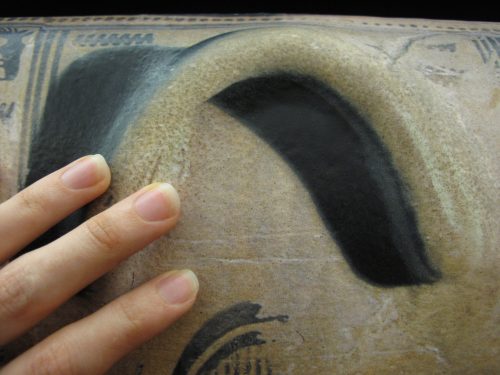
Let’s imagine that these ceramic boards really do survive untarnished for the next two thousand years. What would a future alien visitor then find here, amongst the ruins? It’s a history of Western art, beginning with Ancient Greece and progressing in a dead-straight line through the centuries, before finally landing at Abstract Expressionism and American Pop Art: the grand apotheosis of a three-thousand-year-long narrative. Nothing after 1970 has yet received the Ōtsuka treatment.
Of course, the more expansive any attempt at a total comprehensive overview is, the more its inherent incompleteness will show through. At Ōtsuka the feeling is one of overwhelming excess—it’s the largest museum in Japan and seeing everything means walking for almost four kilometers—as well as alarming omission. For instance, there are hundreds and hundreds of works, but the female artists who have been invited into this grand narrative can be counted on one hand. Initially I thought this would begin to improve, at least a little, as I moved along Ōtsuka’s chronological progression of art from antiquity up to the 1960s—but I found that the only non-male artist who appears in the postwar era is Bridget Riley.
This is a version of art history with no sculpture, no video art, no performance or installation art, no ready-mades—only flat photographically reproduced paintings and some other things that are made to look like flat photographically reproduced paintings. A selection of medieval tapestries and Byzantine mosaics are included, as photographs fired onto ceramic boards—their textures completely flattened out. Stranger still are some Ancient Greek vases which have been photographed from all sides and printed as two-dimensional rectilinear planes, with shadows from the handles included as part of the image surface, indicating their former three-dimensionality. But although everything here depends on photographic technology, this is a history of art in which photographs have never featured as artworks in themselves. The camera is simply a vehicle that transfers images from surface to surface; it does not make its own images.
In Mr. Ōtsuka’s statement about the museum, he proudly announces that visitors can now finally “experience art museums of the world while being in Japan.” But if this is really about increased accessibility, we might wonder why the artworks that are selected for reproduction are already some of the most widely reproduced and accessible images of all time. The museum opened at the turn of the twenty-first century, by which point anybody with an internet connection anywhere in the world would be able to access any of these iconic images, sometimes with resolutions that reveal more detail than our naked eyes could ever see.
As a mode of reproduction, photography invites multiplicity, fragmentation, and circulation. Writing in the 1940s, Malraux observed that the photographic document can liberate the object from its context and hierarchical positioning, as well as from its physical volume and prescribed dimensions.4 But unlike Malraux’s “museum without walls”—and unlike Taschen books or Google Art Project—the Ōtsuka team returns volume, weight, and location-specificity to the mechanically reproduced work of art. They turn dematerialized images back into singular, heavy objects with fixed dimensions and spatial positions, so the images don’t travel to us—we have to travel to them.
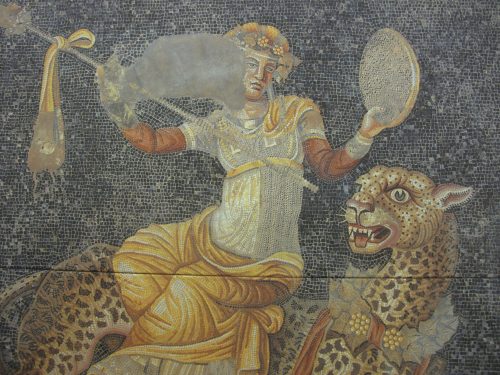
If Ōtsuka’s ceramic board copies actually fulfill the promise of surviving untarnished until the year 4016, they will almost certainly outlive the originals they refer to. More than duplicates, they’re replacements. Their aim is to permanentize pictures and histories that are relatively fragile and transient.
When the Umbria and Marche earthquake struck central Italy in 1997, destroying much of the thirteenth-century frescoes in the Basilica of St. Francis in Assisi, the Ōtsuka team offered to lend their newly acquired photographic versions of the frescos to the Italians, for consultation during the restoration process. The original could then be rendered as a copy of its own copy—and every time its material veers away from what it was, consultation with the allegedly indestructible simulacra can bring it back into line.
There is a broader issue here, which is about finding ways to look at artworks without taming their dynamic and durational capacities. When art historians seek to pin down works of art to a single date of authorial inception, the temporal multiplicity of the work is denied. Likewise, when conservators imagine returning a work to the condition of the “artist’s original intentions,” they fight against the ongoing durations of art objects—objects which always accumulate marks of their historical and material realities.
The Tate Modern’s 2013 retrospective for Saloua Raouda Choucair included an abstract painting that was riddled with holes and had shards of glass sticking out of it, as a result of a bomb going off near the artist’s home during the Lebanese civil wars. She had decided to leave the canvas unrepaired, so it could continue to bear witness to the violence that it had endured. The ruptured abstract composition thus took on a direct indexical relation with the external world. The picture pointed not just to a moment of artistic creation in the past, but also to what it had been through since then—so its temporality extended beyond the initial instance of creative authorship.
But the Ōtsuka Museum of Art is founded on an attempt to deny the passage of time. There is no past here, since nothing passes away and all the scars of history can be covered up, and there is no futurity, since there is no space for contingency or chance. In this archive there is only the relentless, permanentized present, preempting any alternate future, replacing everything else with itself, enforcing more of the same forever.
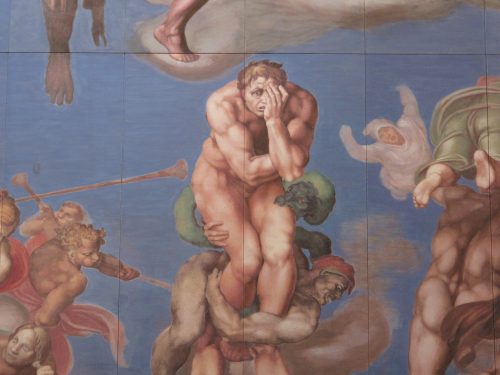
Adorno observed that the words “museum” and “mausoleum” are “connected by more than phonetic association.” The German word “museal” (museum-like), he wrote, “describes objects to which the observer no longer has a vital relationship and which are in the process of dying.” Such objects go to the museum when they are ready to withdraw from life. In Adorno’s words, “They owe their preservation more to historical respect than to the needs of the present.”5 But is there not also potential for strategies of reactivation within the museum-mausoleum? Can’t we try to think about ways of setting its contents in motion, in accordance with the needs of the present?
As I was struggling to find my way out of the Ōtsuka Museum of Art, I started to become more aware of the seams that run through its pictures. Because the fired ceramic boards can only be produced up to a certain size, any larger surfaces have to be pieced together from separate plates. As a result, many of the pictures feature strange disjunctive grooves, which remind us of their base materiality.
The more I focus on these caesurae, the more the museum’s myth of solidity and clean continuity is disturbed. The hyper-durability of the baked ceramic plates comes with a compromise of surface interruption, and it is in the surface interruptions that we find evidence of the gaps that run through all versions of history—even and perhaps especially those that present themselves as watertight. Looking at the spaces in between the pieces—spaces we are not supposed to look at—I wonder what potentiality lies there. What leakages might pass through these openings? And how can the visible seams be taken up as an invitation to rearrange the contents of the archive?
Certainly, the Ōtsuka Museum of Art is a corporate vanity project, which presents its reactionary version of art history as something conclusive and unchanging. It fetishizes individual (white male) genius, perpetuates simplistic progress narratives, costs too much money, takes up too much space, and fails to properly deal with the temporality of the art that it cares for. But which of our major art institutions are exempt from such criticisms? In its excessive permanence and false totality, Ōtsuka is simply reproducing the problems encountered in contemporary museological, art historical, and preservation practices more generally. In this respect, the Ōtsuka Museum could also be considered the most elaborate work of institutional critique ever attempted.

Still trying to find the exit, I stumble into a darkened room with reproductions of Goya’s Black Paintings, and I stop in front of Saturn Devouring His Son. It’s a truly appalling image: a naked, cowering old man with bulging eyes looking right back at us, and a half-eaten child clenched in his knuckly fists.
Saturn is the Romanization of Cronus, the Greek god of time whose image later morphed and amalgamated into the bearded, scythe-carrying old man known as Father Time. The myth of Cronus tells us that he had castrated and overthrown his own father, and so he was terrified that one of his children would one day do the same to him. To prevent this from happening he would consume them as soon as they left their mother’s womb.
The paranoid patriarch struggles to hold on to his position of power by desperately suppressing all futurity. He devours everything that could come after him, in a precautionary measure against the inevitability of change. This is an image of time that exists only as a perpetual, cannibalistic present, preemptively replacing any alternative with itself. There’s no real future in this version of time, since there is no indeterminacy, no contingency—only prediction and subsumption.
But Cronus’s struggle is ultimately futile—and somehow in Goya’s depiction he seems to know it. Rhea—who is Cronus’s wife, and sister—eventually makes a plan with Gaia, their mother. When Rhea gives birth to the sixth child, Zeus, the women hide the baby away—and they later force Cronus to disgorge the contents of his stomach, so that one by one the other infants are vomited back to life.
Here we are reminded that the future is not just something “in the distance” that we identify and move toward in a linear fashion; it can be unrealized potentiality that is already present, but suppressed. This futurity can be swallowed and withheld—but then it can be spewed up and redistributed. By intervening in Father Time’s system of control, it is the mothers in this myth who can restore the future’s messy indeterminacy.
An earlier version of this text is published in the book ‘La vie et la mort des œuvres d’art / The Life and Death of Works of Art’, edited by Christophe Lemaitre and published by Tombolo Presses, France, 2016 (in English with French translation).
Subsequently republished in e-flux journal #78, 2016 – see here.
Also republished, and translated into Dutch, for the book Pense-Bête, published by P/////AKT Amsterdam in April 2017 – see here.

